
FINE ANTIQUE ENGLISH FURNITURE
FINE ANTIQUE ENGLISH FURNITURE
FINE ANTIQUE ENGLISH FURNITURE
GREAT ENGLISH FURNITURE






FINE ANTIQUE ENGLISH FURNITURE
FINE ANTIQUE ENGLISH FURNITURE
FINE ANTIQUE ENGLISH FURNITURE
GREAT ENGLISH FURNITURE




FINE ANTIQUE ENGLISH FURNITURE
GREAT ENGLISH FURNITURE
RONALD PHILLIPS LTD.
RONALD PHILLIPS LTD.
26 BRUTON STREET, LONDON W1J 6QL
26 BRUTON STREET, LONDON W1J 6QL
Tel: + 44 (0)20 7493 2341 www.ronaldphillipsantiques.co.uk advice@ronaldphillips.co.uk
Tel: + 44 (0)20 7493 2341 www.ronaldphillipsantiques.com advice@ronaldphillips.co.uk
The last year has been extremely busy and as a result it has gone by very quickly. I can hardly believe we have been able to include so many fresh items in this new catalogue. Very few items are repeated here, and then only because we have owned them previously.
We have again been fortunate to buy many of these items privately, and some have not been on the market for forty or fifty years.
I have a few particular favourites among those featured here. Among them are the heavily carved and documented bookcase belonging to Henry Percy Dean on page 7, which is probably one of the best in the world, the St. Giles suite on page 254, which is iconic (and to have a pair of settees is just extraordinary), the stunning Esmond Bradley Martin painted table on page 261, the pair of japanned top gilt tables on page 52 on account of their rare small size, and finally the carved revolving cheese stand on page 43, which we sold a few years ago and which has always been a firm favourite: it is like a piece of sculpture rather than furniture.
As well as being hard at work acquiring these wonderful pieces, we have also been busy at the major international fairs. We participated in the inaugural Treasure House Fair at the Royal Hospital Chelsea in London in June 2023, Frieze Masters in Regent’s Park, London, in October 2023, and the Winter Show in New York in January 2024.
As always, I would like to thank all my staff for their hard work, dedication and loyalty. Without all of them this production would not be possible.
We look forward to seeing you at the next Treasure House Fair in London from 27 June to 2 July.
Please feel free to call me on + 44 (0)20 7493 2341 or email simon@ronaldphillips.co.uk for more information about the items in this catalogue, or if you have any requests.
Very best wishes,
May 2024
 Simon Phillips
Right: Simon Phillips with Truffle
Simon Phillips
Right: Simon Phillips with Truffle

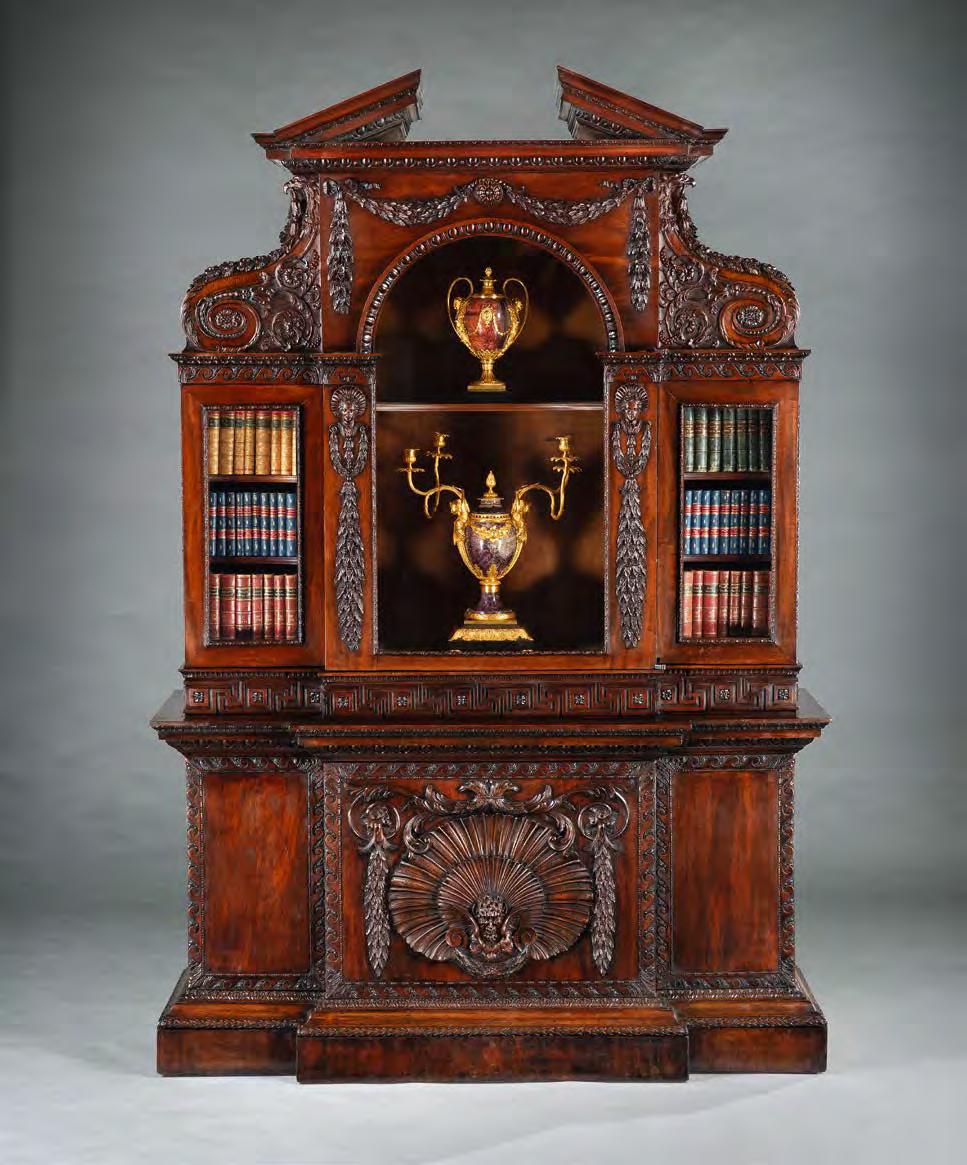


The cabinet illustrated in Percy Macquoid, A History of English Furniture, vol. III, ‘The Age of Mahogany’, 1906, p. 116, fig. 98
A GEORGE II MAHOGANY BREAKFRONT CABINET ATTRIBUTED TO WILLIAM HALLETT, THE DESIGN TO WILLIAM KENT
English, circa 1740
Height: 8 ft 2 in; 249 cm
Width: 5 ft 7 in; 170.5 cm
Depth: 1 ft 10 in; 56 cm
Provenance:
Henry Percy Dean (1864–1931), probably for 69 Harley Street, London, until 1906; Transferred to Bridgefoot House, Iver, Buckinghamshire, 1906, until June 1909;
Christie’s, London, ‘The Collection of Old English Furniture of H. P. Dean Esq.’, 14 June 1909, lot 21, 750 guineas (£787 10s); Partridge, Lewis & Simmons, London, England; Transferred to Plaza Hotel, New York, USA, 1910; Private collection, USA; Private collection, London, England; Collection of Mr. and Mrs. James Warburg, Greenwich, Connecticut, USA.
Illustrated:
Percy Macquoid, A History of English Furniture, vol. III, ‘The Age of Mahogany’, 1906, pp.116–117, figs. 98–99 (H. Percy Dean Collection).
Partridge, Lewis & Simmons, ‘The Furniture of Thomas Chippendale’, catalogue, 1910, for the exhibition held at Plaza Hotel, 9th floor, New York, USA, item no. 1.
Literature:
The Times, 15 June 1909, p. 12.
The Times, 19 June 1909, p. 14.
Country Life, 12 March 1921, p. LXXXVI, fig. 4.
Percy Macquoid and Ralph Edwards, The Dictionary of English Furniture (revised edition), 1954, p. 180, fig. 32.
This masterly carved cabinet has many hidden features. Its numerous drawers and secret compartments are all operated by a single key, which must be used in different ways depending on the lock to be opened. Without being unduly technical, the key operates on the push as well as on the pull, and some locks require a second turn, when the key sinks deeper than before.


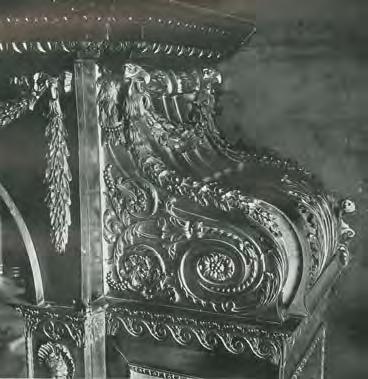
Detail of the carved volute concealing a drawer, in Percy Macquoid, A History of English Furniture, vol. III, ‘The Age of Mahogany’, 1906, p. 117, fig. 99
Every possible space has been used: for example, the carved volutes pull out sideways to reveal drawers, the stepped moulding separating the upper and lower sections of the cabinet contains drawers and slides, and the plinth base forms a single large drawer. The lower section is more conventionally fitted with four small drawers to each side and four large drawers in the centre, but here again secret compartments are hidden either behind or below the drawers. In addition, both doors are fitted with wire retainers for an apothecary.
The glazed upper section contains two shaped shelves in the centre, which must have been used for display purposes, as they would have been impractical otherwise.
The locks, hinges and all other metalwork had to be made specifically for the cabinet and would have been extremely costly.
The cabinet is without doubt from a London workshop, and the quality of the carving suggests William Hallett. William Vile was his apprentice, but the date of the cabinet supports attribution to Hallett. Hallett worked at Rousham House in Oxfordshire, Holkham Hall in Norfolk and Ditchley Park in Oxfordshire, as well as for the Royal Family. The accounts at Uppark, Sussex, include an entry for 27 March 1754: ‘Pd Mr Hallett for a cabinet £43 5s 0d’. This huge amount for a cabinet would allow for the expensive metalwork, but the date is slightly too late for the current example. Further research may one day reveal for whom this extraordinary cabinet was made.
A very similar cabinet with identical outline, but in black lacquer and japanned elsewhere, remains in the collection at Milton Hall, Peterborough.
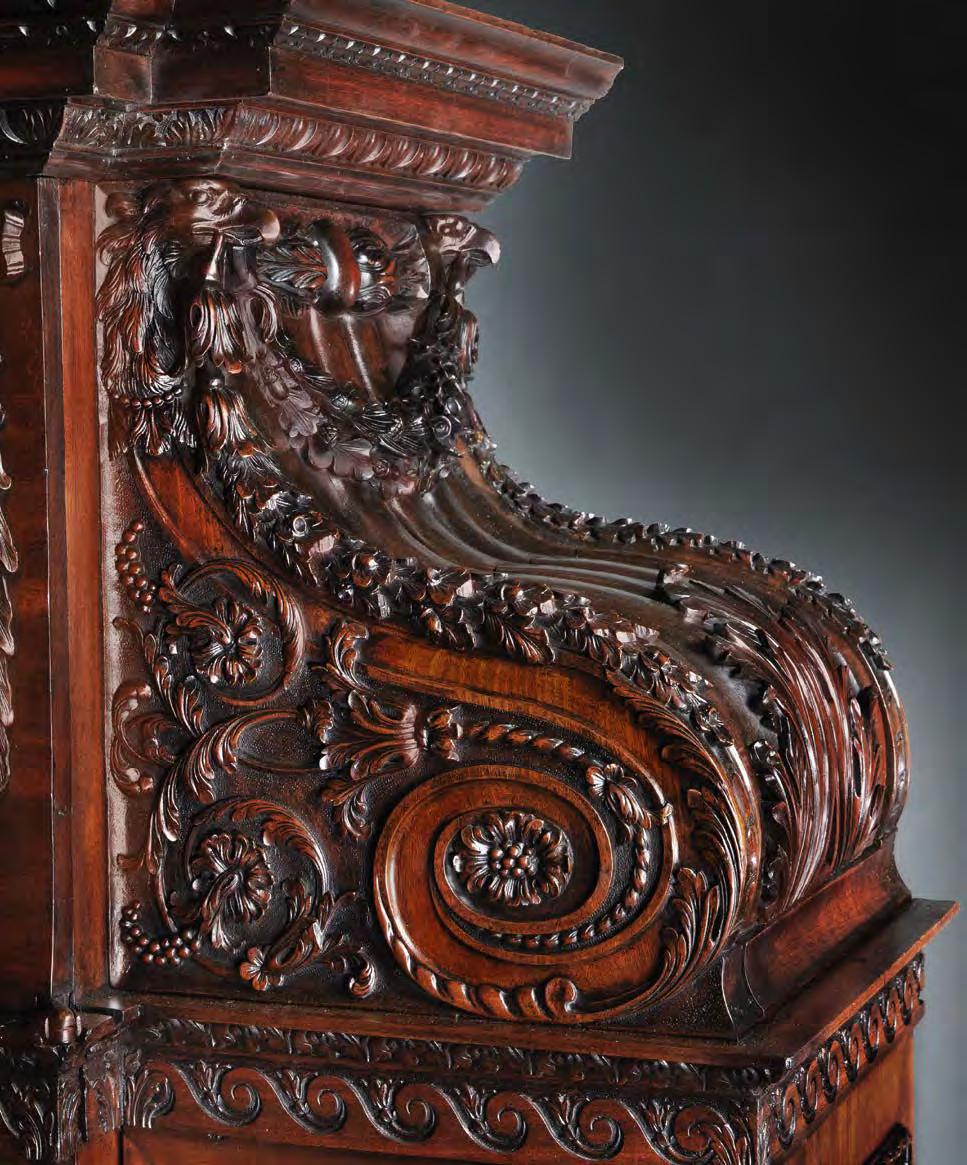
2
English, circa 1790
Height: 47 in; 119.5 cm
Diameter: 27 in; 68 cm
Provenance: Hotspur Antiques Ltd., London, England; Private collection, England.
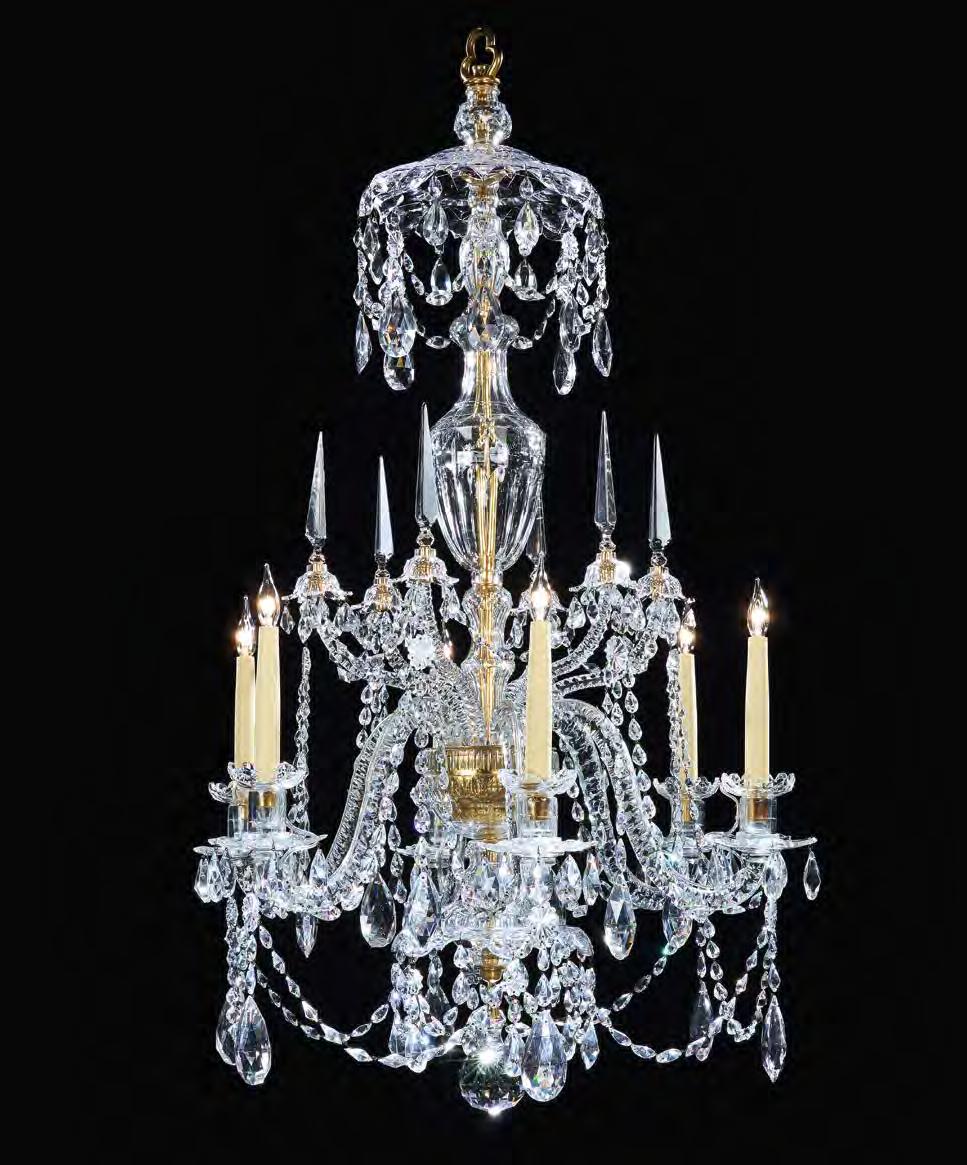
Note: The marble tops are of later date. The terms retain most of the original gilding.
English, circa 1735
Height: 50¾ in; 129 cm
Width: 15 in; 38 cm
Depth: 15 in; 38 cm
Provenance: William Stanhope, 2nd Earl of Harrington, for Elvaston Castle, Derbyshire, England; By descent until 1963; Mallett & Son Ltd., London, England; Private collection, England.
Illustrated:
Watercolour of the staircase at Elvaston Castle by Rebecca Dulcibella Orpen Ferrers, 1857, © National Trust/Claire Reeves. Country Life, Sotheby’s advertisement for the forthcoming sale at Elvaston Castle, 24 October 1963, supplement 31.
Literature:
Parke-Bernet Galleries, ‘The Walter P. Chrysler Collection of English Furniture, Part II’, sale catalogue, New York, 29–30 April 1960, p. 125, lot 526.
Sotheby’s, ‘Important English Furniture, Carpets and Rugs’, sale catalogue, 8 November 1963, p. 45, lot 167.
Desmond Fitzgerald, Georgian Furniture, 1969, item 28.
Susan Weber, William Kent: Designing Georgian Britain, 2014, p. 156, fig. 6.9.
These extraordinary pedestal terms belong to a small group of pedestals all featuring conical square bodies with naturalistic human heads – in the case of the set to which this pair belong, children’s heads –supporting a column capital. The design of this group is generally ascribed to William Kent.
There are known commissions for pedestal terms in this group for Rousham House in Oxfordshire, Rainham Hall in Essex, the Royal Collection for the White House at Kew in Middlesex and Hampton Court in Surrey, Devonshire House and Chiswick House in London, and lastly Elvaston Castle, where the current pedestals, commissioned by William Stanhope, 2nd Earl of Harrington, originate.
This pair were originally part of a set of eight. Four pedestals can be seen in situ on a staircase landing at Elvaston in a 19th century watercolour painting, each one supporting a white bust.
Two pedestals from the Stanhope set were sold from the Chrysler Collection in 1960, and another pair from the set were acquired by the Victoria and Albert Museum in 1962 as part of the C. D. Roth bequest. The remaining four (two of which are the current pair) were sold directly by the order of the Earl of Harrington together with the remaining contents of Elvaston Castle in 1963. In this sale, held by Sotheby’s, the set of four pedestals were sold together as lot 167. The preceding two lots, 165 and 166, were also pedestal terms, but of slightly different design, featuring heads of women or older girls rather than of children as in the set of eight.
The pedestals from the Roth Collection and the Chrysler Collection had evidently left Elvaston Castle some years before the Sotheby’s sale.
The similarities between the Royal set for Kew and Hampton Court and the Stanhope set are striking. Even more intriguing is that within both sets each head is different, suggesting that they were modelled on actual people, whereas a generic head would surely have been copied and repeated as many times as needed. Their identities are unfortunately unknown, but further research may eventually reveal them.
A related pair of giltwood tables designed by William Kent for Lord Burlington’s villa at Chiswick also feature a child’s head. A sketch by Kent of Lord Burlington’s daughter, Dorothy, drawn within a column capital, is the design basis for these two tables, one of which is in the collection of the Victoria and Albert Museum in London.




A GEORGE III PAINTED MIRROR ATTRIBUTED TO JOHN LINNELL
Note: The mirror retains much of the original paint surface. The mirror plates are of later date.
English, circa 1760
Height: 9 ft; 274.5 cm
Width: 5 ft 4 in; 163 cm
Depth: 7½ in; 19 cm
Provenance:
J . Goldman, Château de la Croix des Gardes, Côte d’Azur, France; Private collection, Paris, France.
J. Goldman was the founder of the luxury jewellery brand Burma. He engaged Tom Parr of Colefax & Fowler to decorate his impressive mansion nestled in the mountains above Cannes.
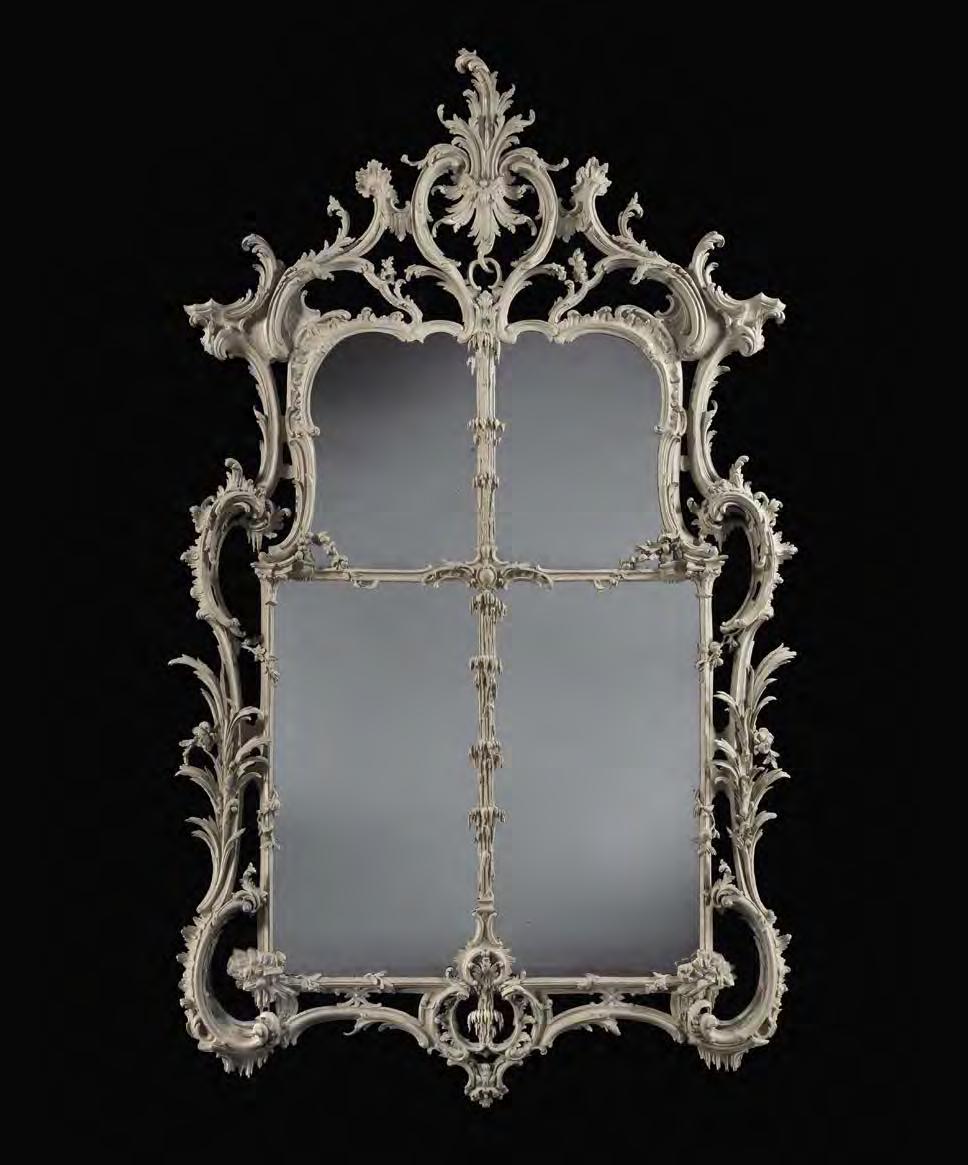

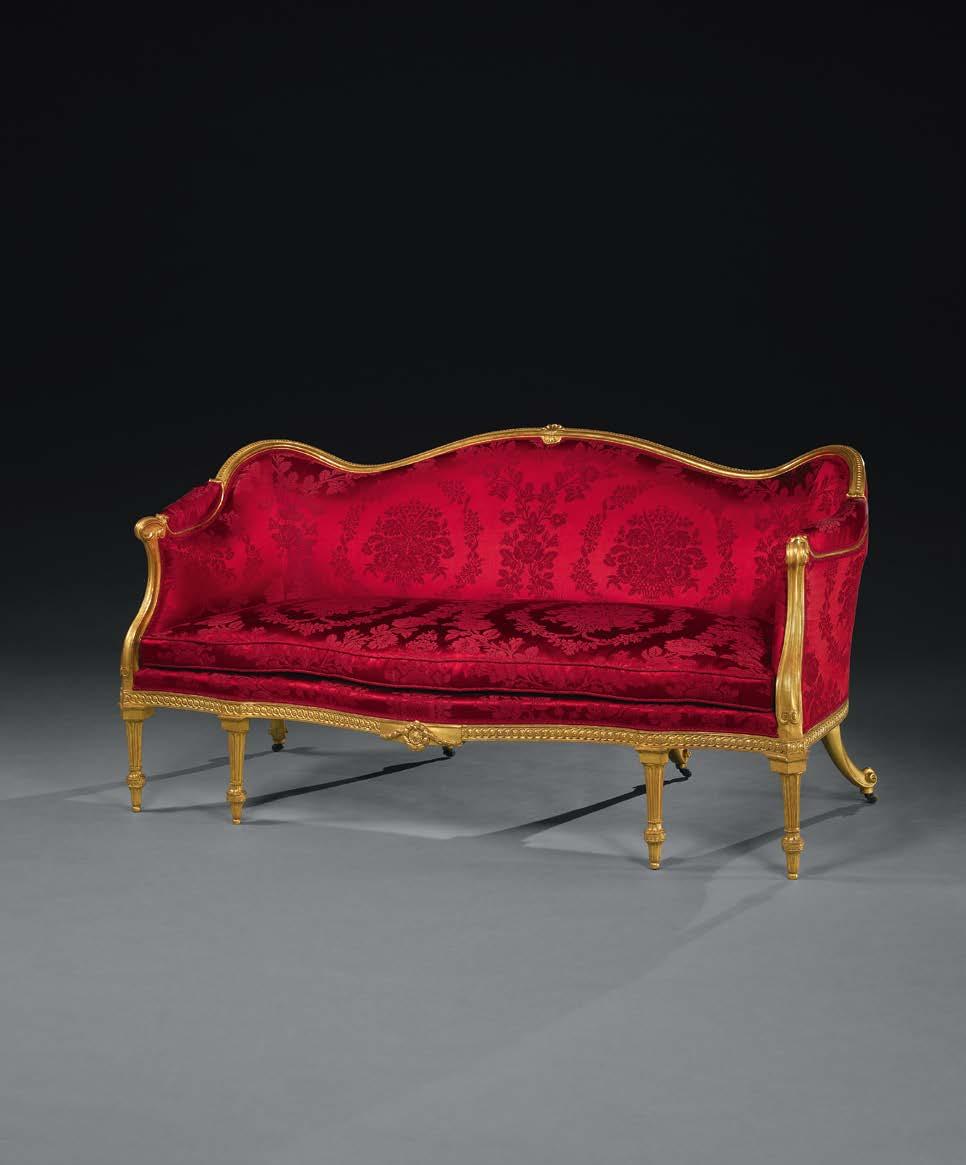
Note: The settees have been re-gilded. English, circa 1780
Height: 2 ft 10½ in; 87.5 cm
Height of seat: 1 ft 8 in; 50.5 cm
Width: 5 ft 7½ in; 171 cm
Depth: 2 ft 9 in; 84 cm
Provenance:
M. Harris & Sons Ltd., London, England; J. Kugel, Paris, France; Sotheby’s, London, 9 March 1961; J. A. Pearson; Private collection, Lancashire, England.
Literature: Judith Goodison, The Life and Work of Thomas Chippendale Junior, 2017, p. 135.
The overall design of the settees corresponds to the output of Chippendale’s workshop. The sinuous curve of the backs and the serpentine fronts as well as the exceptionally high quality of the carving indicate a leading London cabinet-maker, while the anthemion cresting, husk carved tablet, typical scroll arm finial and blocked tapering legs with finely leaf carved toes and clamping notches leave no doubt about their authorship.
During conservation a reduction in the height of the back frame was noted. Alterations of this kind to furniture were not uncommon. An alteration carried out by Chippendale to a ‘sofa’ is recorded in the Harewood House archive:
1797, Feb. 7, Altering your large Sofa by lowering the Back and making the Seat Shallower, finishing Do in burnish’d Gold and White, double stuffing in fine Linen in the French manner, with a Squab, 3 back Cushions, border’d &0 2 Bolsters covering with your Blue Stripe Taberay and finishing with Blue Silk Gimp and Silk Cord £15 12 –
The Harewood sofa would have been part of a suite of furniture from Harewood House in London, which was bought by Edwin Lascelles from the Duke of Roxburgh in 1795. The house was partially furnished at the time of purchase, and the sofa may have been acquired with it. A new room layout with tall paintings on the walls perhaps made it necessary to lower the back of the sofa.
Surface analysis of the backs and the rest of the frames revealed that all surface layers of the various treatments and later decorations were present in all samples. The first, original layer, which was present in the back and the rest of the frame, is decisive in dating the alteration. Its presence on the altered parts indicates that the height of the settees was reduced before they were first decorated, and the alteration is for that reason deemed original to them.


6
A GEORGE II MAHOGANY TILT-TOP PIE-CRUST TABLE
English, circa 1755
Height: 28½ in; 72.5 cm
Width of top: 25¼ in; 64 cm
Depth of top: 21¾ in; 55.5 cm
Provenance: Arthur Leidesdorf, New York, USA; French & Company, New York, USA; Private collection, USA; Private collection, England.
Tripod tables with square or oblong tops are rare, and especially so when they feature pie-crust edging.


AN EXTREMELY SHALLOW GEORGE III ORMOLU MOUNTED HAREWOOD MARQUETRY COMMODE IN THE MANNER OF CHRISTOPHER FUHRLOHG
Note: The commode retains the original mounts and is fitted with a single fixed shelf behind each door.
English, circa 1780
Height: 32½ in; 82.5 cm
Width: 47½ in; 120.5 cm
Depth: 15¾ in; 40.5 cm
Provenance:
Private collection, London, England.
The outline of the commode follows French and later English examples by Jean Henri Riesener, Georg Haupt and Christopher Fuhrlohg. The use of fine ormolu mounts and marquetry inlay using classical figures became fashionable in the last quarter of the 18th century.


 The table in situ in the drawing room at Sutton Place, Antique Collector, April 1961, p. 48
The table in situ in the drawing room at Sutton Place, Antique Collector, April 1961, p. 48


A GEORGE II GREY PAINTED CONSOLE TABLE
Note: The table retains much of the original paint surface and the original marble top. The pendent swag carvings to the front corners are restorations.
English, circa 1735
Height: 33½ in; 85 cm
Width: 36 in; 91.5 cm
Depth: 22 in; 56 cm
Provenance:
William More Molyneux (1690–1760), Loseley Park, Surrey, England; By descent until; John Paul Getty, Sutton Place, Surrey, England; Robert Norman Hepple, RA, RP.
A pair of tables with identical carvings and identical marble tops remain in the collection of the More Molyneux family at Loseley Park in Surrey.
Illustrated: ‘Sutton Place, the 16th century residence in Surrey of Mr. J. Paul Getty’, Antique Collector, April 1961, p. 48; illustrated in the drawing room.

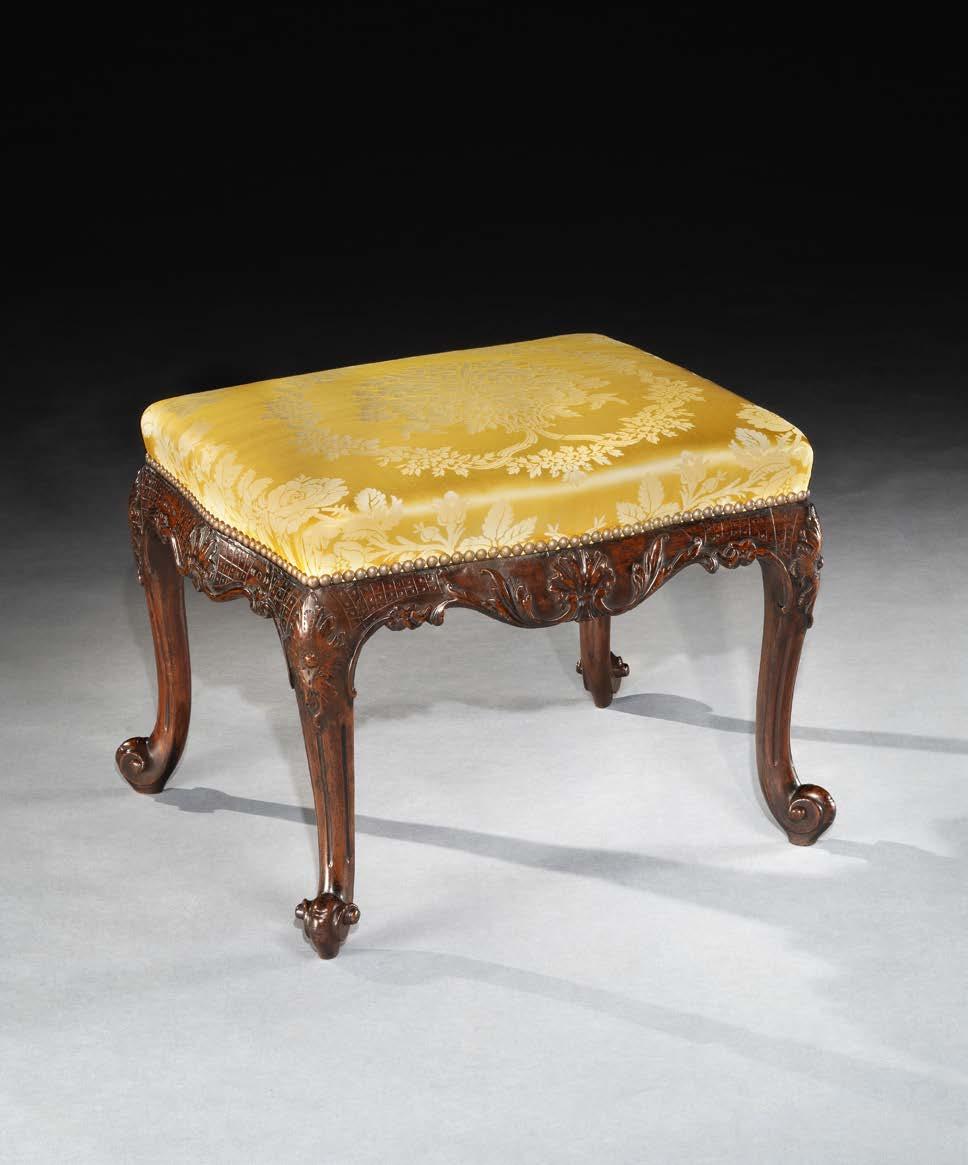
English, circa 1750
Height: 17½ in; 44.5 cm
Width: 22¾ in; 58 cm
Depth: 18½ in; 47 cm

A related pair of stools, formerly in the collection of Edward James at West Dean, Sussex, England, and now in the celebrated Gerstenfeld Collection in Washington, DC, USA, share some features. A further related pair of stools were formerly in the Moller Collection.

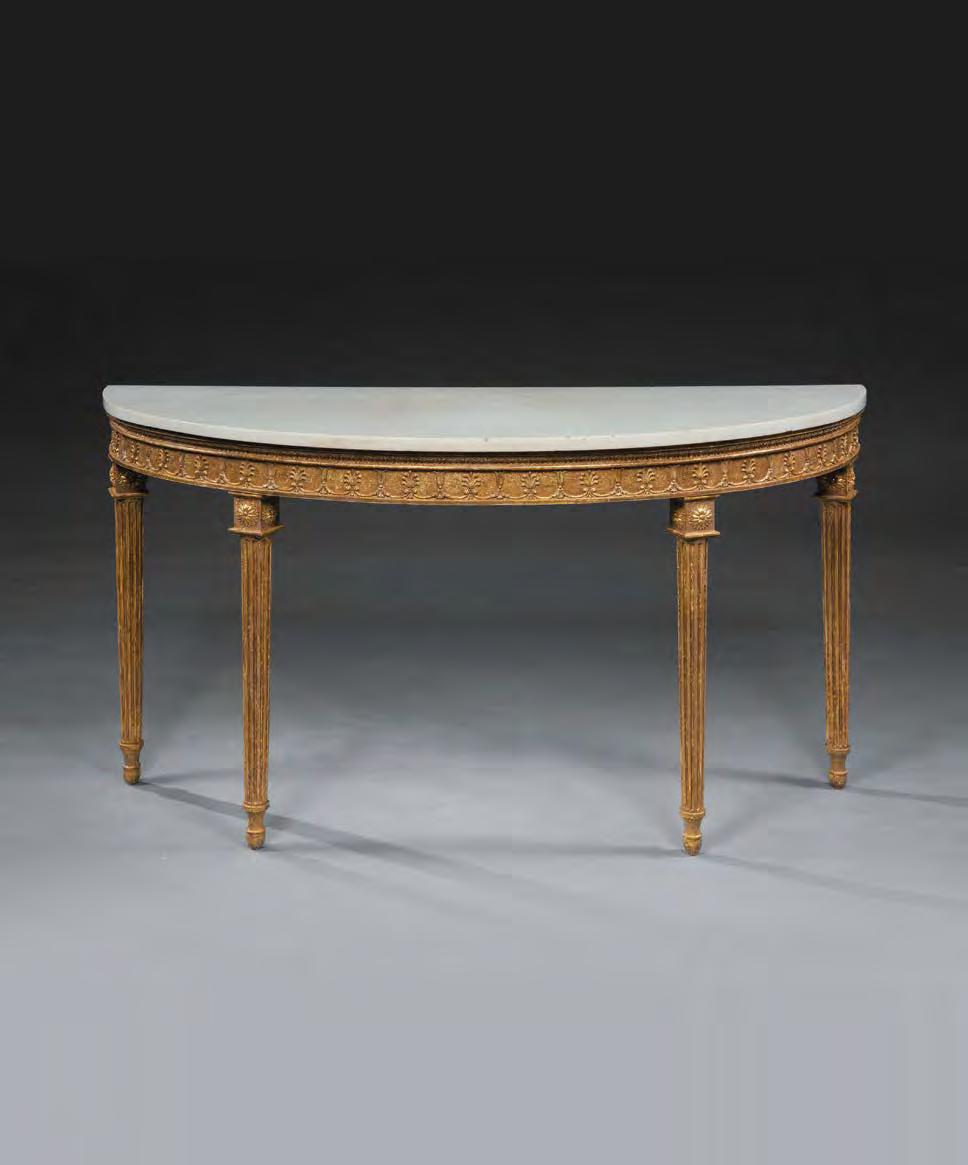


Design drawing and sketch by Robert Adam for tables of similar design. Copyright Sir John Soane’s Museum, London
10
A PAIR OF GEORGE III GILTWOOD DEMI-LUNE SIDE TABLES DESIGNED BY ROBERT ADAM
Note: The tables retain their original white marble tops and much of the original gilding. English, 1768
Height: 2 ft 10¾ in; 88.5 cm
Width: 5 ft 4½ in; 164 cm
Depth: 2 ft 1½ in; 65 cm
Provenance: William Petty Fitzmaurice, 1st Marquess of Lansdowne, 2nd Earl of Shelburne (1737–1805), for Lansdowne House, Berkeley Square, London, England; The Hon. Mrs. Audrey Pleydell-Bouverie, Julians Park, Hertfordshire, England.
William Petty was the British prime minister from 1782 to 1783. He acquired the unfinished Lansdowne House in 1765 and completed the building over the following three years with the help of Robert Adam.
A sketch drawing for a table and a design drawing for a table, both by Adam, with the design drawing dated 1768, are in the collection of the Sir John Soane’s Museum, London. Both drawings relate closely to this pair of tables.



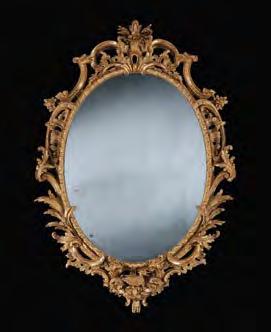

A PAIR OF GEORGE III GILTWOOD OVAL MIRRORS ATTRIBUTED TO RICHARD CRANFIELD
Note: The mirrors retain much of the original gilding and the original mirror plates. The top cresting has been restored. Irish, circa 1765
Height: 47½ in; 121 cm
Width: 33¾ in; 86 cm
Provenance:
The Hon. Ernest Guinness and Mrs. Guinness, Luggala, Leinster, Ireland; Presented to His Royal Highness Prince Henry, Duke of Gloucester, and Her Royal Highness Princess Alice, Duchess of Gloucester, at their wedding in 1935, and later installed at Barnwell Manor, Northamptonshire, England.
Illustrated:
Country Life, 28 August 1942, frontispiece.
Christopher Hussey, ‘Barnwell Manor, Northamptonshire II’, Country Life, 17 September 1959, p. 301, fig. 11.
Literature:
The Knight of Glin and James Peill, Irish Furniture, 2007, pp. 128–40.
Richard Cranfield’s carved work stands out amongst that of other Irish carvers. Frames carved by his contemporaries such as John and Francis Booker, and even James Robinson, with whom Cranfield worked on numerous occasions, appear relatively sparsely designed in comparison. Cranfield’s designs are bold and confident and full of well-balanced ornamentation, with crisp and exceptionally fine carving. Cranfield also includes some distinctively Irish elements such as the gadrooned borders on the frames, which run in opposite directions on the two mirrors.

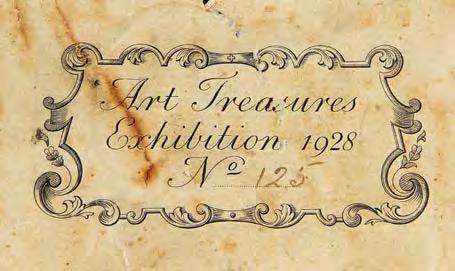
The paper label found on the underside of the cheese stand
12
English, circa 1755
Height: 8 in; 20 cm
Width: 21¼ in; 54 cm
Depth: 12 in; 30.5 cm
Provenance: Leonard Partridge, London, England; By descent to Marie Partridge, England; By descent to Susan Partridge, London, England; Ronald Phillips Ltd., London, England; Private collection, Germany.
Exhibited: Art Treasures Exhibition, London, 1928, exhibit no. 125.
The stand has acquired an outstanding colour and patination, and retains a paper label for the Art Treasures Exhibition of 1928, exhibit no. 125.

A
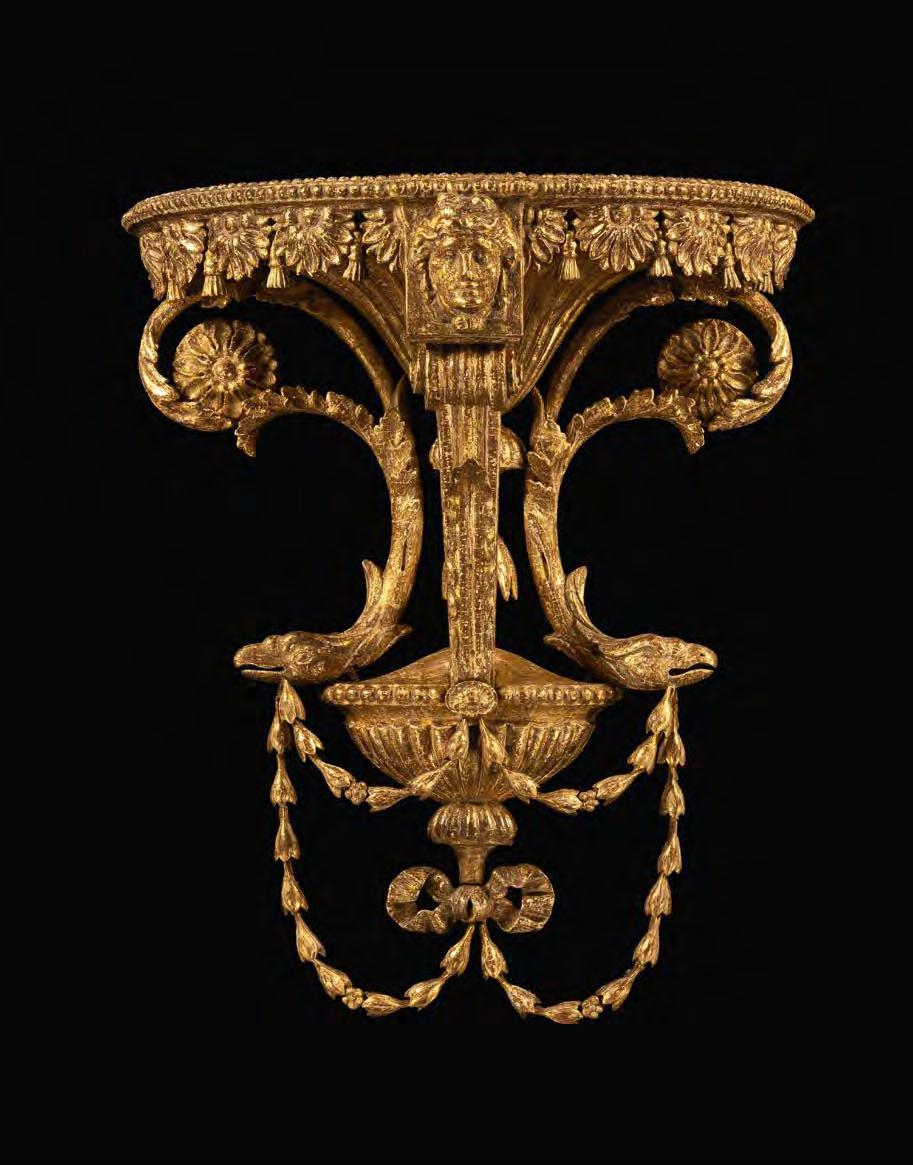
Note: The brackets retain some of the original gilding.
English, circa 1780
Height: 19½ in; 49.5 cm
Width: 16½ in; 42 cm
Depth: 8 in; 20 cm
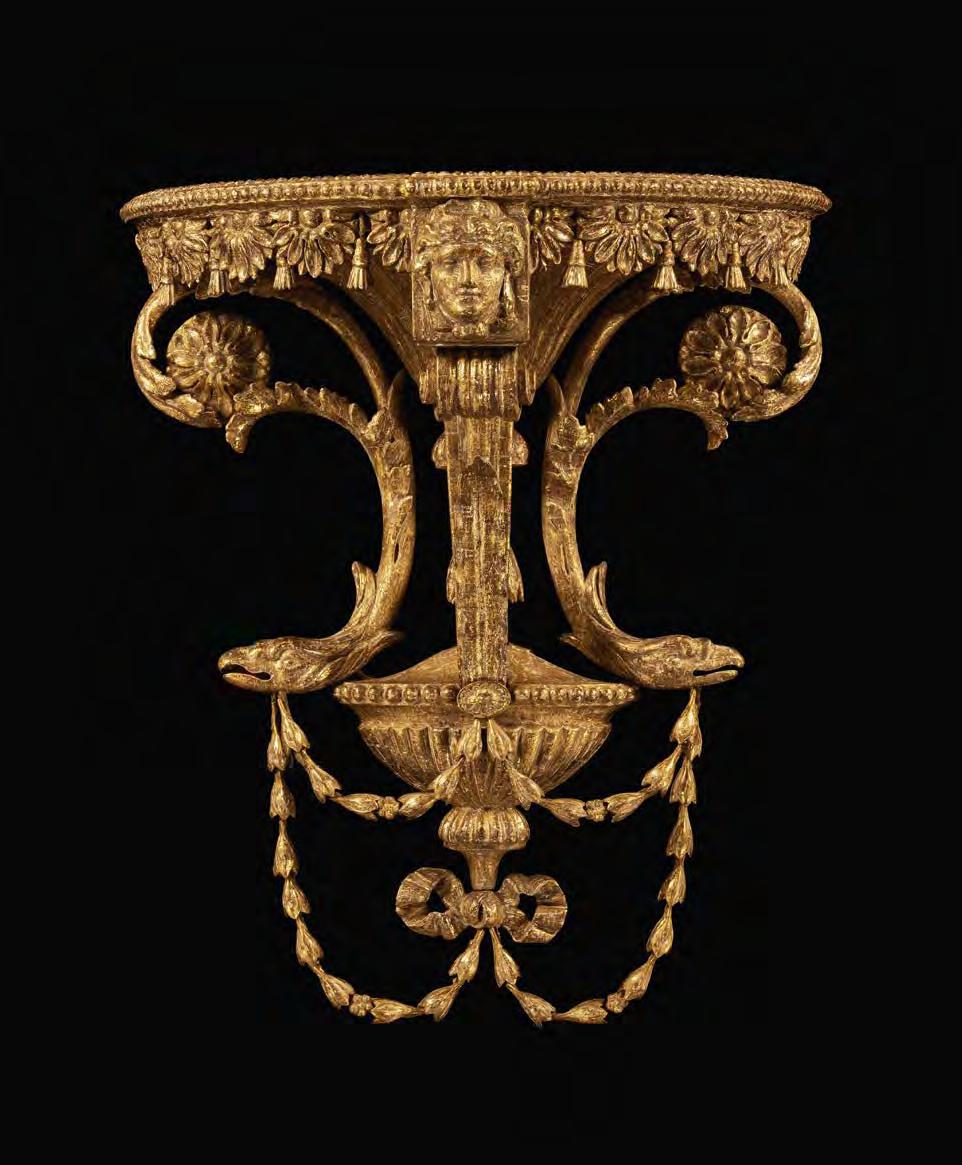
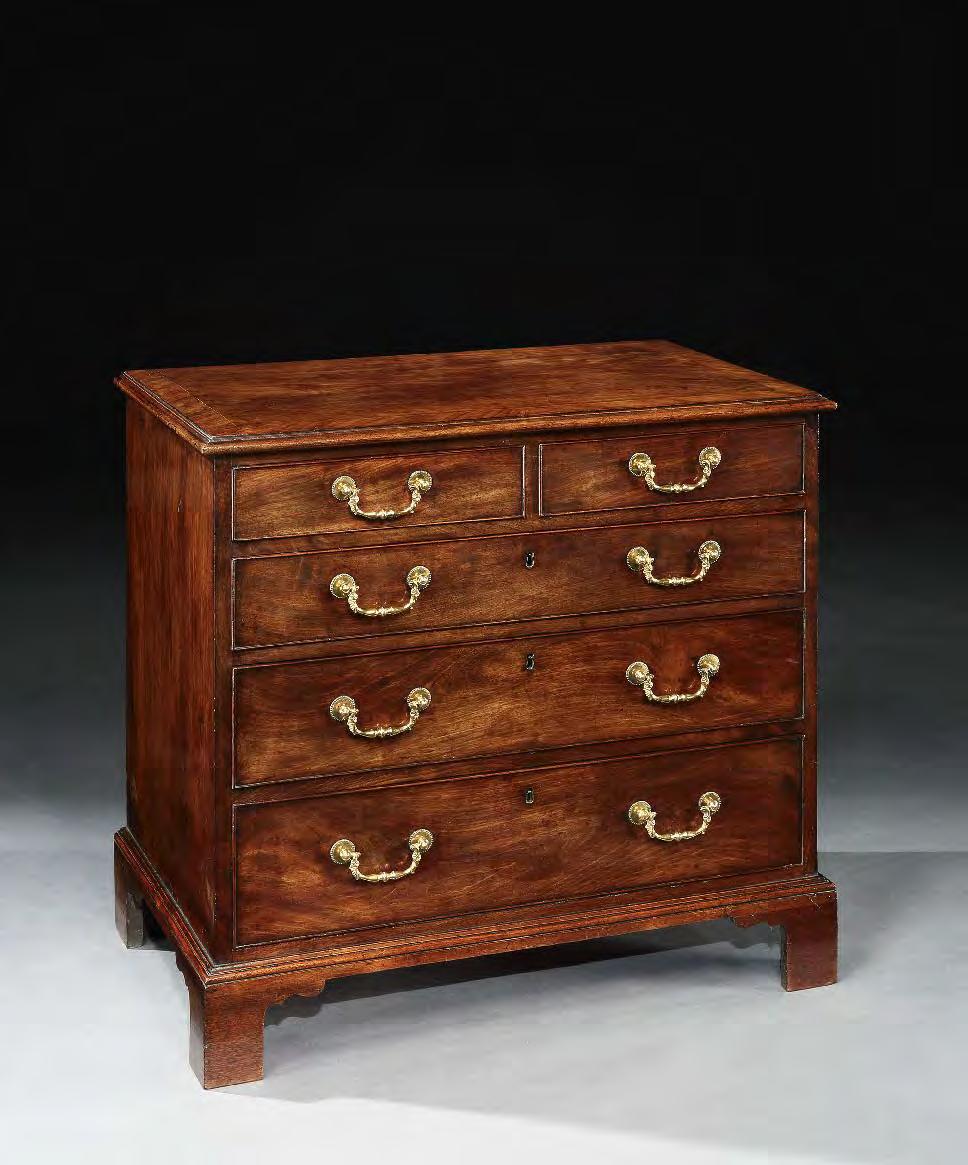
A PAIR OF GEORGE II MAHOGANY AND GONCALO ALVES CROSSBANDED CHESTS OF DRAWERS
Note: One chest has restored back feet. The drawers retain all their original brass handles and escutcheons.
English, circa 1755
Height: 31½ in; 80 cm
Width: 33½ in; 85.5 cm
Depth: 20 in; 50.5 cm
Provenance: Mallett & Son Ltd., London, England; Private collection, England.




Note: The frames have been re-gilded. One girandole has an ivorine label on the reverse for Jeremy Ltd., Kings Road, London. English, circa 1780
Height: 47¾ in; 121 cm
Width: 23½ in; 59.5 cm
Depth: 10 in; 25.5 cm
Provenance: Jeremy Ltd., London, England; Private collection, London, England.

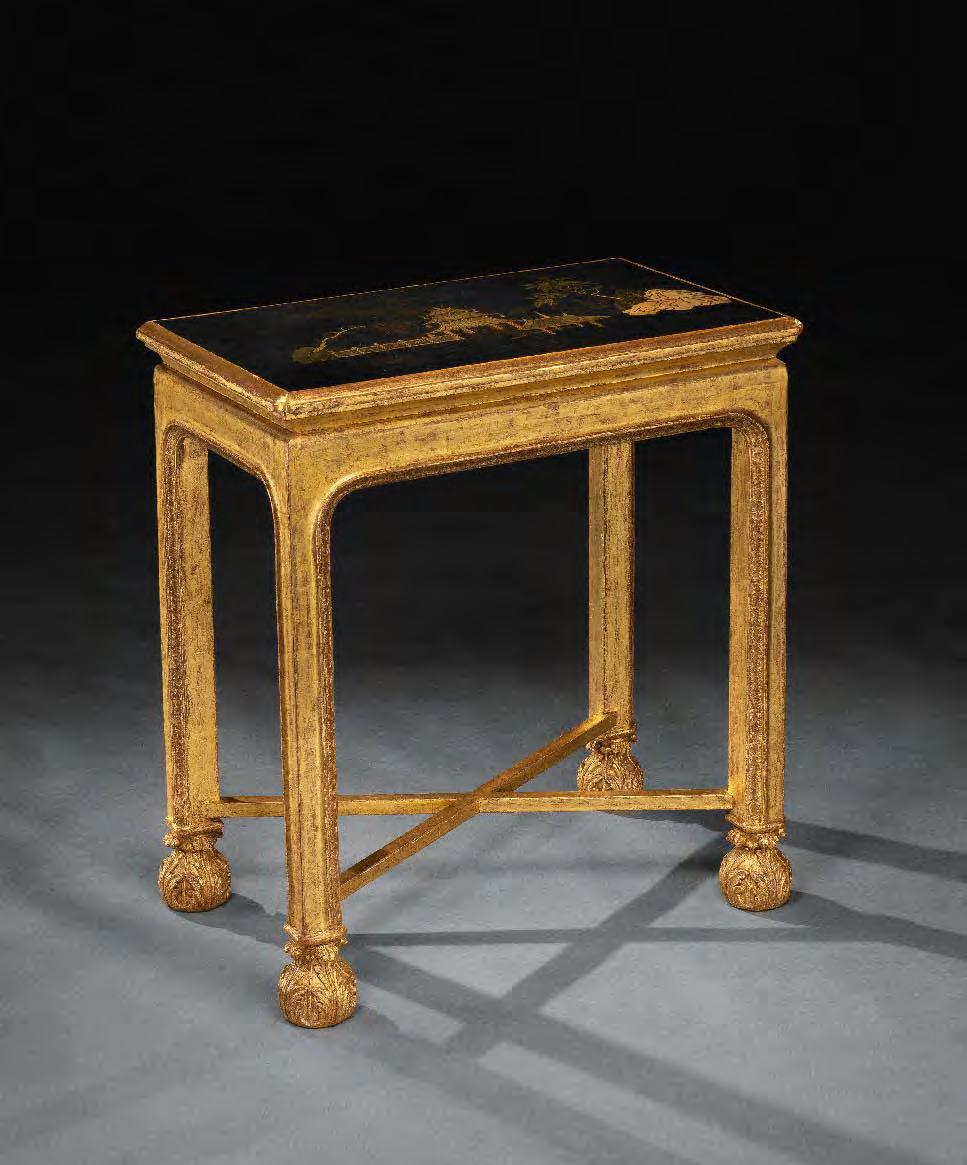


A PAIR OF GEORGE I GILTWOOD SIDE TABLES WITH BLACK JAPANNED TOPS, ATTRIBUTED TO JAMES MOORE OR BENJAMIN GOODISON
Note: The tables retain much of the original gilding. The carved bulbous toes as well as the X-frame stretchers are original. The black japanned tops have been restored.
The bases: English, circa 1725
The japanned tops: English, circa 1685
Height: 30½ in; 77 cm
Width: 27 in; 68.5 cm
Depth: 16½ in; 42 cm
Provenance: Private collection, England.
These tables belong to a select group of tables and stands for cabinets which are either documented or associated with the work of James Moore and his apprentice Benjamin Goodison. On Moore’s death in 1726, Goodison took over many of his former master’s commissions, and for that reason it is virtually impossible to distinguish between the two men’s work. These tables are extremely rare examples, as firstly they are particularly small, and secondly the japanned tops are very early.
Several examples of table frames of this type are known. Some are in the Royal Collection, including one incised ‘MOORE’ in the carved gesso top, and others are at various locations including Chatsworth House in Derbyshire, Houghton Hall in Norfolk and Blenheim Palace in Oxfordshire. All share the same distinctive features, of square-section legs joined seamlessly to the top frame and terminating in bulbous carved toes, strengthened by relatively plain cross stretchers, with the only carved decoration apart from the toes being a quadrant moulding running along the inside of the legs and frame. The remaining areas are left very plain.


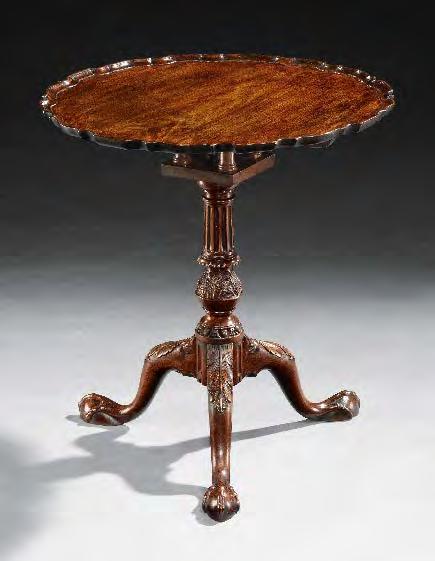
A GEORGE II MAHOGANY TRIPOD TABLE
Note: The table has acquired a fine mellow patina. The pie-crust top rotates on a birdcage action.
English, circa 1750
Height: 28½ in; 72.5 cm
Diameter: 26½ in; 67.5 cm
Provenance: Private collection, England.
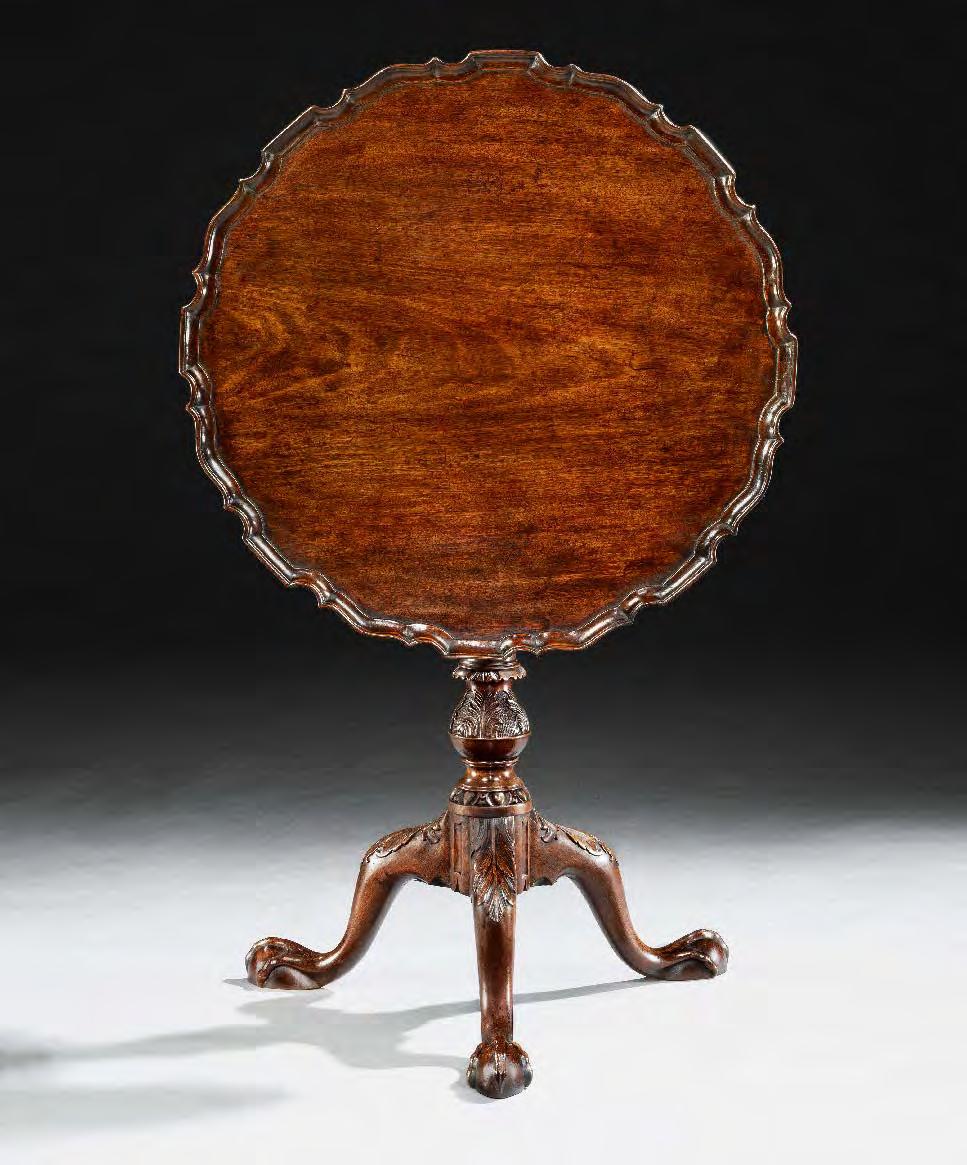



18
English, circa 1775
Height: 34¾ in; 88.5 cm
Height of seat: 16½ in; 42 cm
Width: 24 in; 61 cm
Depth: 24½ in; 62 cm
Provenance:
The collection of Frederick Howard Reed, London, England; Mallett & Son Ltd., London, England; Private collection, Europe.
A set of chairs with virtually identical design and differing only in having fluted seat rails was supplied to Robert Child for Osterley Park, Middlesex.
Linnell supplied much of the furnishing for Osterley, including several sets of chairs, and each set featured a variant of the lyre-back design. Given the similarity of the current set to the Osterley chairs, it is possible that it too was made for Robert Child and was destined for his London residence, 38 Berkeley Square.

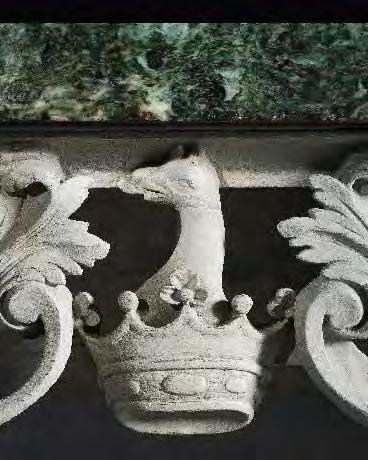
19
Note: The table retains much of the original paint and the original verde antico marble top.
Irish, circa 1750
Height: 3 ft 2¼ in; 97.5 cm
Width: 5 ft 6 in; 167.5 cm
Depth: 2 ft ½ in; 62 cm
Provenance:
Jeremy Ltd., London, England; Private collection, England.
The table features in the centre of the frieze a family crest apparently depicting a ducal crown issuing a goat’s or deer’s head.
The Gordon family in Scotland have a similar crest, of a ducal crown with a deer’s head, while the Whittington family crest features a goat’s head. Without further information, however, it is not possible to identify categorically the family crest represented here.
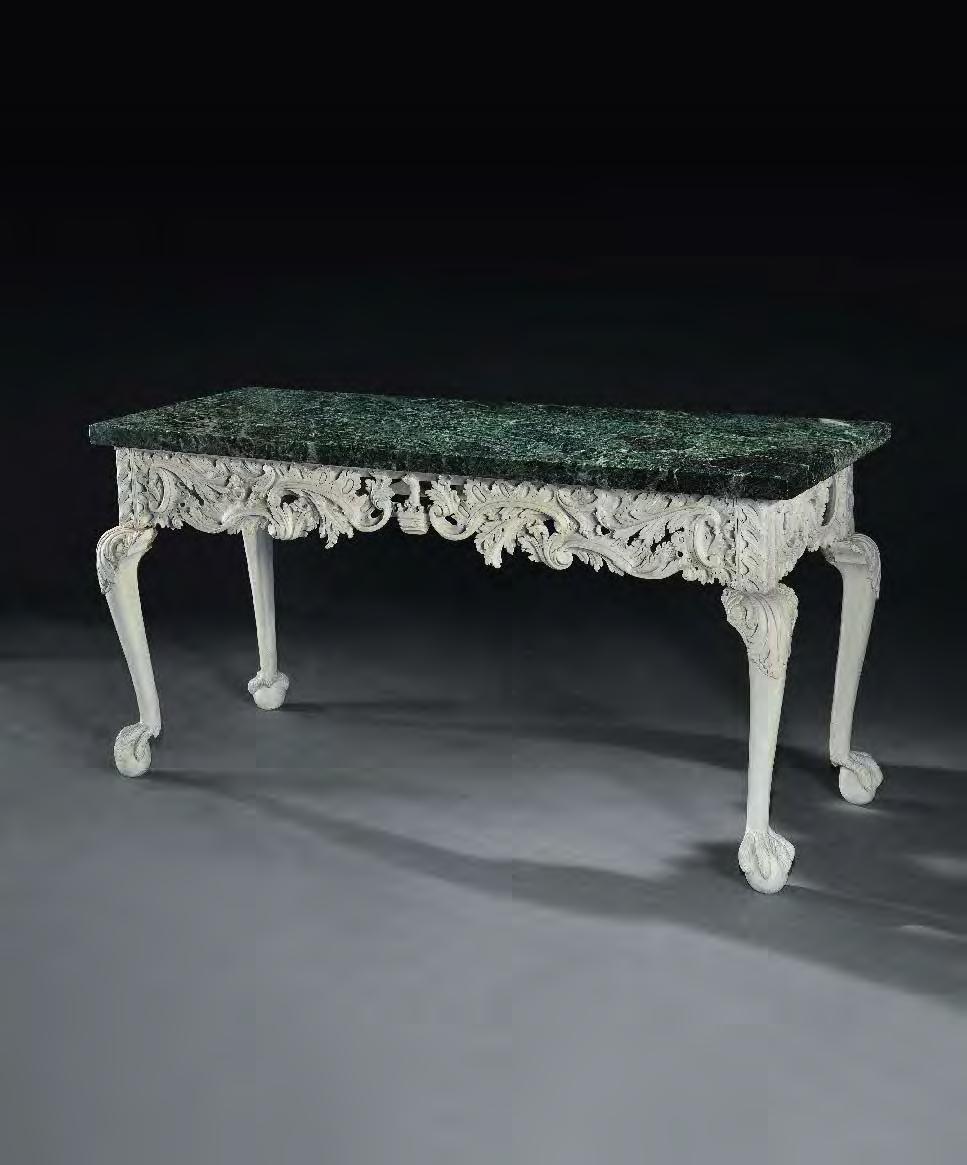
20
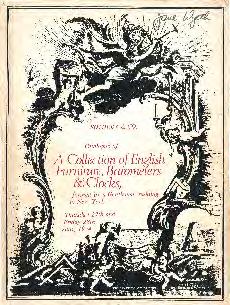
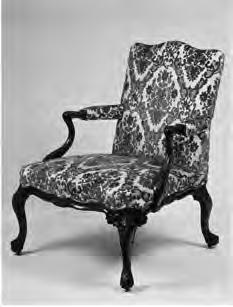
The chair illustrated in Sotheby’s sale catalogue, 27–28 June 1974, p. 129
Note: The back rail and back frame have been reinstated at some stage.
English, circa 1755
Height 38½ in; 98 cm
Height of seat: 18 in; 46 cm
Width: 31 in; 79 cm
Depth: 30 in; 76.5 cm
Provenance:
Charles Lumb & Sons Ltd., Harrogate, England, 1947; Arthur Leidesdorf, New York, USA, until 1974; Norman Adams Ltd., London, England; Private collection, Northumberland, England, until 1992; Charles Lumb & Sons Ltd., Harrogate, England; Private collection, Yorkshire, England; Private collection, London, England.
Exhibited: Northern Antiques Fair, Harrogate, 1992; with Charles Lumb & Sons Ltd.
Illustrated:
Antique Collector, June 1947, trade advertisement with Charles Lumb & Sons Ltd.
Sotheby & Co., ‘A Collection of English Furniture, Barometers & Clocks, formed by a Gentleman residing in New York’, sale catalogue, 27–28 June 1974, pp. 128–99.
Christopher Claxton Stevens and Stewart Whittington, 18th Century English Furniture: The Norman Adams Collection, 1983, p. 42.
Literature:
Thomas Chippendale, The Gentleman and Cabinet-maker’s Director, 3rd edition, 1762, pl. XXIII.
Christie’s, ‘Old English Furniture, Fine Chinese Porcelain and Objects of Art, The Property of Henry Hirsch’, sale catalogue, 10 June 1931, lot 75.
Christie’s Season 1931, p. 300.
M. Harris & Sons, The English Chair – Its History and Evolution, 1937, pl. XLIII.
Antique Collector, October 1953, trade advertisement with Oliver of Guildford; a similar chair with a straight back.
F. Lewis Hinckley, A Directory of Queen Anne, Early Georgian and Chippendale Furniture, 1971, p. 166, illus. 253.

A GEORGE II MAHOGANY KETTLE STAND
English, circa 1755
Height: 21½ in; 54.5 cm
Diameter of top: 10¾ in; 27.5 cm
Provenance:
Samuel Messer, The Vyne, Hampshire, England; Private collection, England.
Illustrated:
Christie’s, ‘The Samuel Messer Collection of English Furniture, Clocks and Barometers’, sale catalogue, London, 5 December 1991, p. 98, lot 72.
A leading collector of English tripod tables remarked on the unusually large scale toes of this kettle stand; at nearly three inches long, they give the table exceptional stability.
The mahogany has acquired an outstanding patination after centuries of wax polishing, some of which may have been done by Samuel Messer himself. He is known to have enjoyed polishing the items in his collection, and in the process deepening his knowledge and understanding of English furniture.
Samuel Messer’s collection was assembled under the guidance of R. W. Symonds, and is regarded as one of the very best collections of English furniture formed in the 20th century. It is now dispersed all over the world.
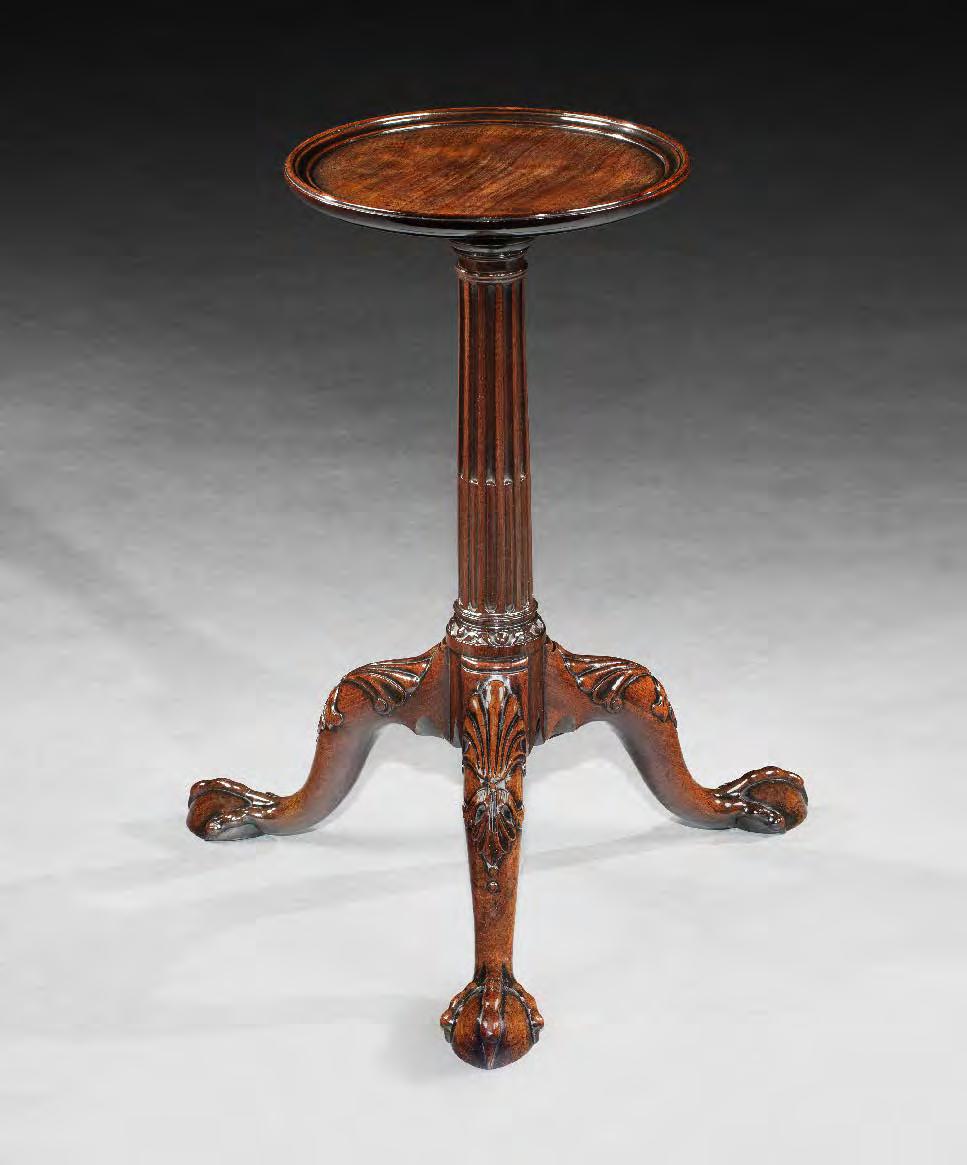

A PAIR OF GEORGE III ORMOLU MOUNTED BLUE JOHN AND STATUARY MARBLE CLEOPATRA CANDLE VASES BY MATTHEW BOULTON
Note: The ormolu has survived in remarkable condition, making these vases virtually original and untouched.
English, circa 1775
Height: 9 in; 23 cm
Width: 4¼ in; 10.5 cm
Depth: 4¼ in; 10.5 cm
Provenance:
Private collection, France.
Literature: Nicholas Goodison, Matthew Boulton: Ormolu, 2002, pp. 328–30.
Boulton & Fothergill produced various combinations of Cleopatra vases in their Soho manufactory in Birmingham. Virtually all of them have blue john vase bodies, but various materials are used for the square pedestals on which the vases are mounted: ormolu, blue john and various simulated semi-precious stones such as lapis lazuli and aventurine are all known. This is so far the only known recorded example with statuary marble bases.
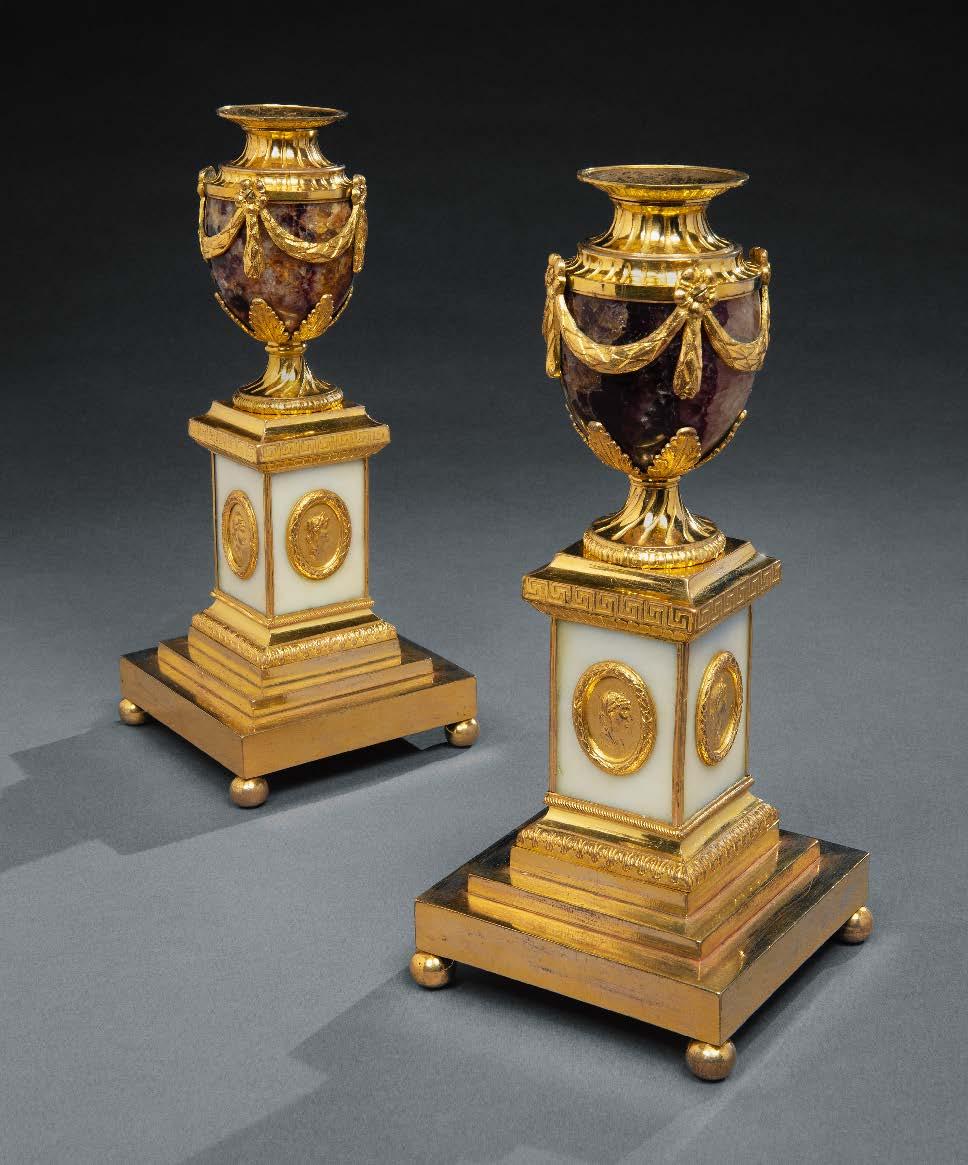
A
Note: The table retains the original Portor marble top. This distinctive and now rare black marble veined in white and mustardyellow is named for the Italian village of Porto Venere on the Ligurian coast, where it has been quarried since antiquity.
Centre tables are exceptionally rare. English, circa 1755
Height: 32¾ in; 83.5 cm
Width: 44¼ in; 112 cm
Depth: 21 in; 53.5 cm
Provenance: Private collection, Maryland, USA.
Literature: Jacques Dubarry de Lassale, Identifying Marble, 2000, pp. 252–3, item 129.

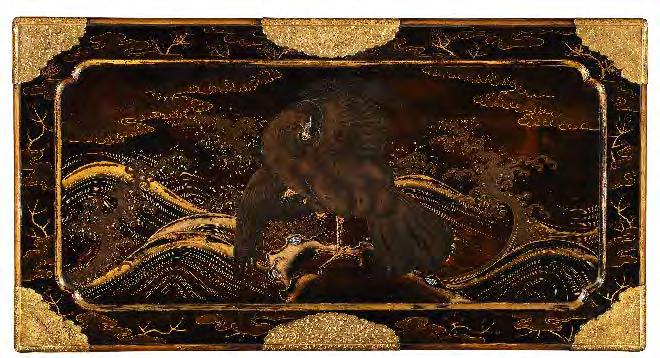
24
A VICTORIAN PERIOD JAPANESE EXPORT LACQUER CABINET ON STAND
Note: The artist’s signature is painted on the inside of the left-hand door, at the bottom left corner.
The cabinet: Japanese, Meiji period, circa 1870
The stand: English, 20th century
The cabinet:
Height: 40½ in; 103 cm
Width: 42¾ in; 109 cm
Depth: 22¾ in; 58 cm
The stand:
Height: 25 in; 63.5 cm
Width: 44½ in; 113 cm
Depth: 24¼ in; 61.5 cm
Provenance: Private collection, Gloucestershire, England.
Literature: Mallett & Son Ltd., ‘English and Continental Antique Furniture and Objets d’Art’, catalogue, 1989, pp. 54–5.
The front of the cabinet depicts a boat with its sails down, above which a flock of cranes is in flight, scattered by a storm, with other boats and Mount Fuji in the background. The interior drawers of the cabinet are decorated with an array of different feathers, perhaps representing feathers lost by the birds during the storm.
A cabinet with virtually identical decoration and ormolu mounts and perhaps the companion to our cabinet was retailed by Mallett & Son in 1989. The birds depicted on that cabinet are all cranes. Our cabinet, however, features cranes at the front and on the inside of the doors only; the sides, top and reverse all feature falcons.

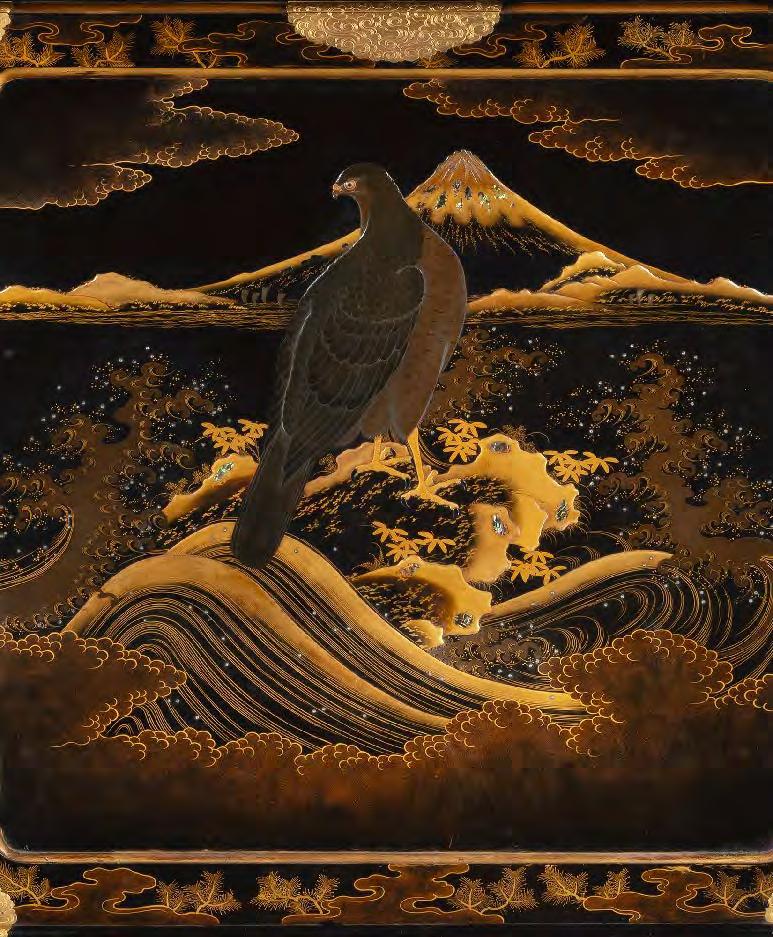
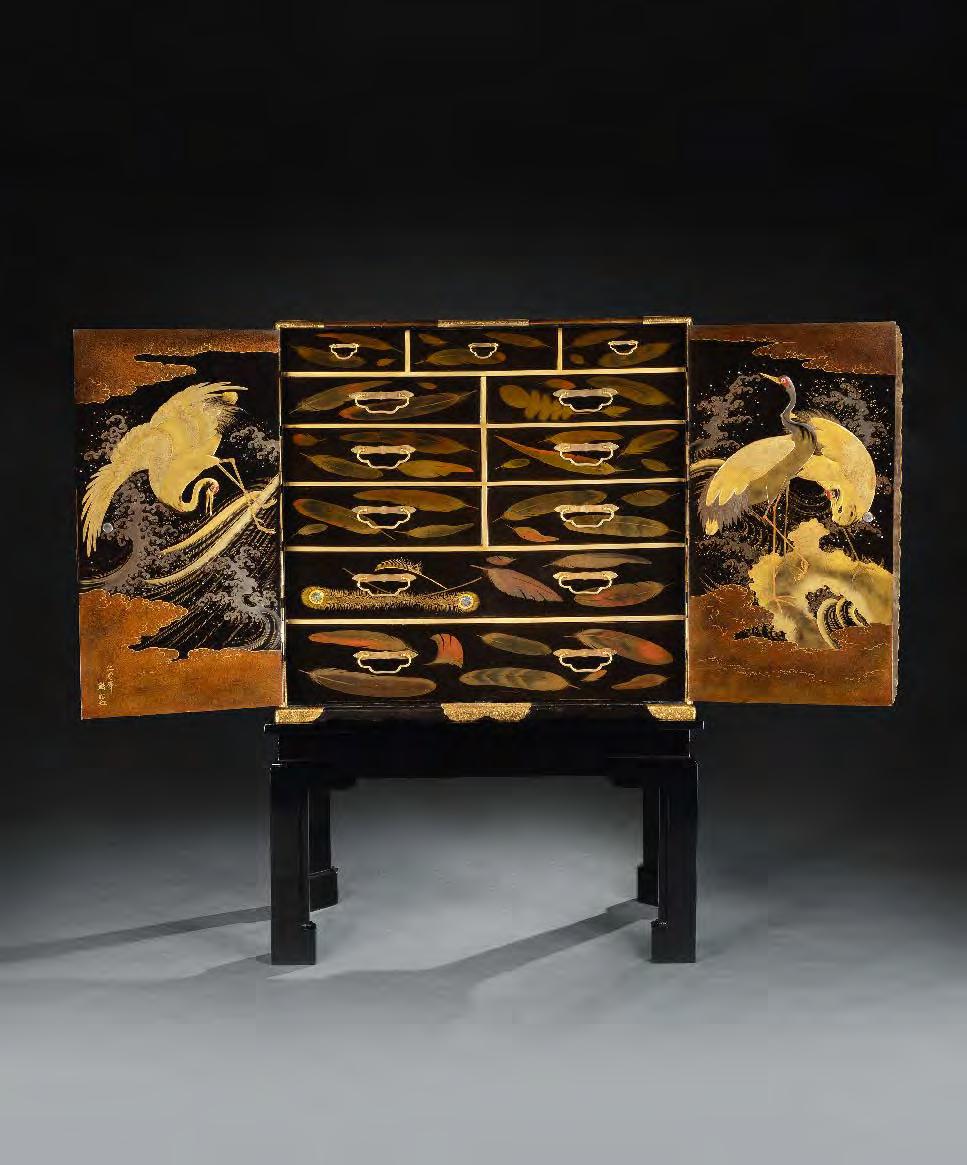

25
Note: The mirror retains the original mercury silvered mirror plate. The frame has been re-gilded.
English, circa 1770
Height: 6 ft 4 in; 193 cm
Width: 3 ft 8½ in; 113 cm
Depth: 1 ft 1 in; 33 cm
Provenance:
Arthur S. Vernay Inc., New York, USA; Mallett & Son Ltd., London, England; The Hon. Mrs. Daisy Fellowes, Donnington Grove, Berkshire, England; Private collection, England.
Illustrated
:
Arthur S. Vernay, ‘The Vernay Collection’, catalogue, spring 1928, p. 39. Christopher Hussey, ‘Donnington Grove Berkshire II’, Country Life, 25 September 1958, p. 655, fig. 4. Geoffrey Wills, English Looking-glasses: A Study of the Glass, Frames and Makers (1670–1820), 1965, p. 96, illus. 85.
Literature:
R. W. Symonds, ‘English Furniture in the Chinese taste’, Connoisseur, February 1936, pp. 89–94. Will Bennett, ‘Daisy Fellowes’, Daily Telegraph, 28 January 2002, Art & Culture section, no page no. Ronald Phillips Ltd., ‘Mirrors’, catalogue, 2010, p. 256; a mirror from the same workshop.
The design drawing in white chalk for the chinoiserie canopy was discovered on the internal side of the backboard during restoration of the mirror. This was a rare and important find, as original 18th century drawings of mirrors are extremely scarce.
The mirror belongs to a small group of very similar mirrors, all of which share the same combination of carton pierre and giltwood.
Daisy Fellowes is often described as one of the great style icons of the early 20th century. Her substantial fortune allowed her to entertain on a grand scale in France and the Mediterranean and at Donnington Grove, her country seat in Berkshire, which she furnished in an opulent way. She was notorious for her many indiscretions with married men, but her eccentric reputation, combined with her wealth, lavish hospitality, sharp tongue and dry humour, made her one of the most socially influential women of her time.

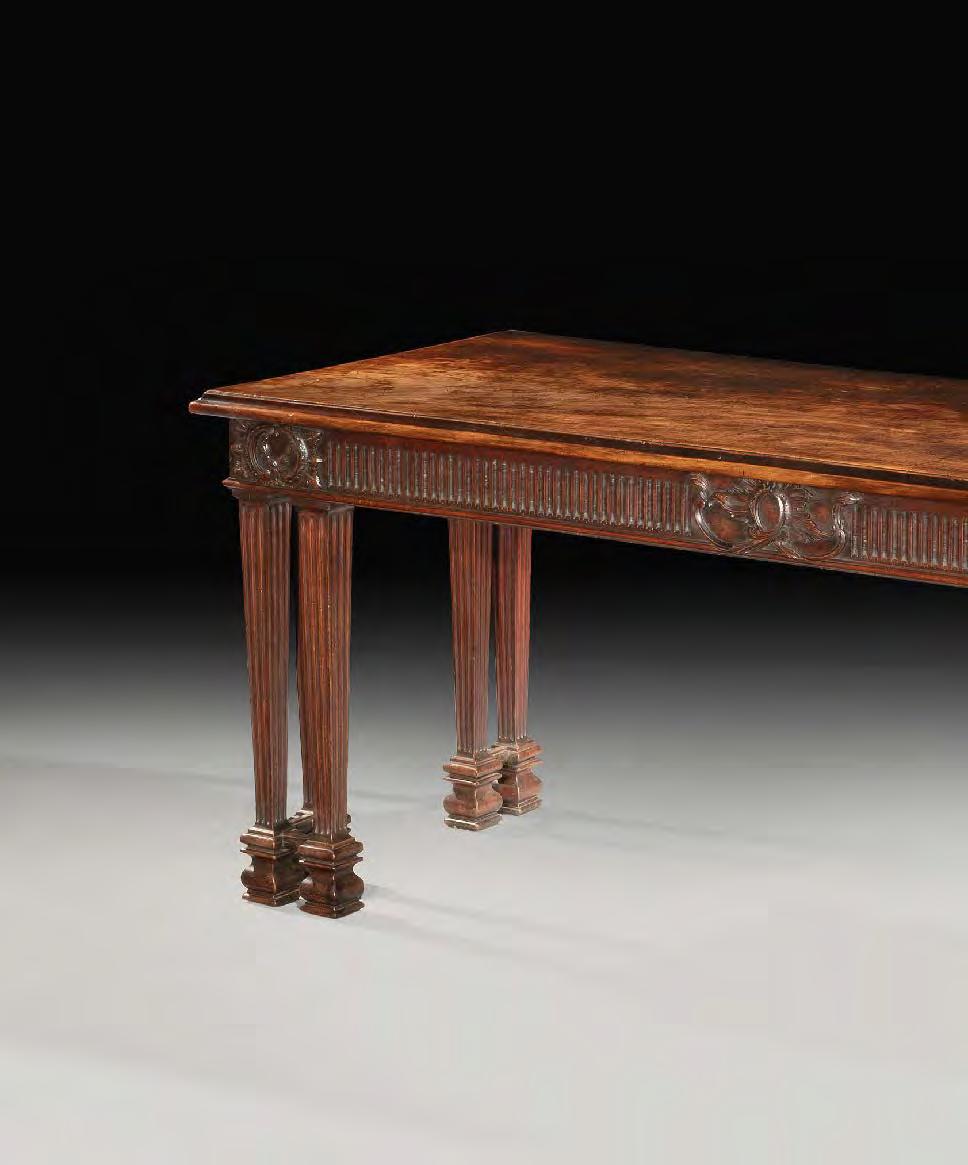


Note: The table has been preserved in wonderful condition. The patina accumulated over centuries of wax polishing is outstanding.
English, circa 1755
Height: 2 ft 10½ in; 87.5 cm
Width: 7 ft ¼ in; 214 cm
Depth: 2 ft 9 in; 84 cm
Provenance: Ecclesiastical collection, England.
Illustrated: Percy Macquoid and Ralph Edwards, The Dictionary of English Furniture, vol. III, 1954, p. 128, fig. 12.



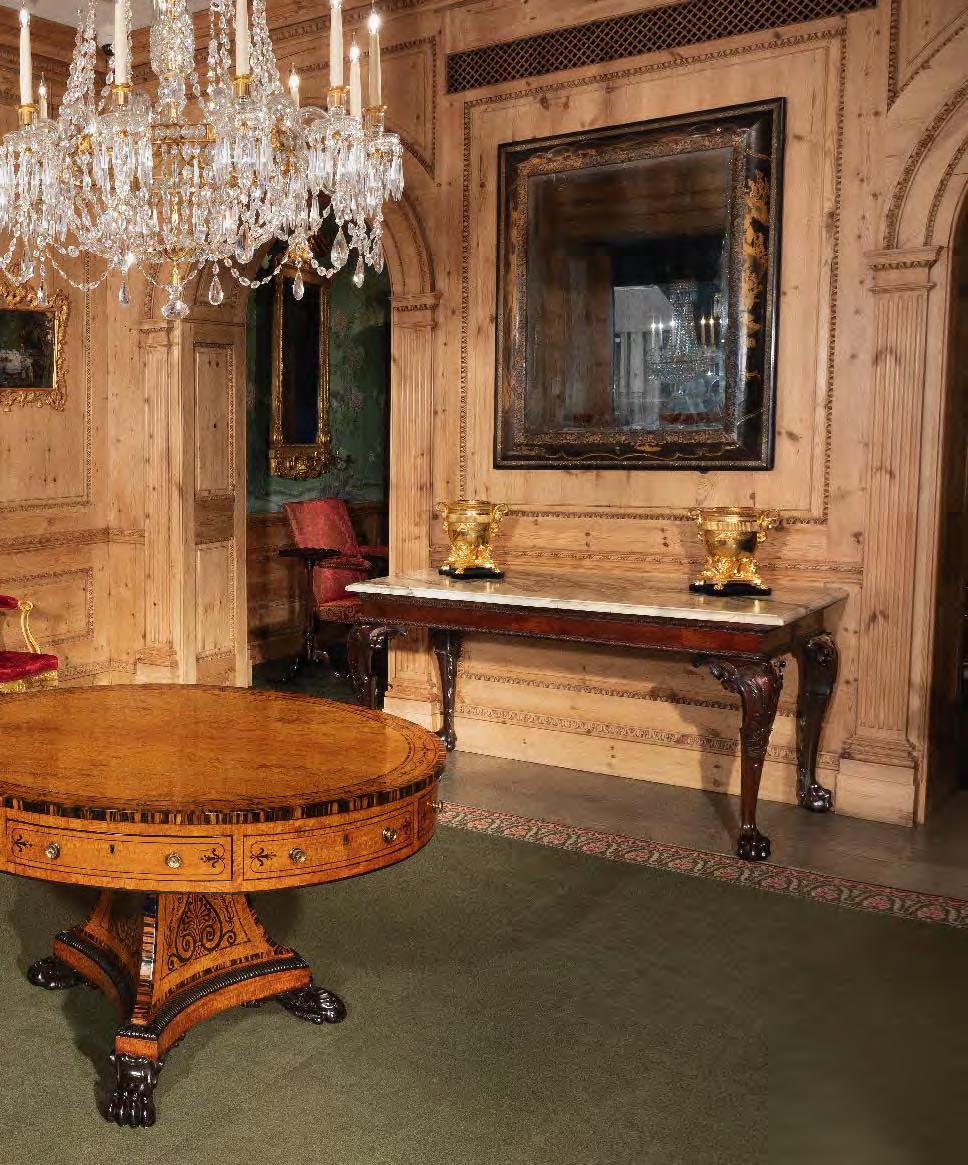

27
A GEORGE III GILTWOOD SIDE TABLE
Note: The table has been re-gilded and the toes have been tipped. The brèche violette marble top is probably of later date.
English, circa 1770
Height: 34¾ in; 88.5 cm
Width: 59½ in; 151 cm
Depth: 27 in; 69 cm
Provenance: Ronald Phillips Ltd., London, England; Private collection, Canada.
Illustrated: Ronald Phillips Ltd., ‘Antique English Furniture’, catalogue, 1997, p. 1.
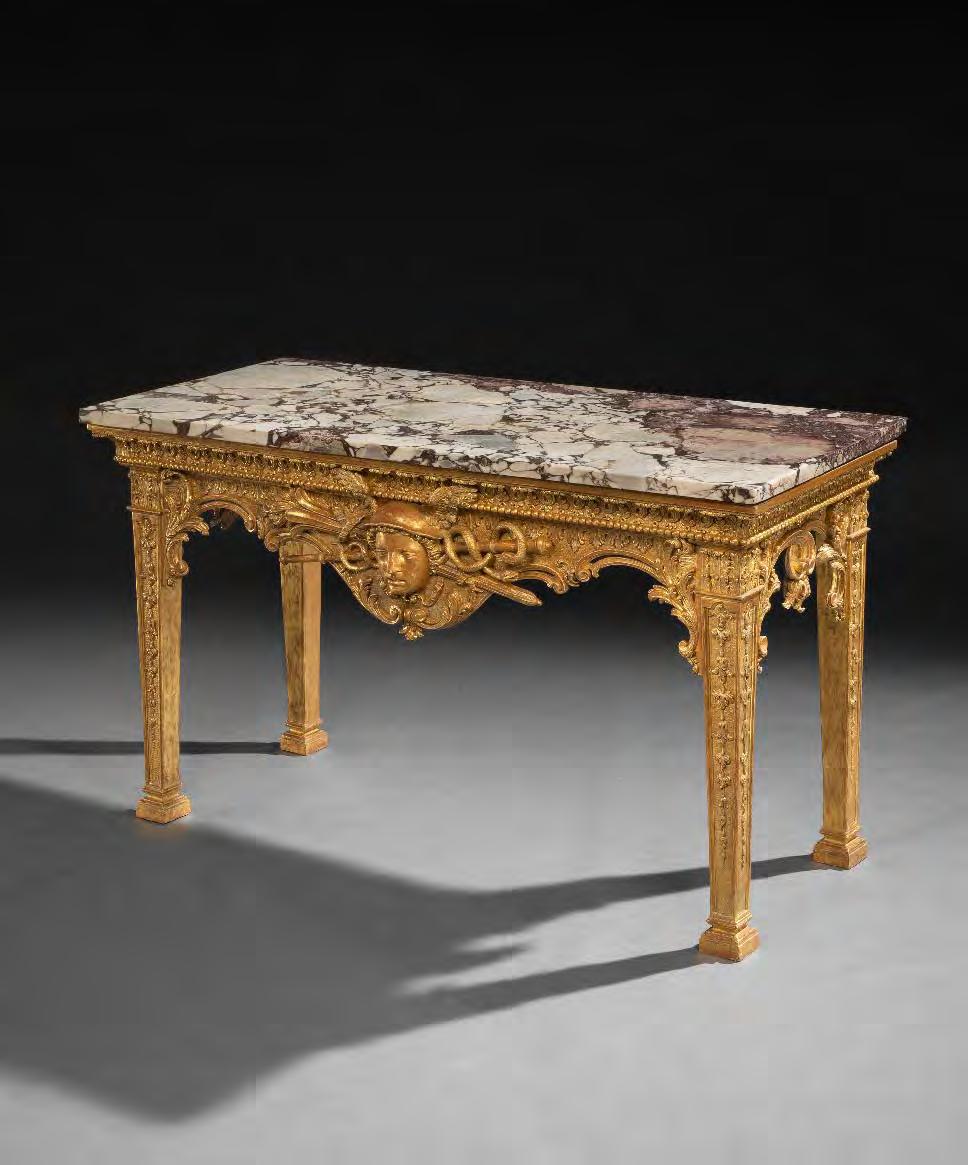
English, circa 1800
Height: 13½ in; 34.5 cm
Diameter: 4½ in; 11.5 cm
Bases: 4 in; 10 cm (square)


Note: The desk retains all the original brass plate handles and the original locks.
English, circa 1725
Height: 30 in; 76.5 cm
Width: 21½ in; 54.5 cm
Depth: 14¼ in; 36 cm
Kneehole
Height: 20¼ in; 51.5 cm
Width: 7½ in; 19 cm
Depth: 5½ in; 14 cm
Provenance:
Private collection, England.
The small dimensions of this exceptionally narrow kneehole desk combined with its beautiful mellow patina make it extremely rare and desirable.


30
A GEORGE I GESSO BORDER GLASS MIRROR ATTRIBUTED TO PHILIP ARBUTHNOT
Note: The mirror retains virtually all the original gilding and original glass, with some border glass replacements. English, 1714
Height: 46½ in; 118 cm
Width: 29 in; 74 cm
Provenance: Sir William Humphreys (d. 1735), Hever Castle, Kent, England; Private collection, England; David Pickup Antiques, Cheltenham, Gloucestershire, England; H. Blairman & Sons Ltd., London, England; Private collection, New York, USA.
Illustrated:
R. W. Symonds, Masterpieces of English Furniture and Clocks, 1940, p. 69, fig. 46.
H. Blairman & Sons Ltd., ‘Furniture and Works of Art’, catalogue, 2009, item 1.
Literature: Herbert F. Schiffer, The Mirror Book: English, American & European, 1983, p. 77.
Hyde Park Antiques Ltd., New York, volume VI, 2000, pp. 8–9.
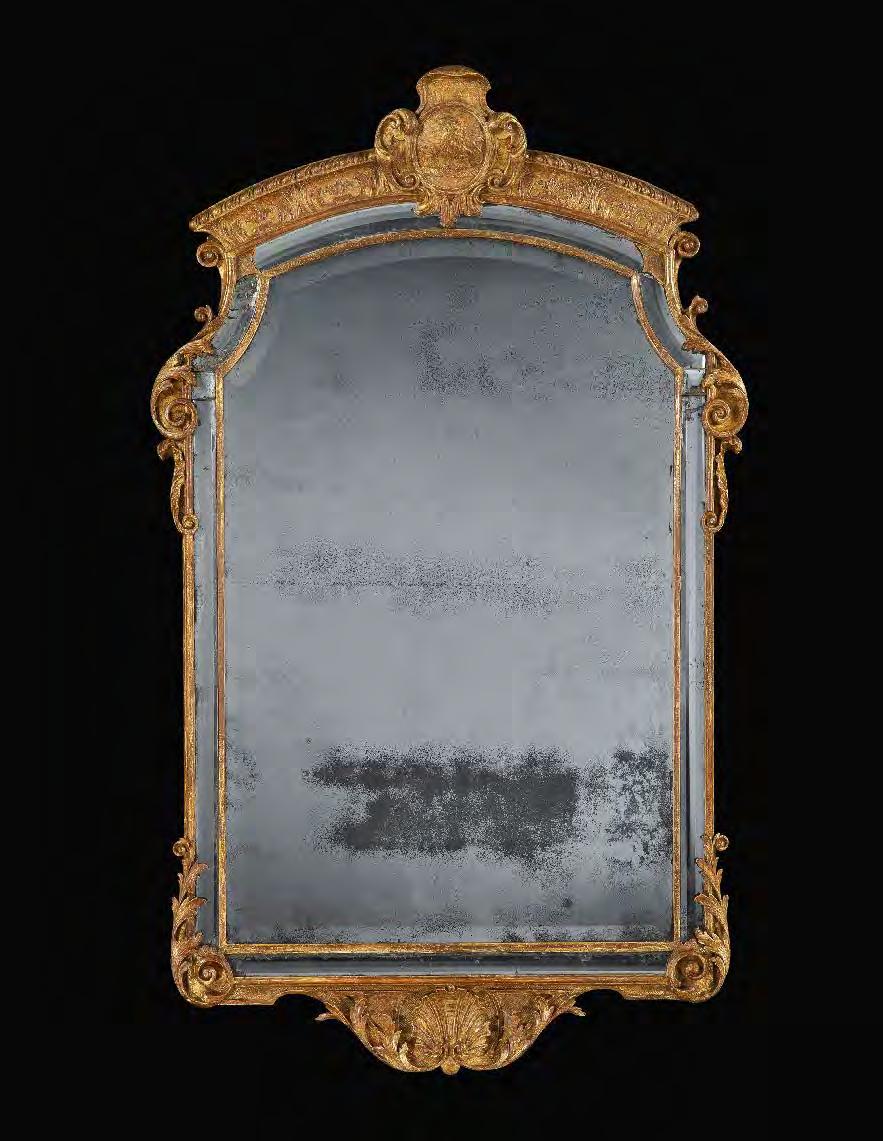


Sir William Humphreys was Lord Mayor of London from 1714 to 1715. He was created a baronet in November 1714, less than three months into George I’s reign. The mirror celebrates his new title and was probably ordered at that time. Some five years later he was appointed a director of the Bank of England, holding the position until 1730.
A large overmantel mirror from the same commission and featuring an identical family crest cartouche was offered for sale by Hyde Park Antiques in New York in 2000. The same crest can be seen in a stained glass window at Hever Castle, Kent, Sir William’s family seat. Two centuries earlier, Hever Castle had been the home of Anne Boleyn, the second wife of Henry VIII.
The shape of the mirror is highly unusual in English furniture, but is characteristically French; it can be seen in a late 17th century French drawing for a framed panel, with the same concave corners at the top. The French origin of the design reflects Arbuthnot’s Huguenot family background.



A GEORGE III MAHOGANY TABLE CASKET
Note: The interior behind the fall front was originally fitted with five shallow drawers. The frieze drawer has been retained, and the articulated ornate brass carrying handle is probably original. The lock is of later date.
English, circa 1765
Height (with handle): 8 in; 20.5 cm
Width: 14¼ in; 36 cm
Depth: 10 in; 25.5 cm
Provenance:
Mallett & Son Ltd., London, England; Private collection, London, England.
Exhibited:
Thomas Chippendale 1718–1779, Taste in the Fashions, Bradford Art Galleries and Museums, Bolling Hall, 21 October–25 November 1979, Director Room, exhibit no. 7.
Illustrated: ‘Thomas Chippendale 1718–1779, Taste in the Fashions’, exhibition catalogue, Bradford, 1979, p. 18.
Literature:
Thomas Chippendale, The Gentleman and Cabinet-Maker’s Director, 1754, pl. CXXIX.
Thomas Chippendale, The Gentleman and Cabinet-Maker’s Director, 3rd edition, 1762, pl. LXXI.
The mahogany of this casket is carved in the most exceptional manner and has acquired a beautiful patination, giving the carved decoration extra depth.
The quality of the carving is comparable to that on pieces of furniture commissioned by George III and his wife, Queen Charlotte, from Vile & Cobb and John Bradburn. This fine piece could have come from either of those workshops.
The design must be credited to Thomas Chippendale. His first edition of The Gentleman and Cabinet-Maker’s Director of 1754 features three variants of tea chests in plate CXXIX. The design of the most ornate one has been followed in minute detail for this casket. Paradoxically this is why Chippendale is unlikely to be its maker, because the Chippendale workshop always introduced slight alterations to their designs in order to guarantee that each client’s commission was truly unique.
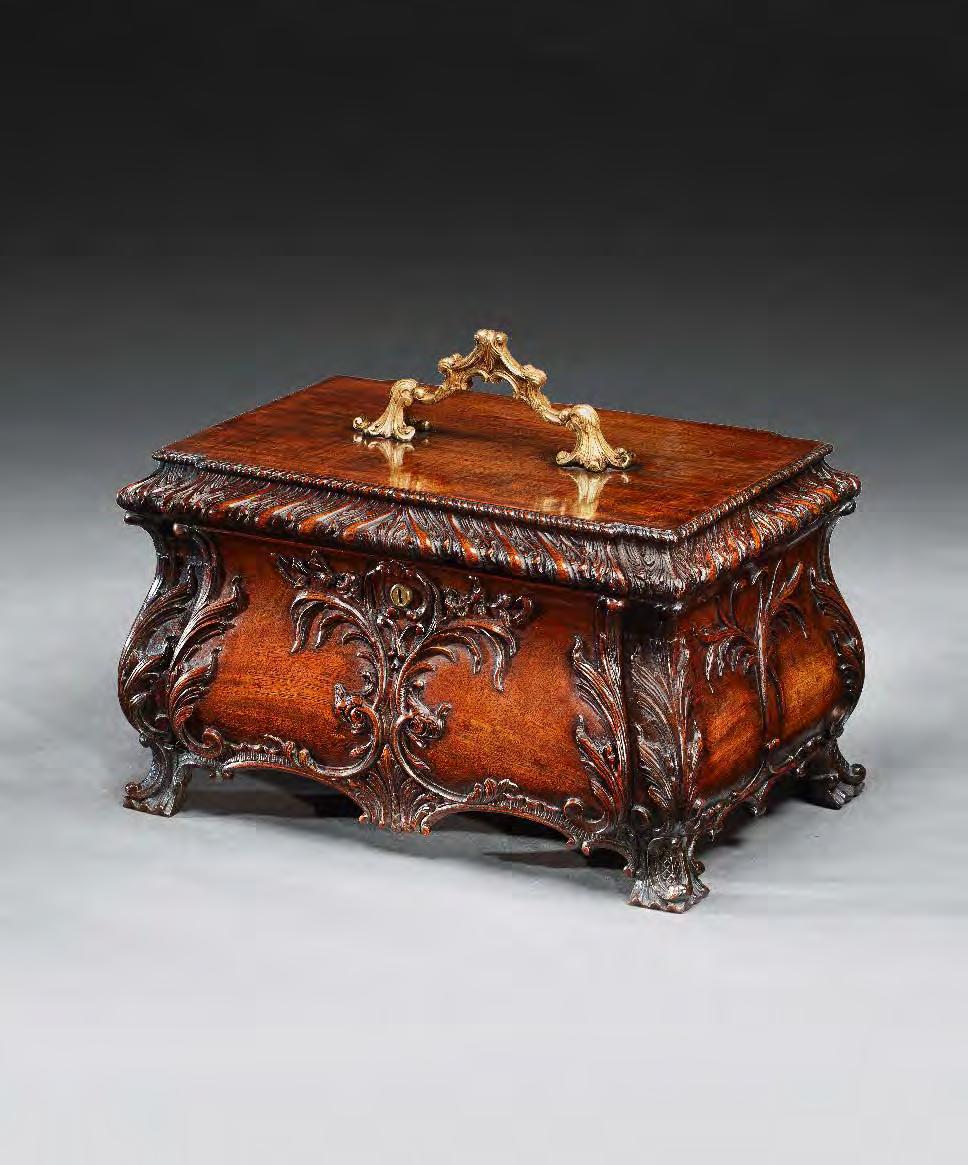
32
A PAIR OF GEORGE III GILTWOOD COMPOSITION WALL LIGHTS
Note: The wall lights retain most of the original gilding. A Sotheby’s Belgravia label is pasted to the reverse of one of the pair. English, circa 1780
Height: 30 in; 76 cm
Width: 17¾ in; 45 cm
Depth: 10 in; 25 cm
Provenance: Private collection, Europe.

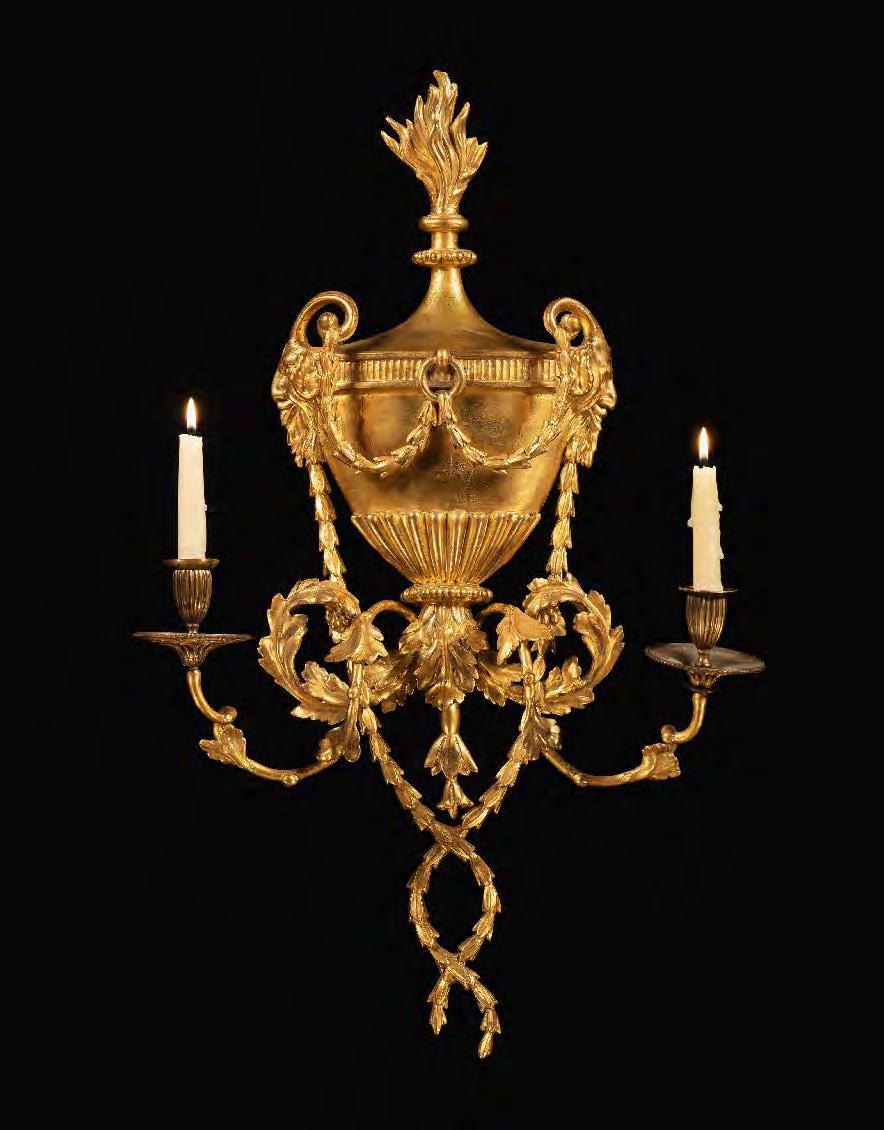
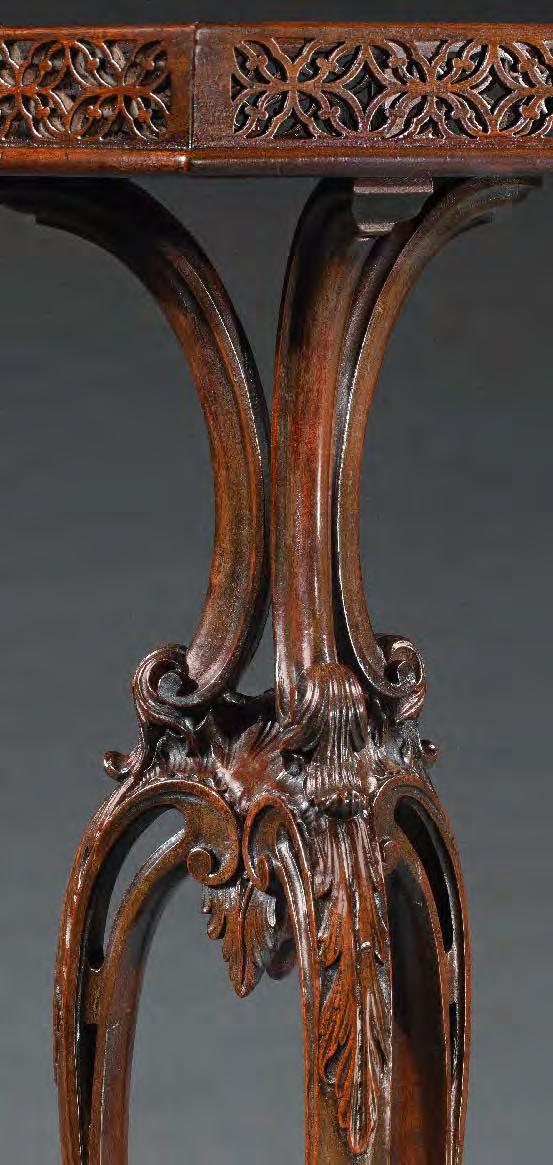

The two torchères supplied to the Duke of Atholl. Christopher Gilbert, The Life and Work of Thomas Chippendale, 1978, vol. 2, p. 207, fig. 387
A GEORGE II MAHOGANY TORCHERE ATTRIBUTED TO THOMAS CHIPPENDALE
Note: One side of the pierced hexagonal gallery has been restored at some stage.
English, circa 1755
Height: 40½ in; 103 cm
Width: 12¾ in; 32.5 cm
Diameter of base: 20 in; 51 cm
Provenance: Hotspur Ltd., London, England; Private collection, Herefordshire, England.
Illustrated: Anthony Coleridge, Chippendale Furniture, 1968, pl. 292.
Literature:
Christopher Gilbert, The Life and Work of Thomas Chippendale, 1978, vol. 1, p. 129; vol. 2, p. 207, fig. 387.
Thomas Chippendale supplied two torchères of very similar outline to the Duke of Atholl for Blair Castle in Scotland in 1758 for £7 7s 0d: ‘a Pair of large Candlestnds neatly carv’d & painted white’. Perhaps deterred by Chippendale’s considerable charges, the Duke then engaged the local Scottish craftsman John Thomson to make a further two torchères to match the first pair. Both pairs are still at Blair Castle.

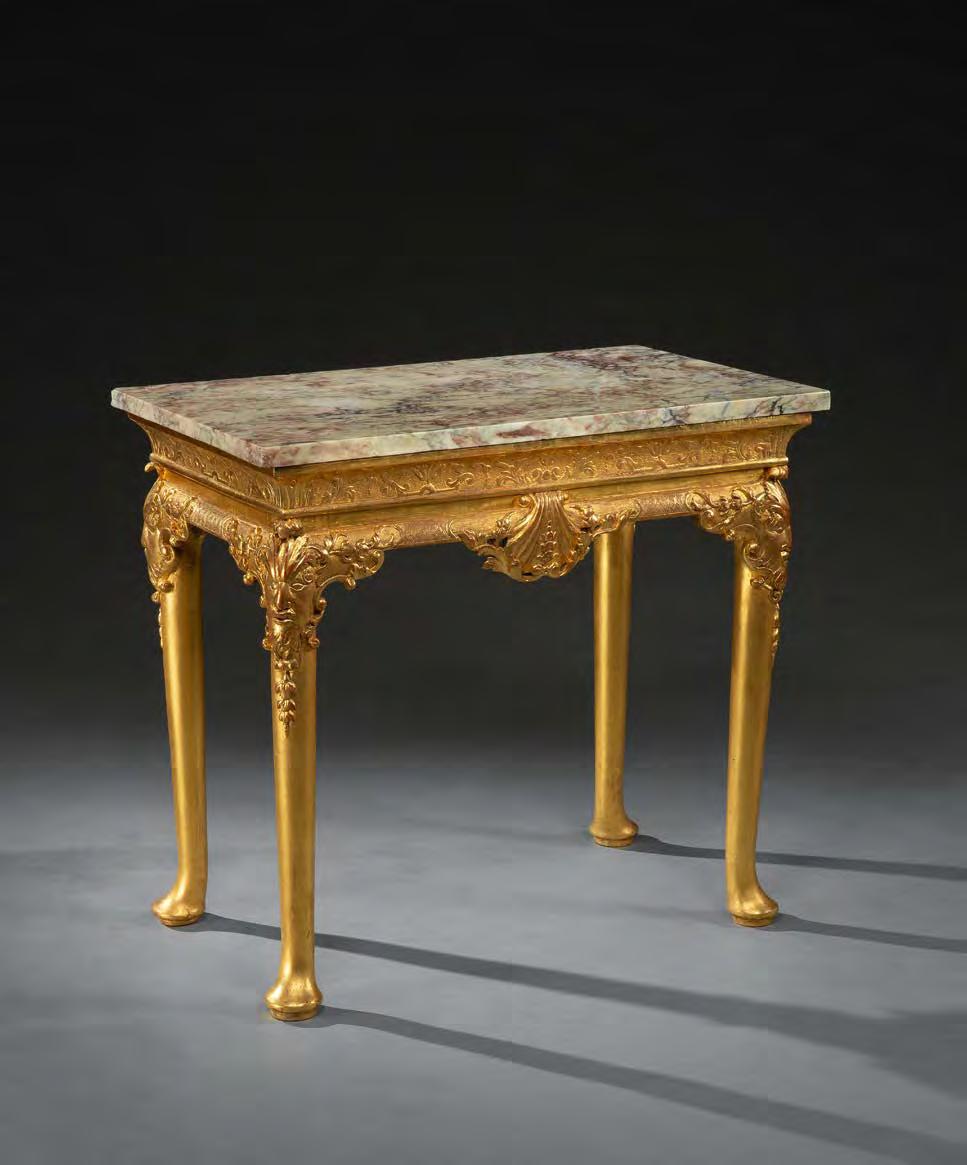


Edwina, Countess Mountbatten, with one of the pair illustrated in situ at Brook House, London. Courtesy of Sotheby’s
Note: The table frames retain much of the original gilding. The Breccia marble tops are of later date.
Irish, circa 1740
Height: 29½ in; 75 cm
Width: 32¾ in; 83.5 cm
Depth: 19 in; 48 cm
Provenance:
Marquess of Sligo, Westport House, County Mayo, Ireland; By descent to Doreen, Baroness Brabourne (1896–1979), Broadlands, Hampshire, England; Edwina, Countess Mountbatten of Burma (1901–1960), Brook House, Mayfair, London, England; Patricia, Countess Mountbatten of Burma (1924–2017), New House, Hatch, Kent, England.
Photographed:
In the drawing room at Brook House, Mayfair, London; private family archive.
In the corridor at New House, Kent; private family archive.





35
Note: The mirrors retain some of their original gilding. One of the shaped centre plates is an 18th century replacement. Each mirror retains an inventory inscription on the reverse, reading ‘L No. 19’. L stands for Lerchenborg Castle, and No. 19 indicates the location of the mirror within the castle.
English, circa 1730
Height: 44 in; 112 cm
Width: 25 in; 63.5 cm
Provenance:
Robert Thornton, for Lerchenborg Castle, Denmark; By descent to; Christian Lerche, Lerchenborg Castle; Amalie Margrethe Christiane Caroline Leiningen-Westerburg née Lerche, Lerchenborg Castle; Georg Flemming Lerche, Lerchenborg Castle; Christian Cornelius Lerche-Lerchenborg, Lerchenborg Castle; Christian Albrecht Lerche, Lerchenborg Castle; Christian Cornelius Lubbi Lerche-Lerchenborg; J. Bruhn, Lerchenborg Castle; Private collection, England; Ronald Phillips Ltd., London, England; Private collection, USA.
Lerchenborg Castle in Denmark was built by Carl Ahlfeld in 1704. The estate belonged to Robert Thornton between 1729 and 1742, and the mirrors were probably installed during this time. Two matching and far larger mirrors remain at Lerchenborg as part of the original suite.
Robert Thornton was a director of the Bank of England and a wealthy cloth merchant who owned the Clapham estate. On his death in 1742 his fortune, valued at around £100,000 (equivalent to at least £28 million today) passed to his son John. John’s frequent travels on occasion took him as far as Russia, when Lerchenborg Castle would have been a convenient stopping point. A journal by John Thornton, dated 1742 and describing his travels from Riga through Germany and Italy to England, was sold at Dominic Winter Auctions in Cirencester, England, in 2019.
John Thornton was known for his philanthropy in Germany and Denmark as well as in England. When he died in 1790 he was described as the richest person in England.


The chair: English, circa 1735
The needlework: French, circa 1720
Height: 45 in; 114.5 cm
Height of seat: 21 in; 53.5 cm
Width: 33½ in; 85 cm
Depth: 36 in; 91.5 cm
Provenance: Private collection, New York, USA.
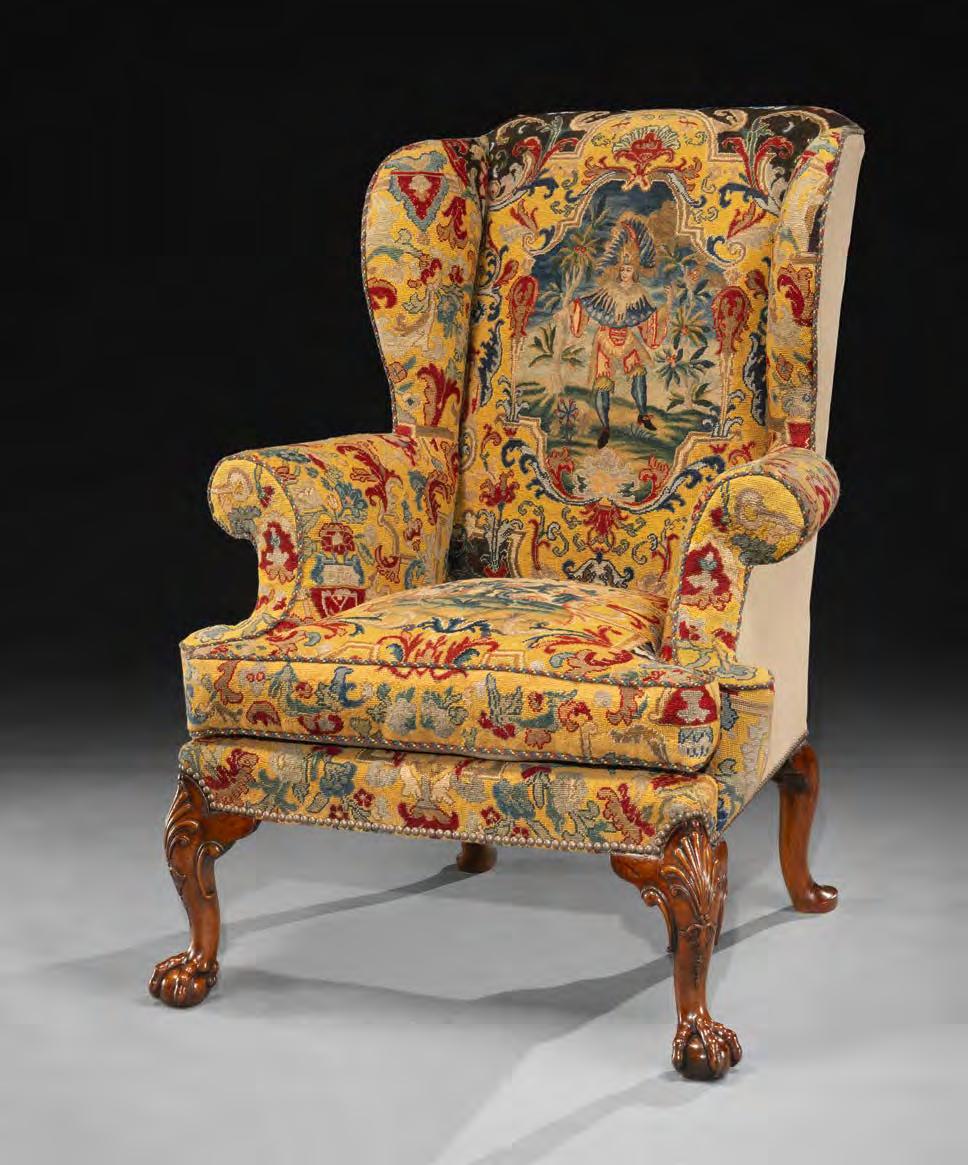


A similar bureau illustrated in ‘The Hochschild Collection of Highly Important English Furniture’, Sotheby’s, London, 1 December 1978, lot 13
37
A GEORGE II BURR WALNUT AND PARCEL GILT BUREAU CABINET ATTRIBUTED TO THE WORKSHOP OF GILES GRENDEY
Note: The cabinet largely retains the original gilding. The mirror plates are period replacements, and the handles are faithful reproductions.
English, circa 1735
Height: 8 ft 10½ in; 270 cm
Width: 3 ft 8 in; 112 cm
Depth: 2 ft 1¾ in; 63 cm
A virtually identical cabinet was formerly in the Hochschild Collection and is now in a private collection. One difference between that cabinet and the present example is that ours features herringbone crossbanding on the doors, the drawer fronts and the fall. The Hochschild cabinet was left plain without herringbone banding in those areas. Our cabinet also features a handsome eagle as opposed to a cartouche within the broken pediment.
The Hochschild cabinet had a Swedish provenance, and it is possible that our cabinet was also ordered by a Scandinavian or Germanic family. The bombé shaped base to both cabinets reflects the fashion in those countries at the time.
Giles Grendey had a flourishing business not only in London but also exporting his goods abroad. Furniture by Grendey has been traced back to Spain, Italy, Portugal, Norway, Denmark and Sweden. He catered to this international market by adapting his designs to suit the prevailing fashions in different countries.

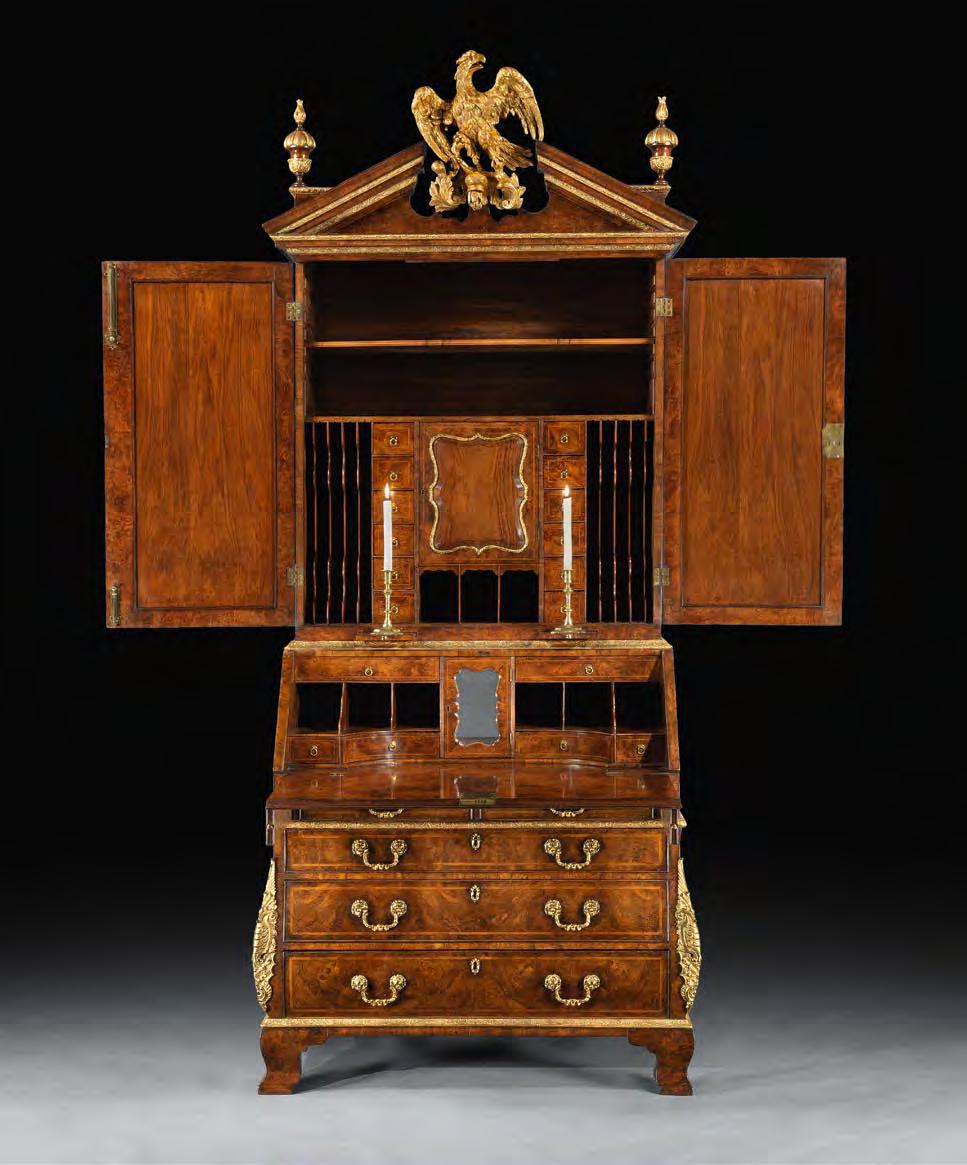



38
Note: The original verre églomisé glass panel in the back is cracked. The chair retains virtually all the original gilt lead mounts. English, circa 1725
Height: 41¾ in; 105.5 cm
Height of seat: 19 in; 48 cm
Width: 22½ in; 57 cm
Depth: 23¼ in; 59 cm
Provenance: Nicholas Leke, 4th Earl of Scarsdale, for Sutton Scarsdale Hall, Derbyshire, England; White, Allom & Co., London, England; Mrs. Annie C. Kane, New York, USA, until 1921; French & Co., New York, USA (before 1960); Collection of Forrest Knowles, USA; Hyde Park Antiques Ltd., New York, USA; Private collection, USA.
Literature: Yvonne Hackenbroch, English Furniture with Some Furniture of Other Countries in the Irwin Untermyer Collection, 1958, pls. 64 & 65, figs 87 & 88, pp. 21–2 (formerly in the collection of John Inness Kane, New York, and now at the Metropolitan Museum of Art, New York).
F. Lewis Hinckley, A Directory of Queen Anne, Early Georgian and Chippendale Furniture, 1971, p. 63, ill. 64.
William Rieder, ‘Eighteenth-century chairs in the Untermyer Collection’, Apollo, March 1978, pp. 181–5.
Geoffrey Beard and Christopher Gilbert, The Dictionary of English Furniture Makers 1660–1840, 1986.
Geoffrey Beard and Judith Goodison, English Furniture 1500–1840, 1987, p. 47.
Christopher Gilbert, Furniture at Temple Newsam House and Lotherton Hall, 1998, vol. III, pl. 6 and no. 696, p. 581.
Adam Bowett, Early Georgian Furniture 1715–1740, 2009, p. 177, pl. 4:66 (now at Temple Newsam, Yorkshire).
This chair was once part of a suite of twelve chairs, two settees and two pedestals, all with the Scarsdale family crest painted on glass inserts. When they were exhibited by the furniture dealers White, Allom & Co. at the Exposition Universelle in Brussels in 1910, part of the suite was destroyed by fire. Copies were produced to complete the suite, and it was sold to an American collection in New York, where it was again damaged by fire in August 1921.
Eight chairs from the original set of twelve survived both fires. Today seven of them are in major collections: one pair in the Metropolitan Museum in New York (incised X and I), another pair in the Frick Collection in New York (VIII and XII), a single chair in the Cooper Hewitt Museum in Brooklyn (IV), and a third pair at Temple Newsam, Yorkshire (VII and IX).
This is the eighth and last chair (incised V) from the original set.





English, circa 1650
Height: 24¾ in; 63 cm
Width: 25¾ in; 65 cm
Depth: 2¼ in; 5.5 cm
Provenance: Witney Antiques, Witney, Oxfordshire, England; Private collection, New York, USA.
Exhibited:
The International Winter Antiques Show, New York, 2002, when purchased by the last owner.
The stumpwork is set back within an oval cartouche headed by the gatehouse towers of Whitehall Palace, London, which was destroyed by fire in 1698. At the four corners are depicted four animals associated with English royalty, on the top, a lion to the left and a hart on the right; below are an ermine to the left and a unicorn to the right. The central needlework within the oval is based on Peter Paul Rubens’s 1623 painting The Head of Cyrus Brought to Queen Tomyris, but whilst the composition of the scene is virtually identical, the people depicted have a different appearance.
The stumpwork shows Queen Henrietta Maria, wife of the executed Charles I, with her three daughters and two sons, being presented with the head of her husband. The expressions on her and her children’s faces are of horror and shock.
Facing the queen are some of those instrumental in Charles I’s death.

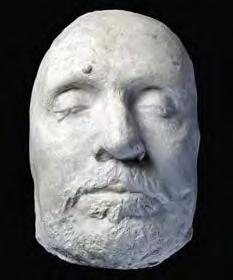



From left to right they are: Henry Ireton, Parliamentarian general and son-in-law to Oliver Cromwell; Cromwell himself, depicted with blood on his hands; William Juxon, Bishop of London; an unidentified figure (perhaps the executioner) wearing a red cloak; and John Lambert, another Parliamentarian general.
The subject matter of this needlework would have been dangerously subversive at the time it was made, and for that reason it is disguised as a scene from classical history. If it had come to light during the rule of Cromwell as Lord Protector, the maker and owner could have faced arrest, imprisonment or possibly worse.
As far as we know this is the only example of such overt criticism of the Protectorate, making this piece of needlework exceptionally important.


Note: The escutcheons are original and the brass handles are of later date.
English, circa 1720
Height: 29¼ in; 74 cm
Width: 38 in; 96.5 cm
Depth (open): 27½ in; 69.5 cm
Depth (closed): 16¾ in; 42.5 cm
Provenance:
Church Street Galleries, London, England; Private collection, London, England.
This unusual chest of drawers stands out for its beautiful mellow colour, a result of centuries of wax polishing. It is also distinctive for being slightly wider than the standard bachelor’s chest, as well as for having a fold-over top that is shallower than the full depth, thus forming a step at the back when opened. The latter feature may be unique to this piece and is very practical: items placed on the closed top need not be removed before opening it, but merely pushed towards the back.
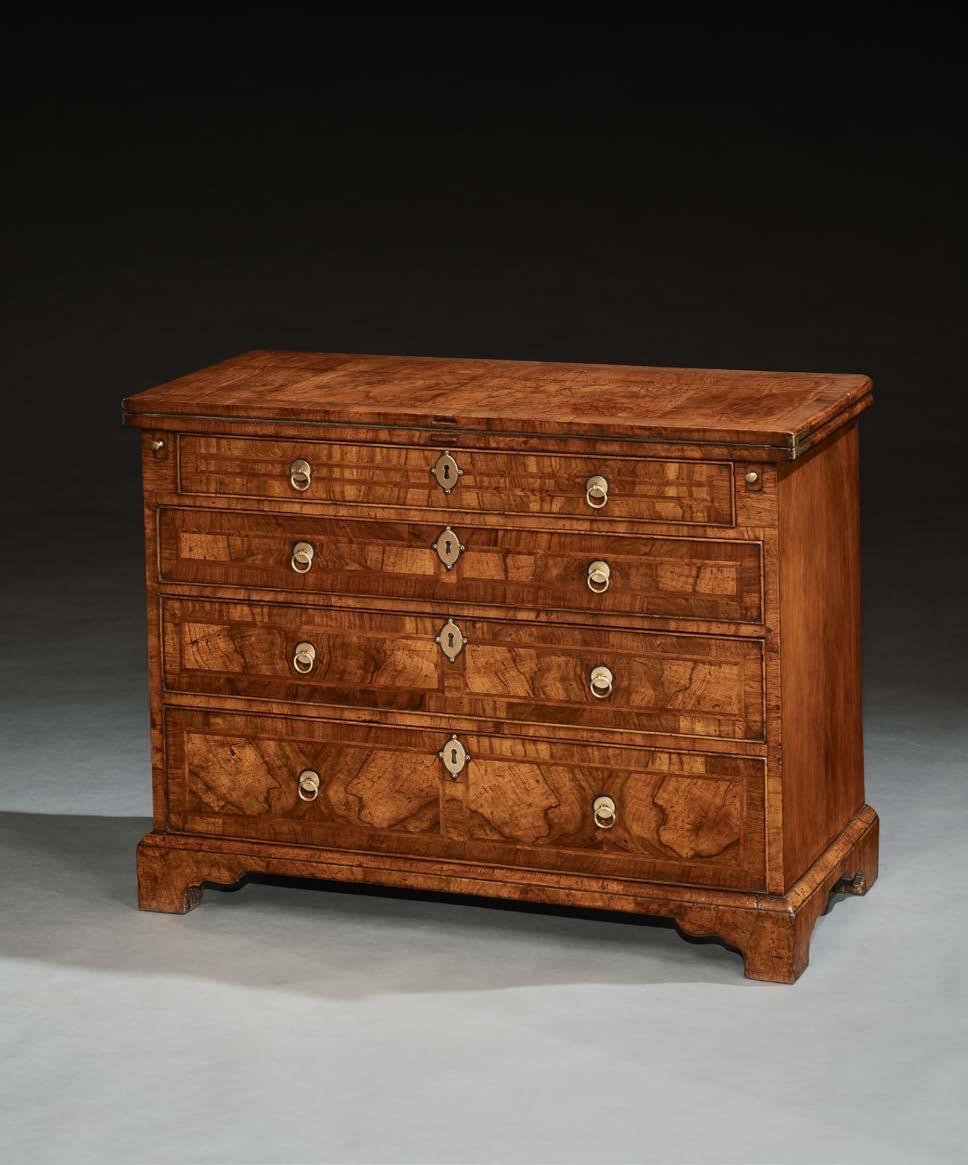
A
Note: The mirror retains most of the original gilding and the original mercury silvered bevelled mirror plate. The glass candle arms and brass sockets are of later date. The shaped, engraved and gilded back plates for the candle arms are original.
English, circa 1710
Height: 52½ in; 132 cm
Width: 33¼ in; 85 cm
Depth: 4 in; 10 cm
Provenance: Private collection, England.
The Arbuthnots were French Huguenots and were very familiar with the latest continental fashions. This mirror stands out for its unusually shaped glass plate and the large scale candle sockets, which are finely engraved and gilded, and an interestingly abstract acanthus leaf carved moulding comparable to that seen on other commissions associated with the Arbuthnot family.
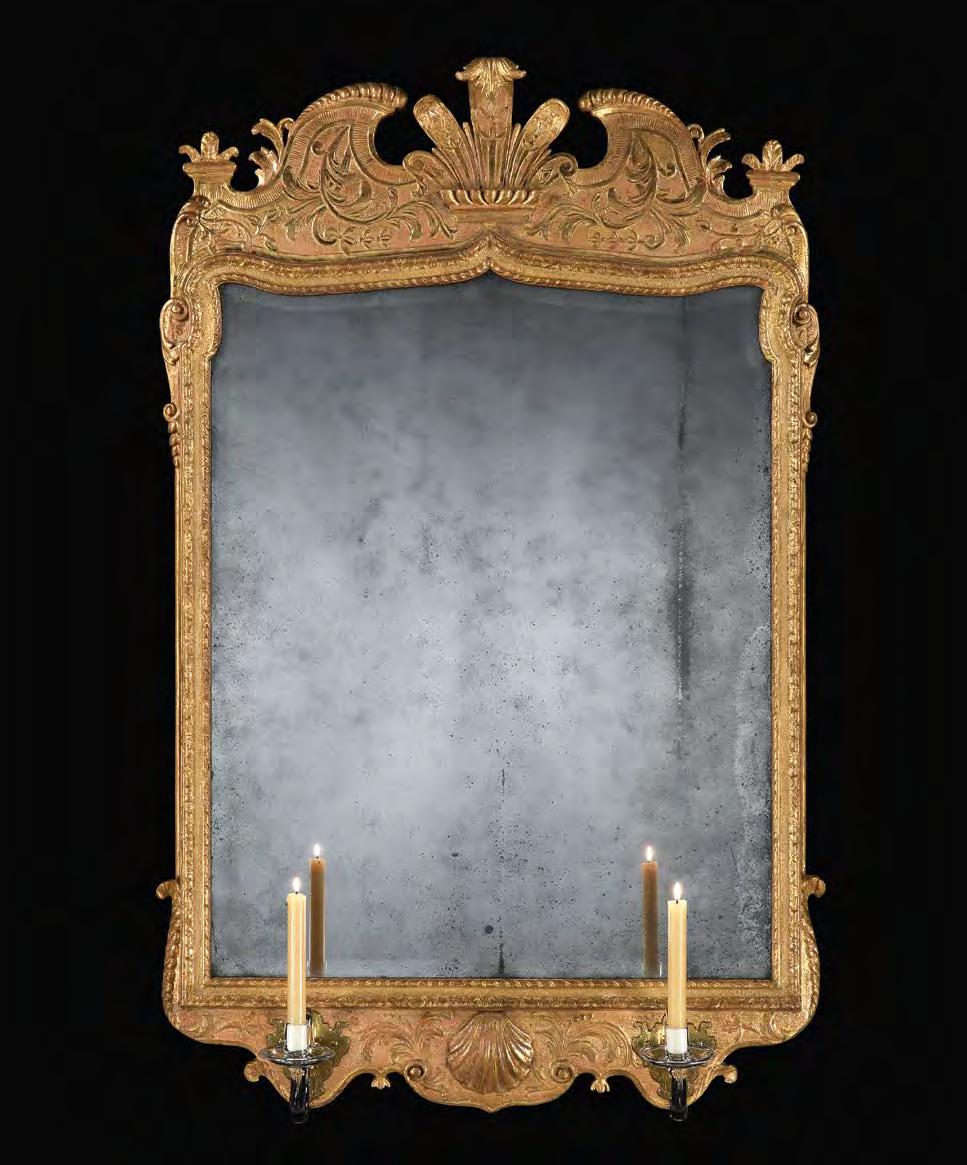

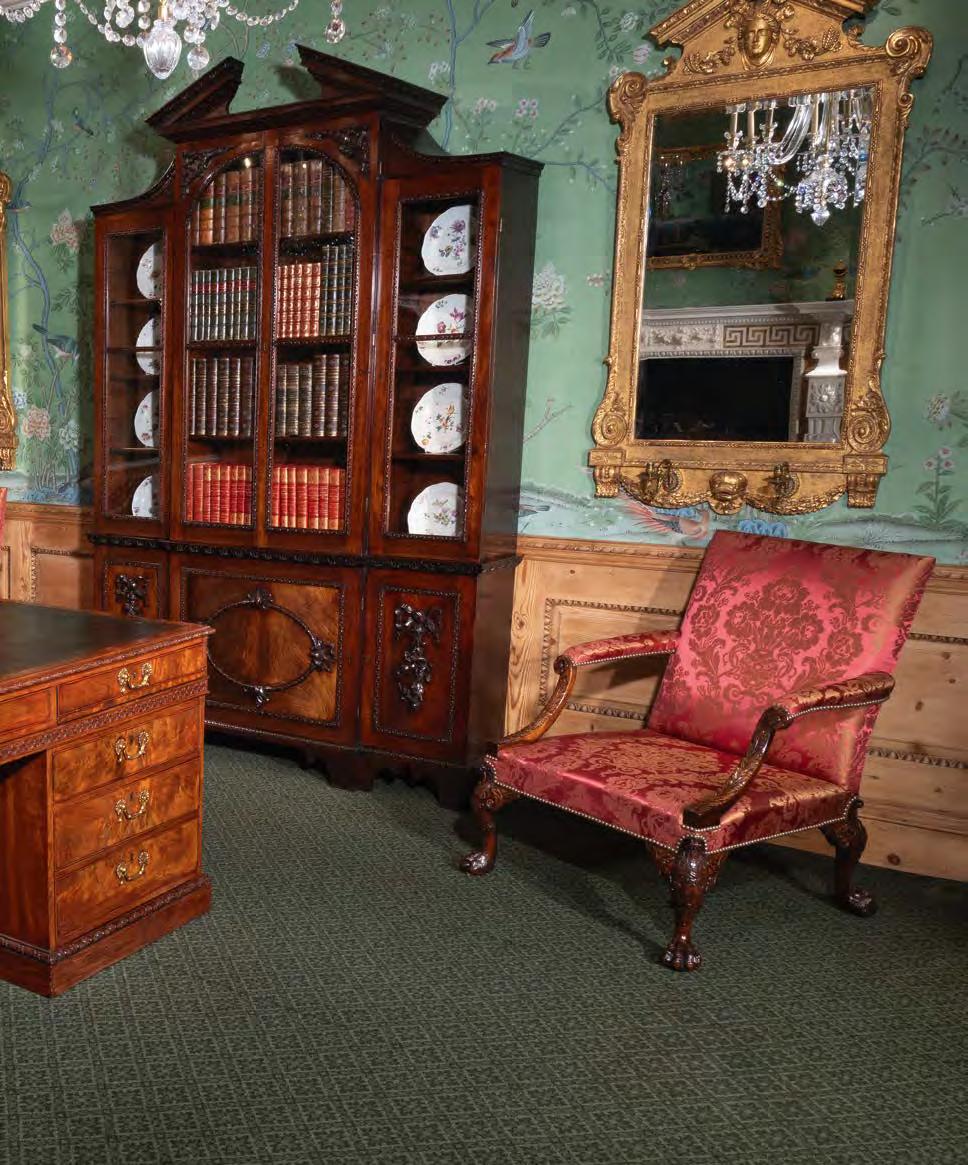
Note: The cabinet retains the original brass grilles. The brass handles to the drawer are of later date, and the feet have been tipped. The interior is fitted with one adjustable shelf.
English, circa 1790
Height: 37½ in; 95.5 cm
Width: 42¾ in; 108.5 cm
Depth: 10 in; 25.5 cm
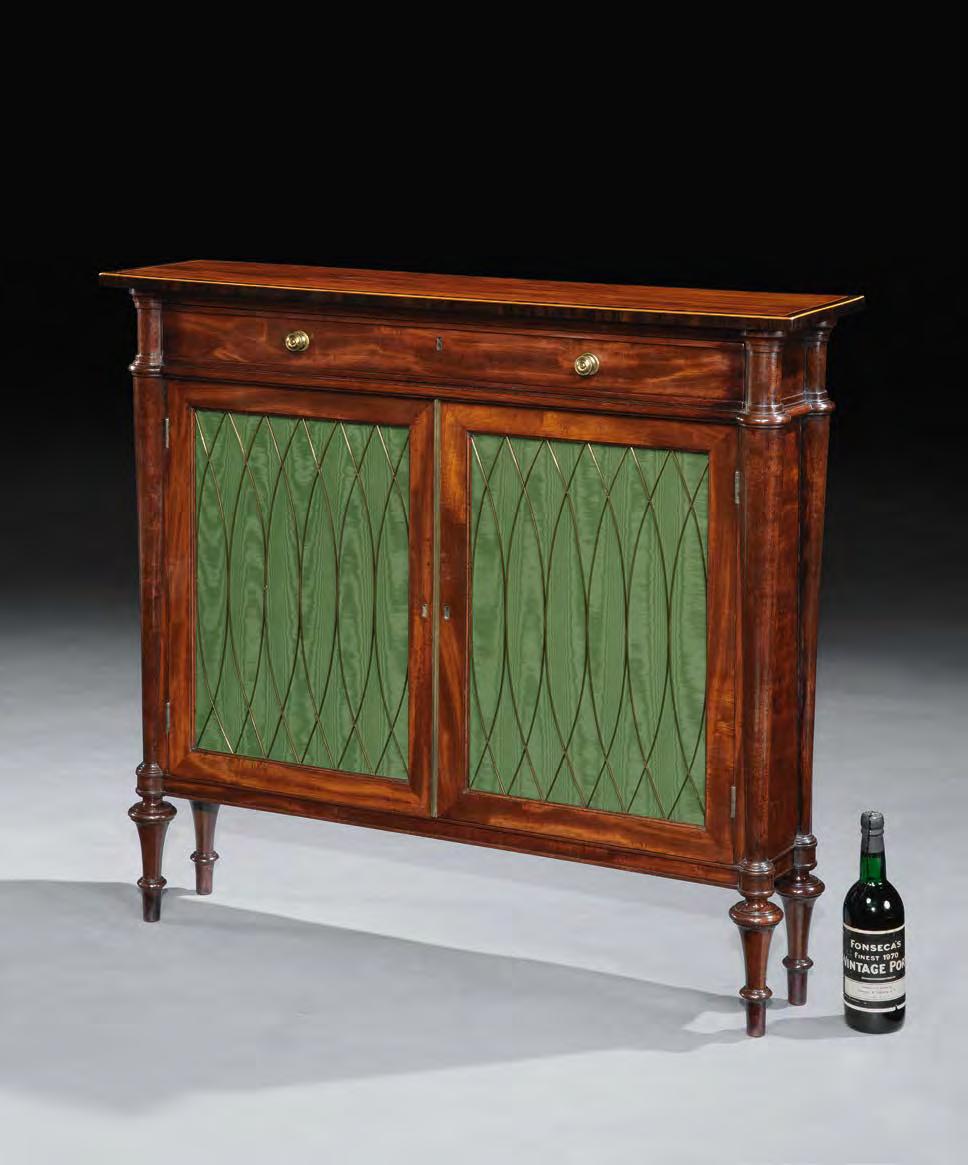

A REGENCY MAHOGANY CIRCULAR EXTENDING DINING TABLE
Note: The extending leaves are original. The bearers have at some stage been replaced. The brass cap castors are original.
English, circa 1815
Height: 2 ft 4½ in; 72.5 cm
Diameter (with leaves): 6 ft 3 in; 190.5 cm
Diameter (without leaves): 5 ft; 152.5 cm
Provenance: Private collection, London.
Literature: Ronald Phillips Ltd., ‘Fine Antique English Furniture’, catalogue, 2003, pp. 82–3; a very similar table.



44
A SET OF EIGHT GEORGE III MAHOGANY ARMCHAIRS
Note: The caned seat panels have been renewed at some stage.
English, circa 1790
Height: 32¼ in; 82 cm
Height of seat: 18¾ in; 47.5 cm
Width: 21½ in; 54.5 cm
Depth: 23 in; 58.5 cm
Provenance: Private collection, Canada.
Literature:
Christopher Claxton Stevens and Stewart Whittington, 18th Century English Furniture: The Norman Adams Collection, 1983, p. 89.
This unusually fine set of chairs features well carved detail and skilfully engineered construction which uses the pressure applied when they are sat on to give them extra strength. This is achieved by rotating the back uprights outwards, thus forming a continuous curve in line with the cresting. The arms descend in a long downwards sweep from where they are joined to the top of the uprights, then curve outwards and back, and down towards the sides of the seat front, where they form turned balusters and join the sides in blocks.
A single armchair of identical construction with a variant back is illustrated in 18th Century English Furniture: The Norman Adams Collection
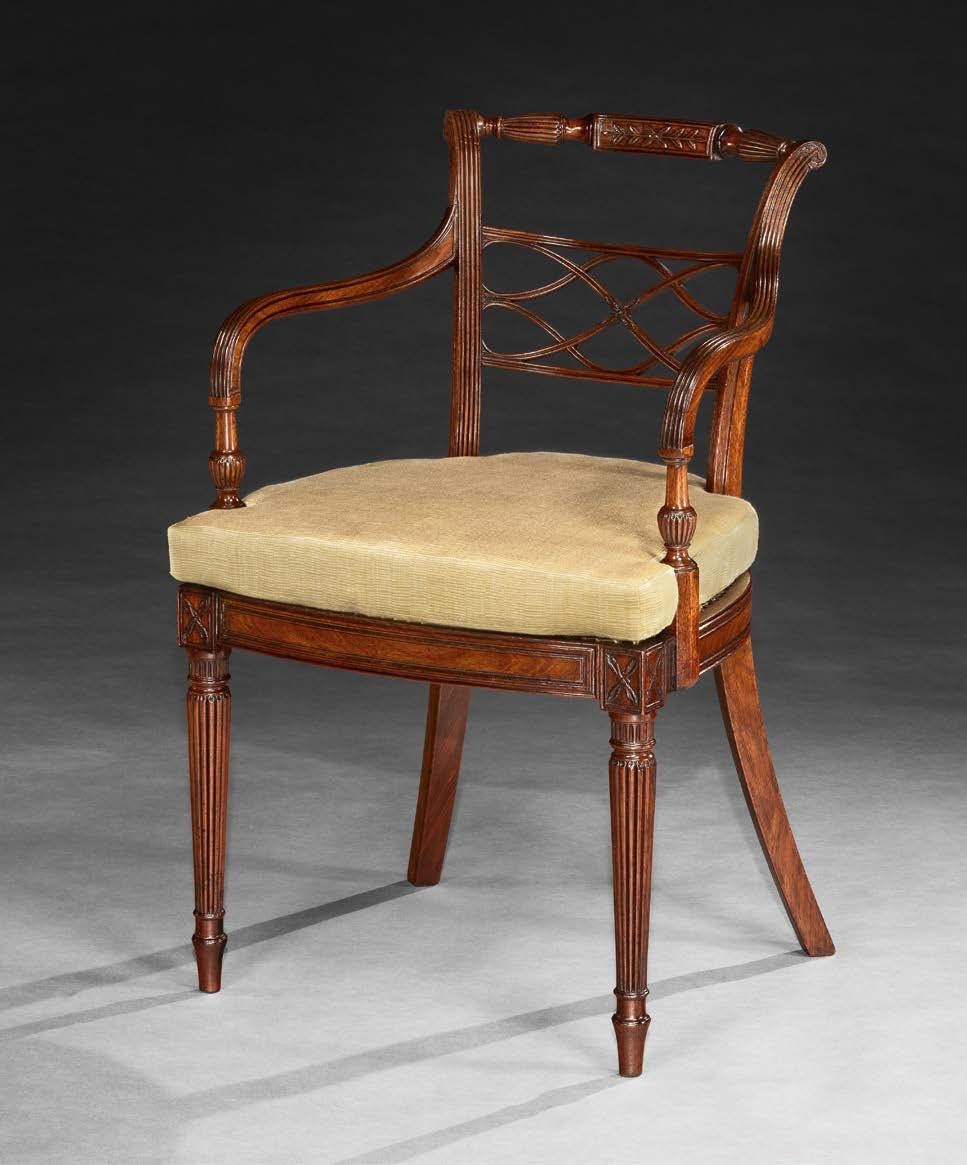
45 A PAIR OF GEORGE III GILTWOOD MIRRORS WITH BRACKETS
Note: The frames have been re-gilded and retain some of the original mirror plates, with some 18th century replacements.
English, circa 1770
Height: 42½ in; 108 cm
Width: 28¾ in; 73 cm
Depth: 4¾ in; 12 cm
Provenance: Private collection, England.




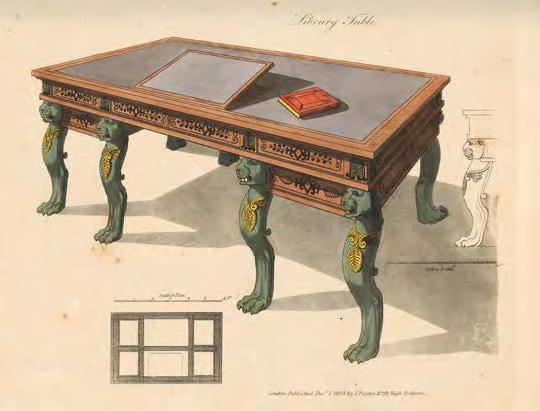
A related design for the monopodia from George Smith, A Collection of Designs for Household Furniture and Interior Decoration, 1808, pl. 87
46
Note: The cabinets retain most of the bronze painted surface. The Roman ‘Baixas Breccia’ marble tops are of later date. Each cabinet is fitted with one adjustable shelf.
English, circa 1815
Height: 35¼ in; 89.5 cm
Width: 41 in; 104 cm
Depth: 13 in; 33 cm
Literature: George Smith, A Collection of Designs for Household Furniture and Interior Decoration, 1808, pl. 87.
These cabinets with their striking simulated bronze monopodia are strongly influenced by the designs of George Smith (c.1786–1826). Smith’s designs were widely distributed in his pattern book of 1808, A Collection of Designs for Household Furniture and Interior Decoration, in which he proudly declared himself the ‘upholder extraordinary to his Royal Highness the Prince of Wales’. Plate 87 in his book displays a library table with very similar monopodia supports.



47
The paintings: Chinese, circa 1800, oil on canvas
The giltwood frames: English, mid 20th century
Height: 39¼ in; 99.5 cm
Width: 53¼ in; 135.5 cm
Provenance: Private collection, Hong Kong.
Each painting depicts a group of Chinese people in traditional costume beside a winding river, probably the Yangtze. One painting represents summer and the other winter. Examples of the latter are extremely rare.
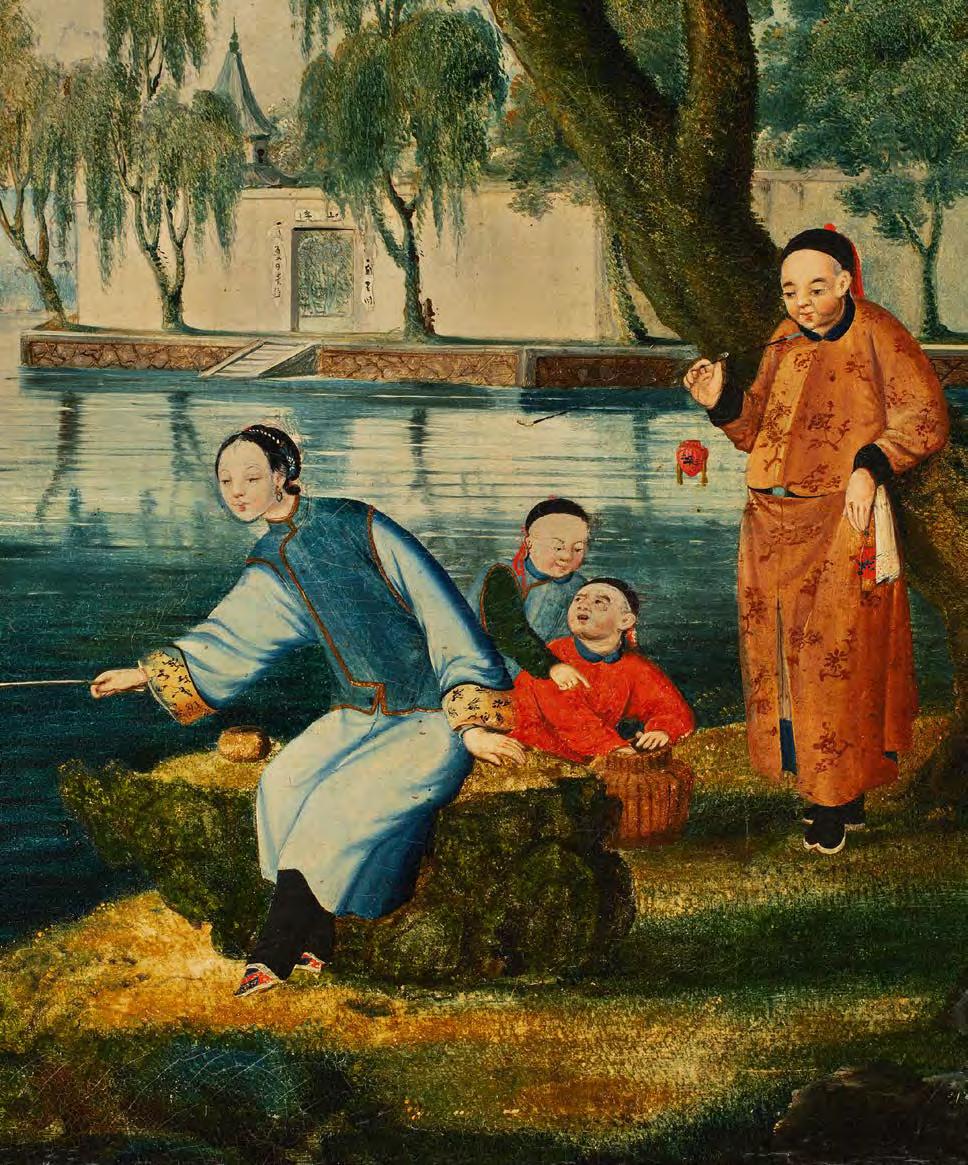



48
A PAIR OF REGENCY PARCEL GILT AND BRASS INLAID ROSEWOOD CONSOLE TABLES
Note: The tables retain their original finely chased ormolu mounts and some of the original gilding. The verde antico marble tops and mirror plates are of later date. The tables were at some stage possibly fitted to the wall.
English, circa 1815
Height: 37¾ in; 96 cm
Width: 54¾ in; 139 cm
Depth: 15½ in; 39.5 cm
Provenance: John Keil Ltd., London, England; Private collection, USA.
Exhibited:
The Grosvenor House Antiques Fair, London, 1989; with John Keil Ltd.
Illustrated:
The Grosvenor House Antiques Fair handbook, 1989, pp. 130–31; with John Keil Ltd.
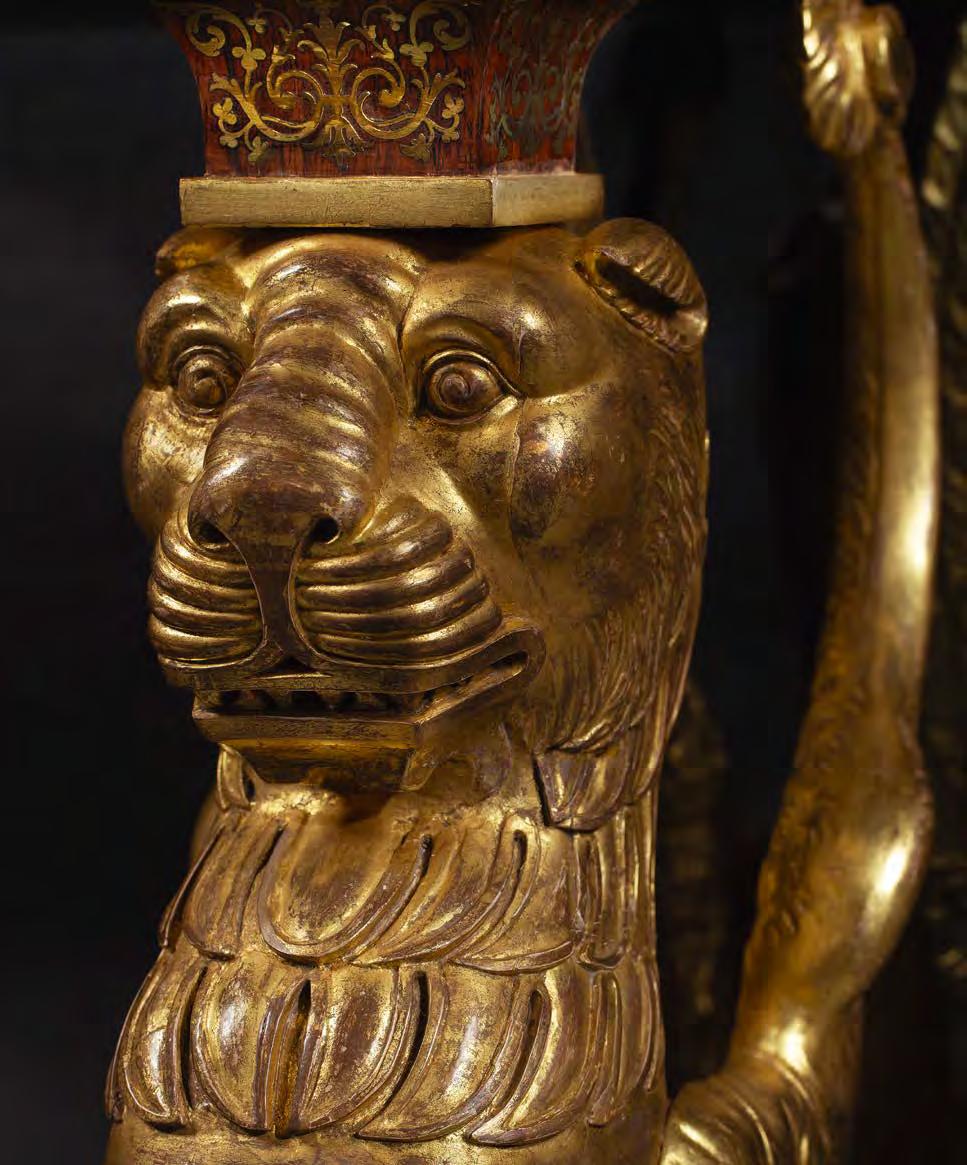
Note: The mirror retains much of the original gilding and bronze paint and the original mercury silvered convex mirror plate.
English, circa 1815
Height: 5 ft 2 in; 157.5 cm
Width: 3 ft 6½ in; 108 cm
Depth: 1 ft 1 in; 33 cm
Provenance: Stair & Company, London, England; Private collection, London, England.


A GEORGE III BRASS MOUNTED MAHOGANY GAMES TABLE
Note: The leather insert to the reversible top is of later date. The backgammon leather insert is original. The table retains its original brass gallery, handles and unusually tall castors.
English, circa 1805
Height: 29½ in; 75 cm
Width: 35½ in; 90 cm
Depth: 19 in; 48 cm
Provenance: Private collection of Tom Devenish, New York, USA; By descent to Clive Devenish, USA.
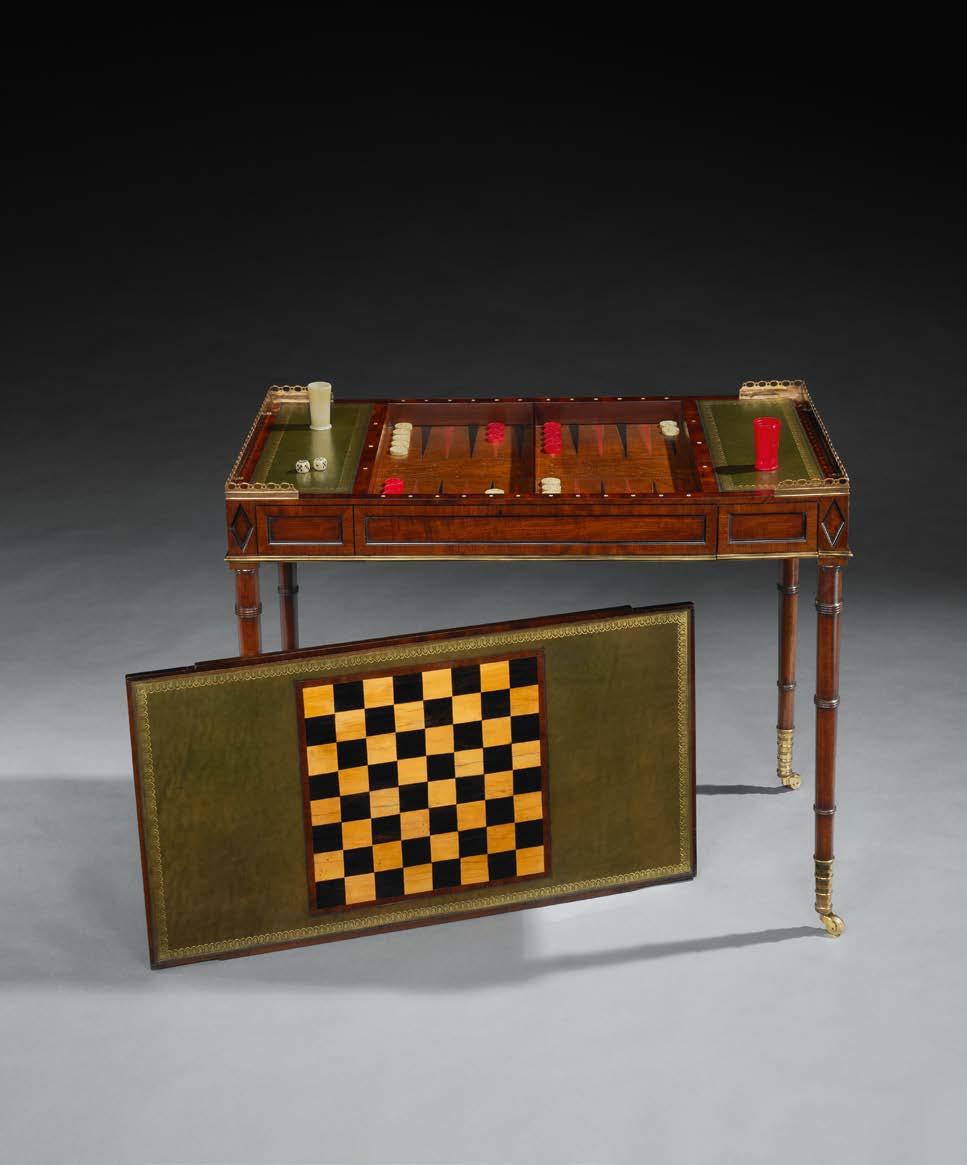
Note: The square glass bottles are of later date.
Irish, circa 1750
Height: 22 in; 56 cm
Width: 16¼ in; 41 cm
Depth: 16¼ in; 41 cm
The square outline of this stand is highly unusual, as is its capacity for just four decanters. Most Irish decanter stands are oblong in shape and are designed to hold six or more decanters.


52
A GEORGE III GILTWOOD OVAL OVERMANTEL MIRROR
Note: The mirror retains much of the original gilding and the original re-silvered mirror plate.
English, circa 1765
Height: 33½ in; 85 cm
Width: 38 in; 96.5 cm
Provenance: Mallett & Son Ltd., London, England; Private collection, Ireland.
Illustrated: Country Life, 2 August 1956, p. 259; advertisement with Mallett & Son Ltd.


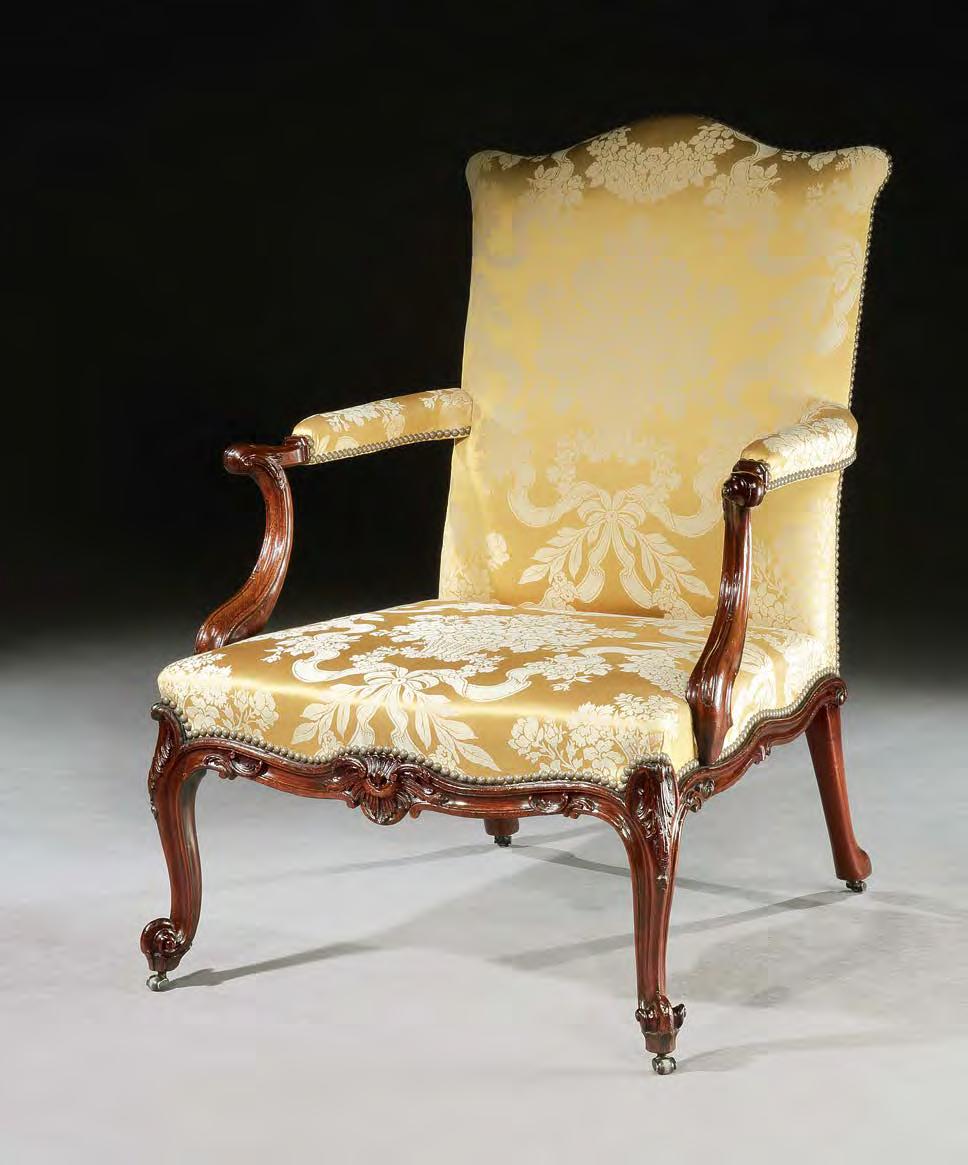
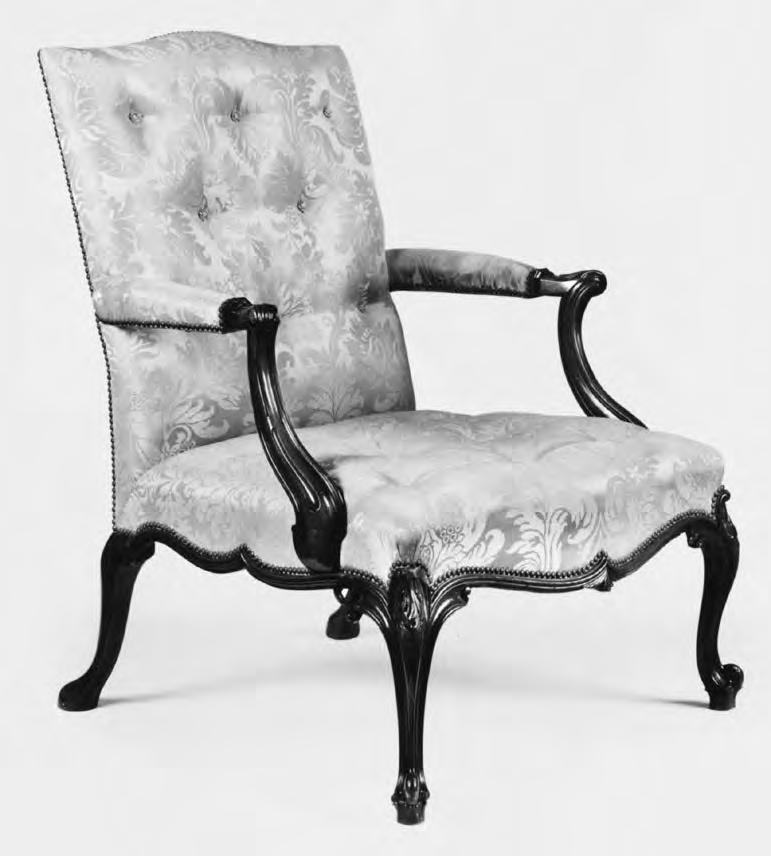
53
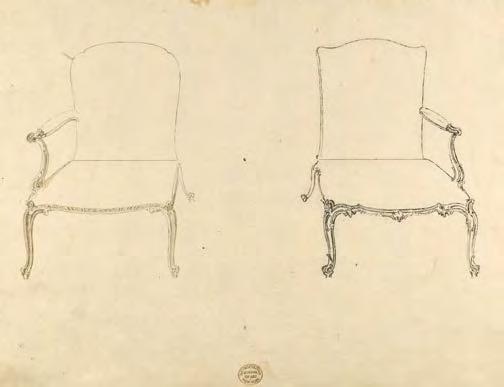
Drawing by Thomas Chippendale. The Metropolitan Museum of Art, 2014/Art Resource/Scala, Florence
A PAIR OF GEORGE III MAHOGANY LIBRARY ARMCHAIRS ALMOST CERTAINLY BY THOMAS CHIPPENDALE
English, circa 1770
Height: 41¼ in; 105 cm
Height of seat: 17 in; 43 cm
Width: 30¼ in; 77 cm
Depth: 32 in; 81.5 cm
Provenance:
Fogg Art Museum, Boston, USA, until 1987; Hotspur Ltd., London, England, 1988; Private collection, England.
Literature:
Christopher Gilbert, The Life and Work of Thomas Chippendale, 1978, vol. II, pp. 132–3.
Christie’s, ‘Dumfries House – A Chippendale Commission’, sale catalogue, 12–13 July 2007, vol. I, pp. 174–85, lots 50–52.
Christie’s, ‘Régence to Fabergé – An Apartment by Jed Johnson’, sale catalogue, 20 May 2010, pp. 54–5, lot 85.
The chairs would originally have formed part of a larger set or suite, like most commissions by Chippendale. They have acquired a wonderful surface over the years, and the bold yet highly accomplished carved detail leaves little doubt about their authorship. The harmonious design of these chairs is characteristic of pieces by the Chippendale firm, but was achieved by few other workshops of the 18th century.
The design for these chairs is preserved as an unpublished drawing by Thomas Chippendale in the Metropolitan Museum of Art in New York. The fact that it is unpublished supports a Chippendale manufacture, as it excludes other workshops who subscribed to Chippendale’s The Gentleman and Cabinet-maker’s Director and copied its designs. Chippendale also never precisely repeated his designs, but modified them each time with subtle yet noticeable changes, thus keeping each commission individual.
A similar model also based on the unpublished drawing was produced for William, 5th Earl of Dumfries in Scotland. The general outline of the Dumfries suite, which is fully documented and retained at Dumfries, is virtually identical, but slight changes to the front rail, the shape of the back and some of the carved detail make both models unique.
Another chair from the same set, formerly with Hotspur Ltd., London, England, was until recently in a private collection in New York.
Note: The drawers retain all their original pierced brass plate handles and escutcheons.
English, circa 1750
Height: 33½ in; 85 cm
Depth: 47¼ in; 120 cm
Depth: 24¾ in; 63 cm
Provenance:
Private collection, England.
The arrangement of six short over two long drawers is unusual and was probably a special commission. The craftsmanship on this chest is exceptional, with finely executed re-entrant corners and a gentle serpentine front. The feet are blocked and there is a red wash to the underside. All these attributes point to the Chippendale workshop. The original pierced plate handles are slightly earlier in style, however, and they do not feature in Chippendale’s repertoire of handles. The maker of this exceptional piece is therefore yet to be established.
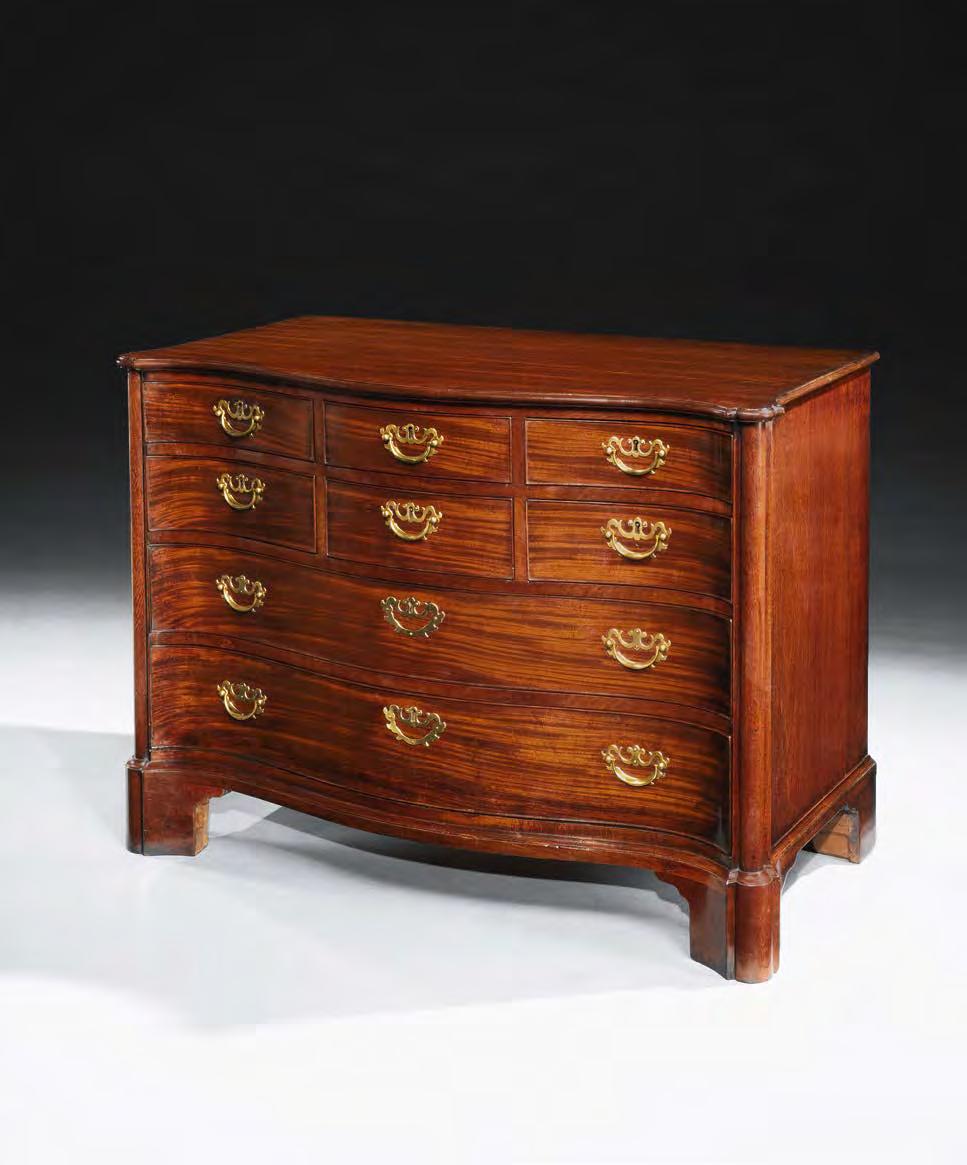



55
The chairs: English, circa 1730
The needlework covers: French, circa 1720
Height: 37½ in; 95 cm
Height of seat: 18 in; 46 cm
Width: 28½ in; 72.5 cm
Depth: 26½ in; 67.5 cm
Provenance: Olive, Lady Baillie, Leeds Castle, Kent, England; Private collection, USA.

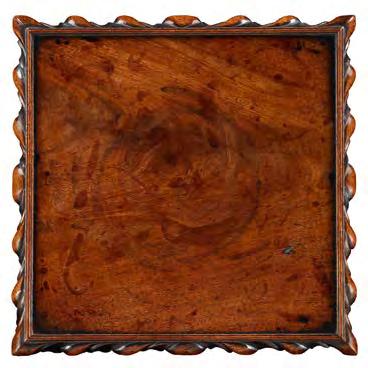
56
English, circa 1750
Height: 28½ in; 72.5 cm
Width: 19 in; 48.5 cm
Depth: 17 in; 43 cm
Provenance: Andrew G. Kurtz, Liverpool, England; Hotspur Ltd., London, England, until 1993; The Hon. Simon Sainsbury, London, England; Ronald Phillips Ltd., London, England; Private collection, USA.
Illustrated: Christie’s, ‘Furniture, Sculpture and Carpets’, London, sale 7611, sale catalogue, 11 September 2008, lot 209. Ronald Phillips Ltd., ‘18th Century Tripod Tables’, catalogue, 2014, p. 53, fig A7.


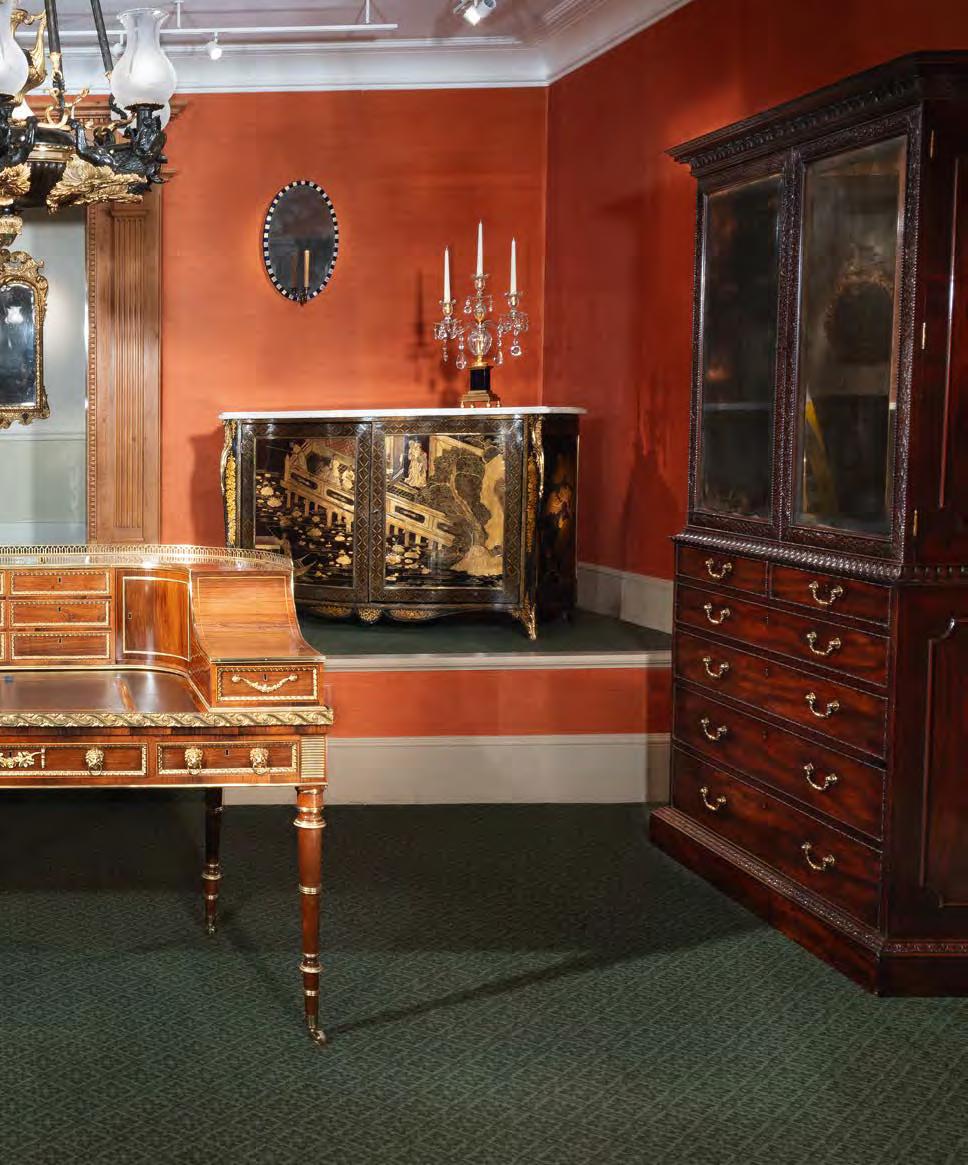
Note: The back rail has a typed paper label pasted to the inside for ‘Phillips of Hitchin’.
English, circa 1765
Height: 38¼ in; 97.5 cm
Height of seat: 18½ in; 47 cm
Width: 25¾ in; 65.5 cm
Depth: 23¾ in; 60 cm
Provenance:
Phillips of Hitchin, Hertfordshire, England; Private collection, Yorkshire, England.
The maker of this armchair has not been identified, but other virtually identical chairs by the same hand are known, and on all of them the carving is especially good. The arm supports on this chair feature fine trailing acanthus leaf.
A set of chairs from the same workshop was illustrated in Ronald Phillips Ltd.’s ‘Great English Furniture 2021’, pp. 140–41.

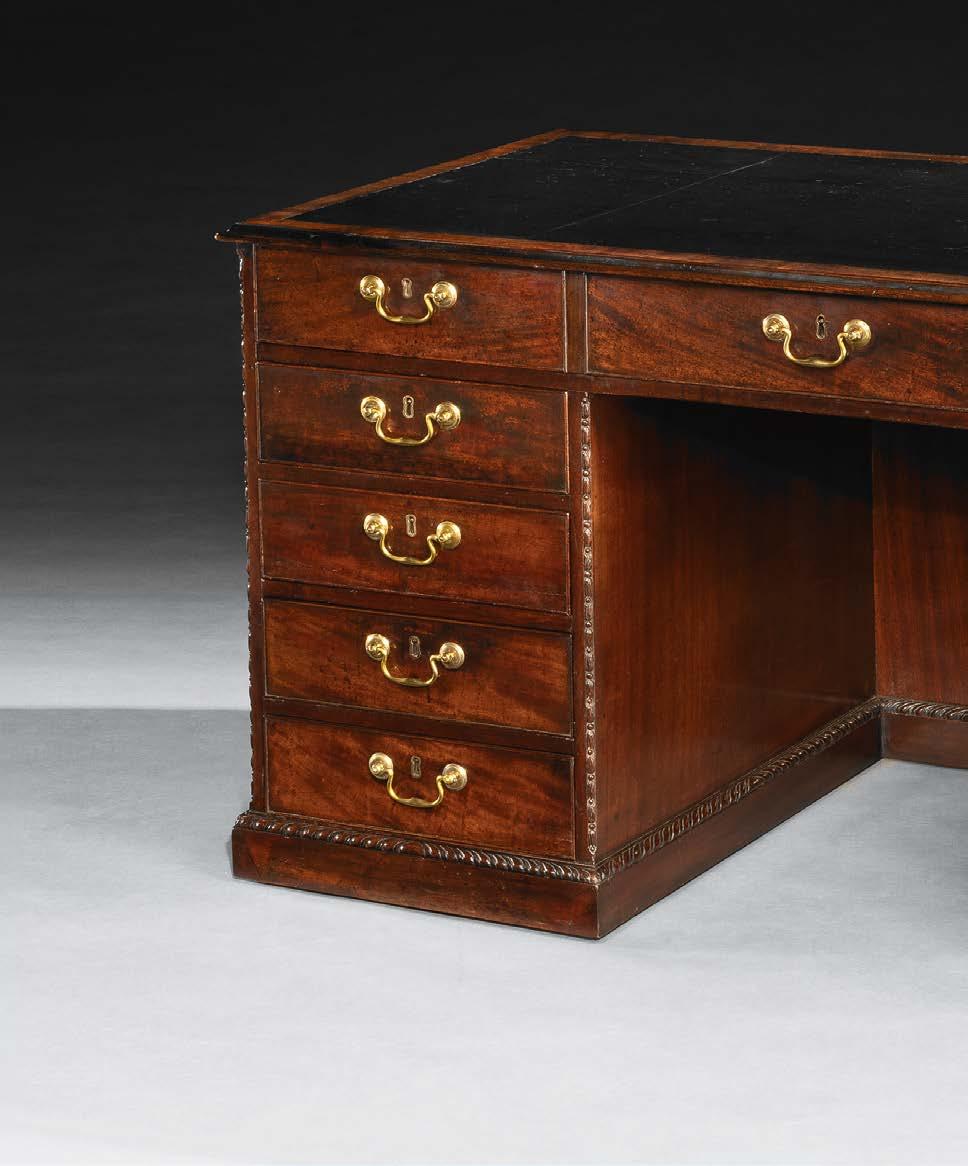


58
A GEORGE III MAHOGANY PEDESTAL DESK ATTRIBUTED TO WILLIAM VILE
Note: The desk retains all the original ornate brass handles and the original leather insert on the brushing slide. The leather on the top is a later replacement. The desk does not consist of separate pedestals and top, but is constructed all in one piece.
The continuous plinth on the reverse side was cut at some stage, probably when the kneehole cover panel on the reverse side was removed. Both plinth and cover panel have now been reinstated, using period timbers and veneers.
English, circa 1765
Height: 29½ in; 75 cm
Height of kneehole: 23½ in; 59.5 cm
Width: 55 in; 140 cm
Width of kneehole: 20 in; 51 cm
Depth: 26¾ in; 68 cm
Provenance: Abraham Simon Wolf Rosenbach and his brother, Philip Rosenbach, Philadelphia, USA.

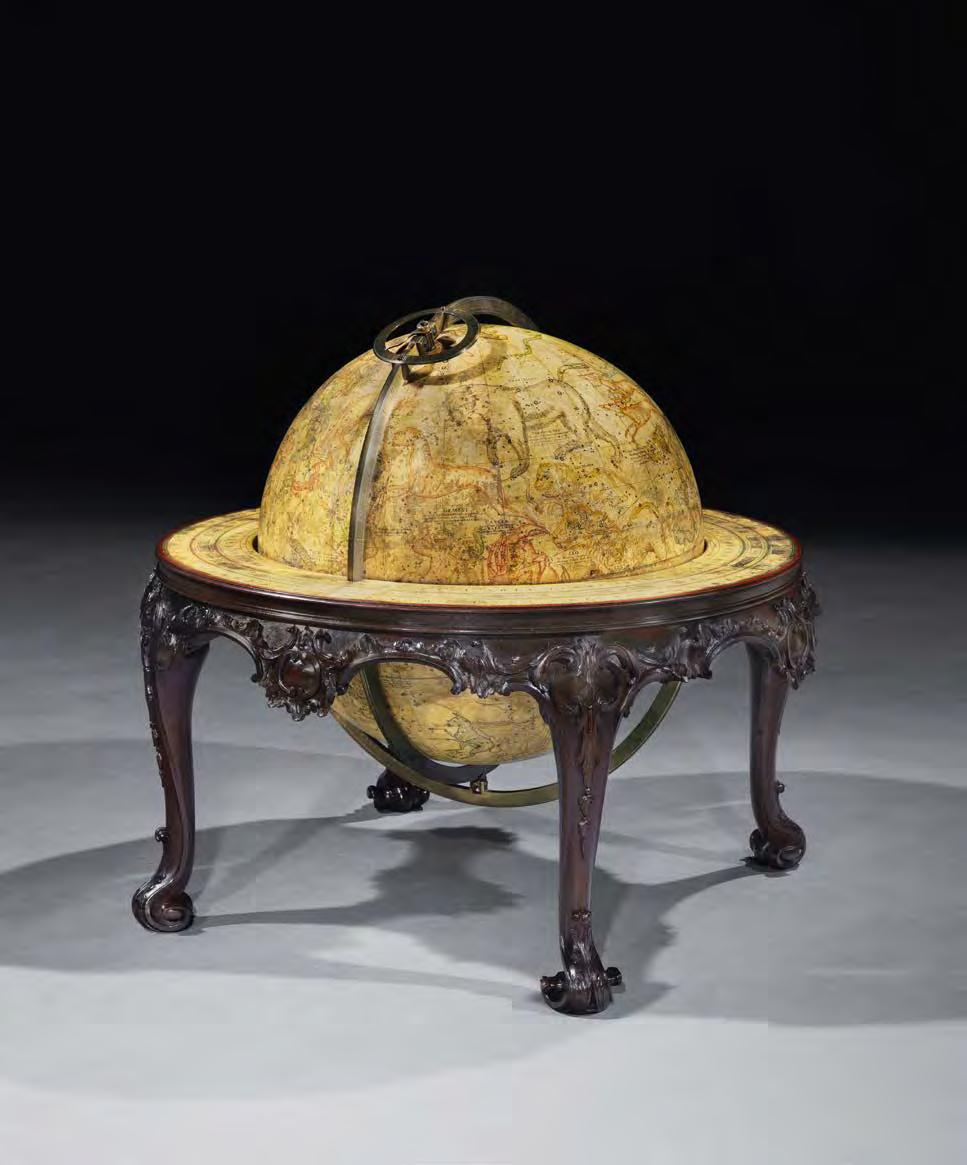

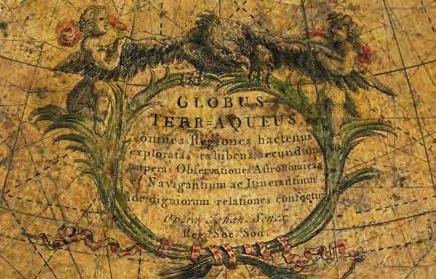
59
A
The globes: English, dated 1740
The stands: English, circa 1755
Height (on stand): 23¼ in; 59 cm
Diameter (across legs): 26¼ in; 66.5 cm
Provenance:
Robert Hampden-Trevor, 1st Viscount Hampden (1706–1783), for Hampden House, Buckinghamshire, England;
By descent to the Earls of Buckinghamshire, Hampden House, Buckinghamshire, England, until; Curtis & Henson and Hamnett, Raffety & Co., ‘Hampden House, Buckinghamshire’, 17–22 April 1939, lot 457; Private collection, England.
Literature:
An Inventory and Valuation for Probate of Furniture, Paintings and other Effects being in Hampden House, Great Missenden, the property of the Executors of the Right Hon.able and Reverend the Earl of Buckinghamshire, 1887, ‘pair of globes on stands’ and listed in the Old Library. An Inventory of Furniture, Paintings and other Effects being in Hampden House, Great Missenden, Bucks, July 1887, ‘pair of Globes on carved mahogany stands with leather covers’ and listed in North East Wing Old Library.
Curtis & Henson and Hamnett, Raffety & Co., ‘Hampden House, Buckinghamshire’, sale catalogue, 17–22 April 1939, lot 457 listed in the Great Hall, ‘A pair of globes, 18th century, celestial and terrestrial, painted with emblems and signs, and revolving on Early Chippendale mahogany stands, which are carved in relief foliage, and each standing on scroll legs with “fiddle head” terminals, 24in. diam.’
John Senex (1678–1740) was one of the leading cartographers of his time. After Senex’s death, James Ferguson acquired his copper plates for the gores (the flat printed maps that can then be shaped to fit a globe) at auction. The plates then passed to Benjamin Martin and subsequently to Dudley Adams who published a new edition of Senex’s globes in 1793.
A comparable pair of globes, formerly the property of the Earl of Hardwicke of Wimpole Hall, Cambridgeshire, are now in the collection at the National Maritime Museum, Greenwich, London.
The carved mahogany stands were added to these globes some fifteen years later when they were in the possession of the 1st Viscount Hampden.
A Dudley Adams terrestrial globe with Senex gores circa 1740 and updated by Adams in 1793 is in the collection of All Souls College, Oxford.
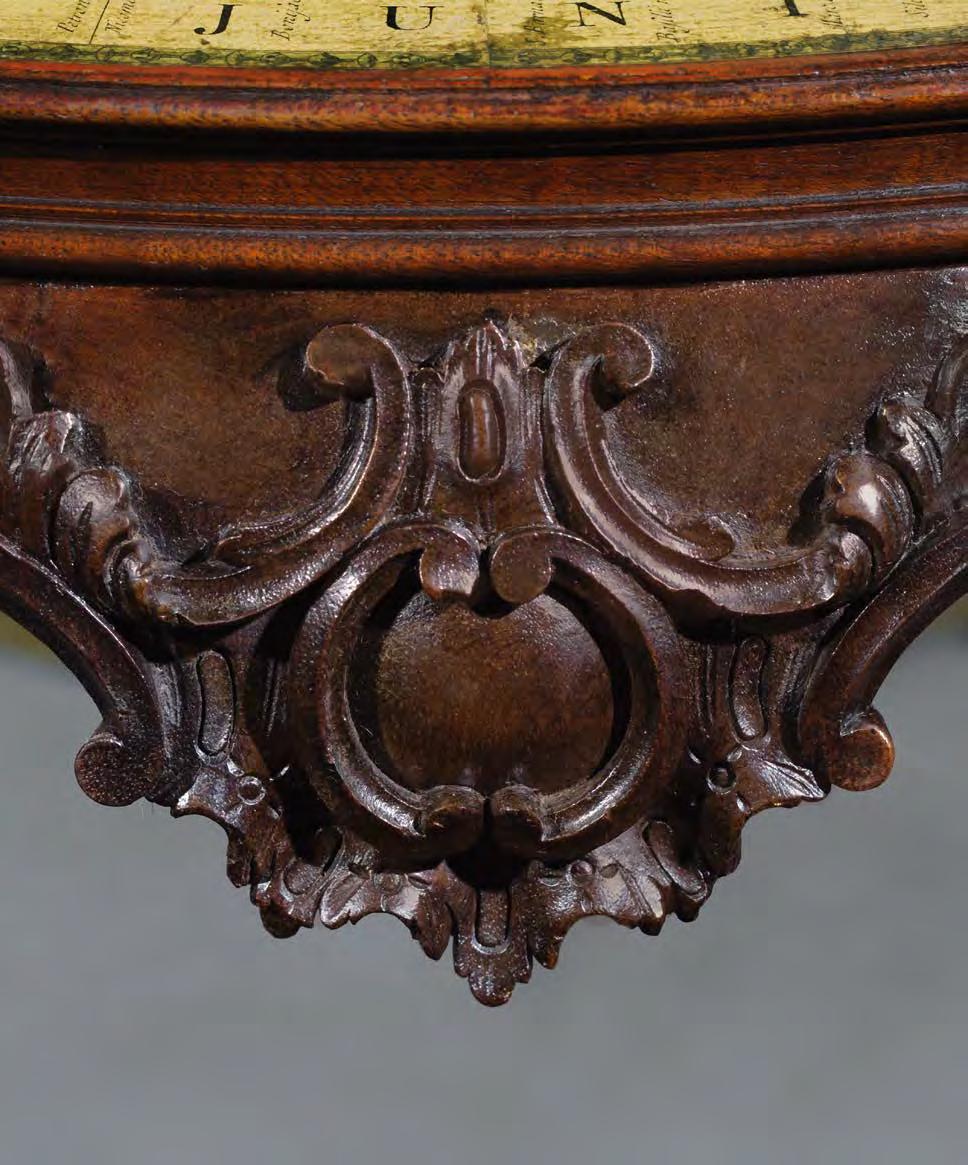
A LOUIS XVIII PATINATED BRONZE MODEL OF A GREYHOUND ON A MARBLE
French, circa 1820
Height: 13¼ in; 33.5 cm
Width: 24½ in; 62.5 cm
Depth: 9¼ in; 23.5 cm
Provenance: Ronald Phillips Ltd., London, England; His Grace the Duke of Westminster, London, England.

A REGENCY MAHOGANY LIBRARY TABLE
BY JOHN SYERSNote: The table retains the original brass handles. The gold tooled black morocco leather insert is of later date.
English, circa 1815
Height: 2 ft 5½ in; 75 cm
Knee height: 2 ft; 60.5 cm
Width: 6 ft 1¾ in; 186 cm
Depth: 3 ft 7½ in; 110.5 cm
Literature: Christopher Hussey, English Country Houses, Late Georgian 1800–1840, 1958, pp. 91–102.
This impressive writing table is one of three known examples. One table was formerly in the collection of the Earls of Jersey at Middleton Park, Oxfordshire. The third table was supplied by John Syers in 1813 to the recently refurbished Library at Broughton Hall, Yorkshire. The archives at Broughton retain Syers’s invoice to Stephen Tempest for the sum of £34 18s.




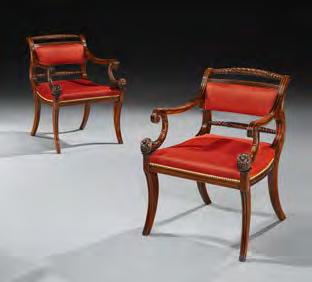
Note: Each chair is stamped to the underside, one ‘CH’, the other ‘FF’. English, circa 1815
Height: 32¾ in; 83 cm
Height of seat: 18 in; 45.5 cm
Width: 24¼ in; 62 cm
Depth: 27 in; 68.5 cm
Provenance: Ronald Phillips Ltd., London, England; Private collection, Chicago, USA.
The Gillow family business had showrooms in Lancaster as well as in London. These two retail outlets required an extremely well organised workforce, with the firm’s own cabinet-making workshops in London, Liverpool and Manchester employing hundreds of workmen, as well as outside workshops trained in ‘the Gillow way’. These outside workshops could be called upon if demand exceeded Gillows’ own resources, or for repeat orders.
To keep track of who made certain pieces of furniture, mostly chairs or pieces made in larger numbers, a system of marks was adopted, similar to that of Giles Grendey over a century earlier.
The journeymen working for the firm would punch their initials into the surface of a discreet area such as the inside or underside of a chair rail, or the inside of a leg at the top, visible only when the chair is turned upside down.
The system was simple but very efficient. For every new chair order, a detailed drawing or measured sketch was given to the journeyman who was to make the chair. These sketches were then kept by the journeyman, and if the client subsequently wanted more of the same chair, the original journeyman would work from the same drawings to create precise copies.
CH, as stamped on one of these chairs, are the initials of Christopher Hodgson, a chair-maker of Liverpool who had trained in Lancaster, becoming free in 1789/90. He was one of Gillows’ trusted external workmen.
There is no record of an ‘FF’ in the Gillows archives. This could mean that FF was a secondgeneration worker who was trained not by Gillows directly, but by one of their former trainees, in this case Christopher Hodgson.
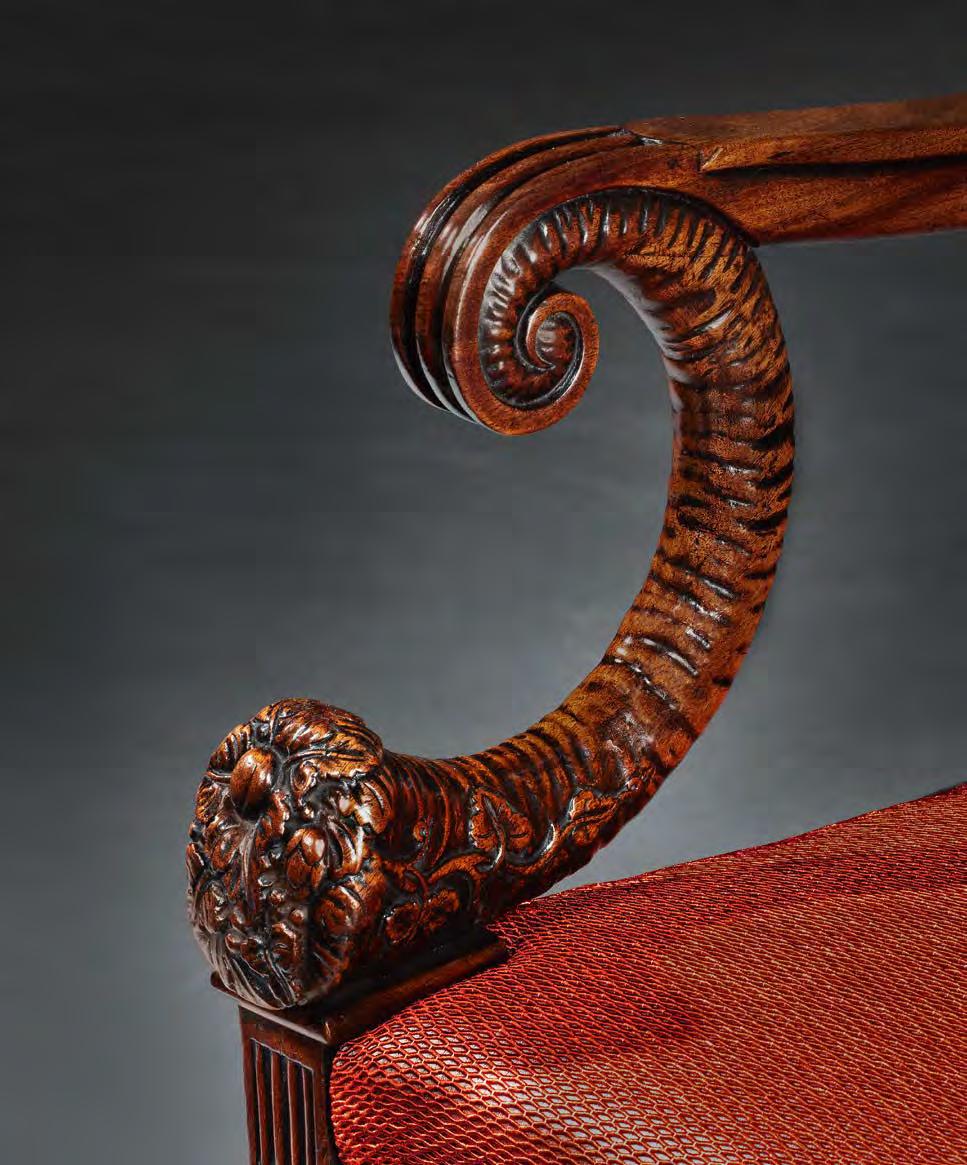
A GEORGE III MAHOGANY DRUM TABLE
Note: Some handles are of later date. The brass castors are original. The leather insert is a 19th century replacement. English, circa 1790
Height: 29¼ in; 74.5 cm
Diameter: 44½ in; 113 cm
Provenance: Ronald Phillips Ltd., London, England; Mallett & Son Ltd., London, England; Private collection, USA.
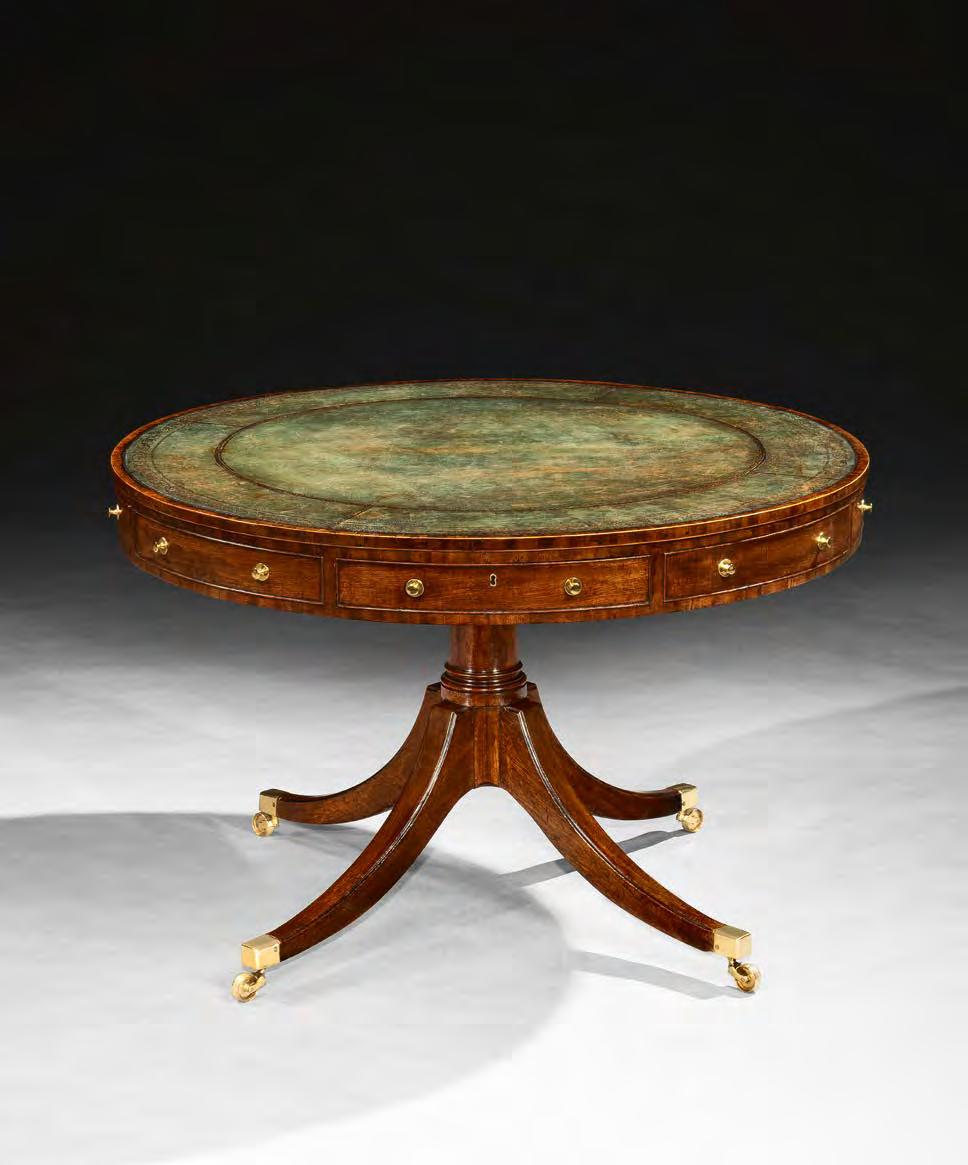

Note: The frame has been re-gilded at some stage. The mirror plates are of later date.
English, circa 1775
Height: 47¼ in; 120 cm
Width: 38 in; 96.5 cm


A PAIR OF LOUIS XVI ORMOLU MOUNTED STATUARY MARBLE VASES WITH COVERS, ATTRIBUTED TO PIERRE PHILIPPE THOMIRE
French, circa 1785
Height: 12½ inches; 32 cm
Width: 13 inches; 33 cm
Depth: 5¼ inches; 13.5 cm
Provenance: Röbbig München, Munich, Germany; Private collection, Germany.
These unusual oval vases are typical of the work of Thomire, who had established himself as the leading bronzeworker in Paris at the end of the 18th century. The retailer of these exceptional objects was without doubt Dominique Daguerre, who supplied not only
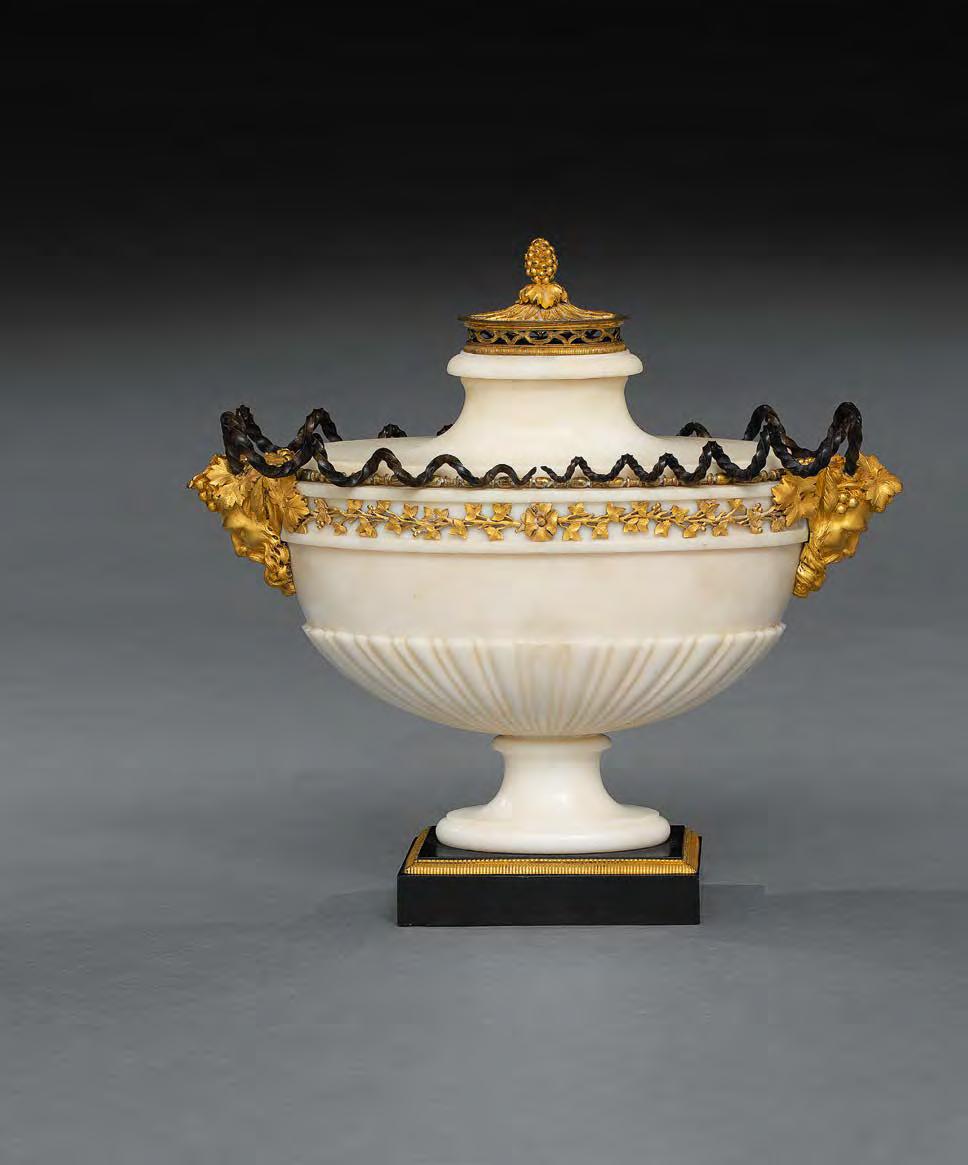
the French court but also commissions as far away as the Hermitage in Russia. The shape of this type of vase is often described as ‘Daguerre oval’.
The curled horn mounts can be found on several documented vases including examples in the Wallace Collection, London, and the Royal Collection. Another pair of oval figured marble vases with identical curled mounts were formerly in the collection of Lord Burton at Chesterfield House in London, where they were photographed in August 1886, displayed in the ballroom, and again in July 1887, this time in the dining room.
Note: The frame has been re-gilded.
English, circa 1760
Height: 2 ft 1½ in; 65 cm
Width: 6 ft 4½ in; 194.5 cm
Depth: 1 ft 10½ in; 57 cm
This bench is finished on all four sides. It was therefore designed to stand in the middle of a room or long gallery, not against a wall. With arm supports at each end, it could possibly be described as a window seat except for its unusual length. Window seats are generally much shorter.


67
A WILLIAM AND MARY SCARLET AND GILT JAPANNED BUREAU CABINET
English, circa 1690
Height: 8 ft 4 in; 254 cm
Width: 3 ft 5 in; 104 cm
Depth: 2 ft ¾ in; 63 cm
68
A PAIR OF GEORGE III PERIOD CHINESE EXPORT POLYCHROME DECORATED CLAY NODDING FIGURES
Chinese, Qianlong period, circa 1780
Female figure:
Height: 28 in; 71 cm
Width: 11½ in; 29 cm
Depth: 9¾ in; 25 cm
Male figure:
Height: 27 in; 68.5 cm
Width: 11½ in; 29 cm
Depth: 9½ in; 24 cm
69
A GEORGE III MAHOGANY HALL CHAIR
English, circa 1760
Height: 36½ in; 93 cm
Height of seat: 17¼ in; 44 cm
Width: 23½ in; 60 cm
Depth: 23½ in; 60 cm
70
A GEORGE II MAHOGANY TRIPOD TABLE
English, circa 1755
Height: 28 in; 71 cm
Diameter: 27 in; 68.5 cm

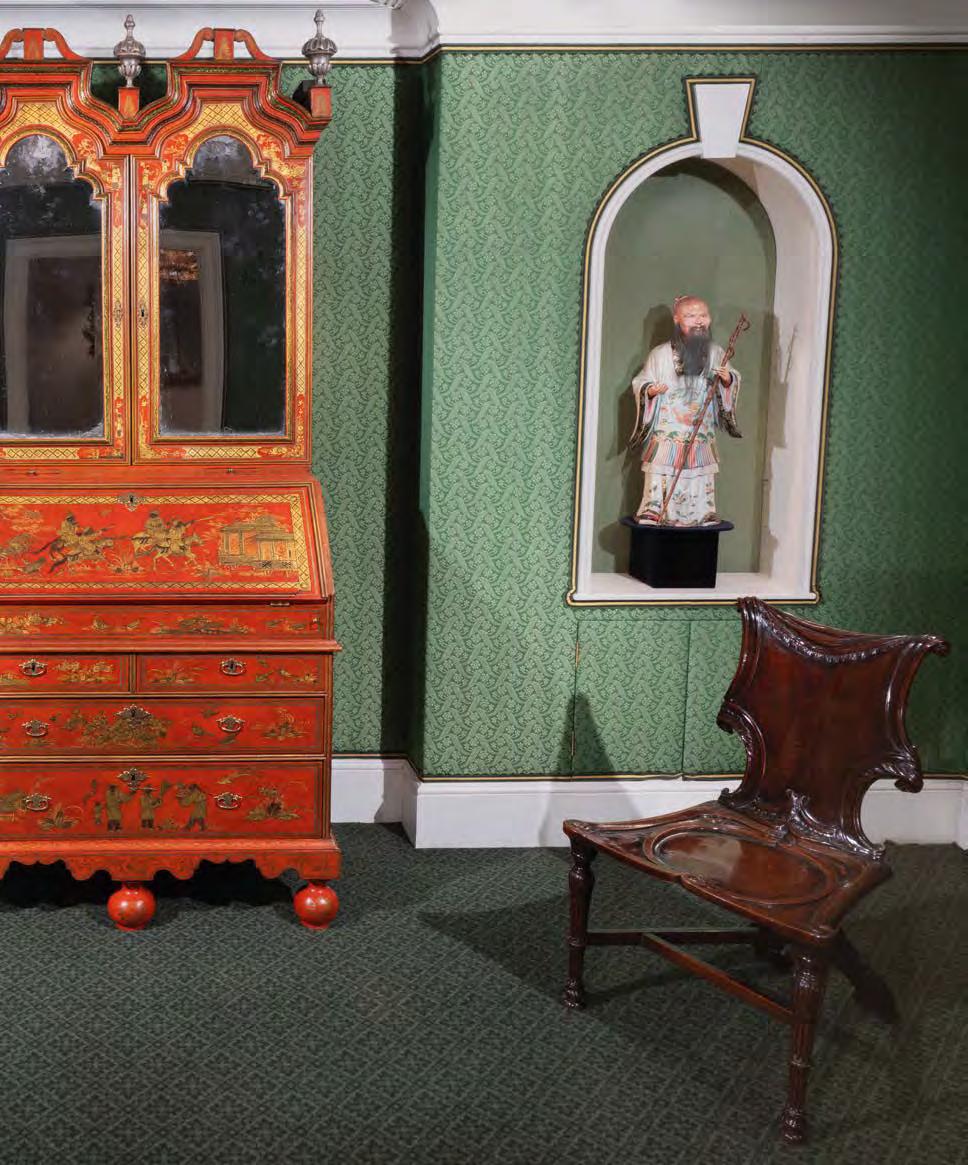
Note: The wine cooler retains the original brass mounts. The handles on each side are of later date. The fine inlay is an unusual feature.
English, circa 1755
Height: 8¼ in; 21 cm
Width: 17½ in; 44.5 cm
Depth: 9½ in; 24.5 cm
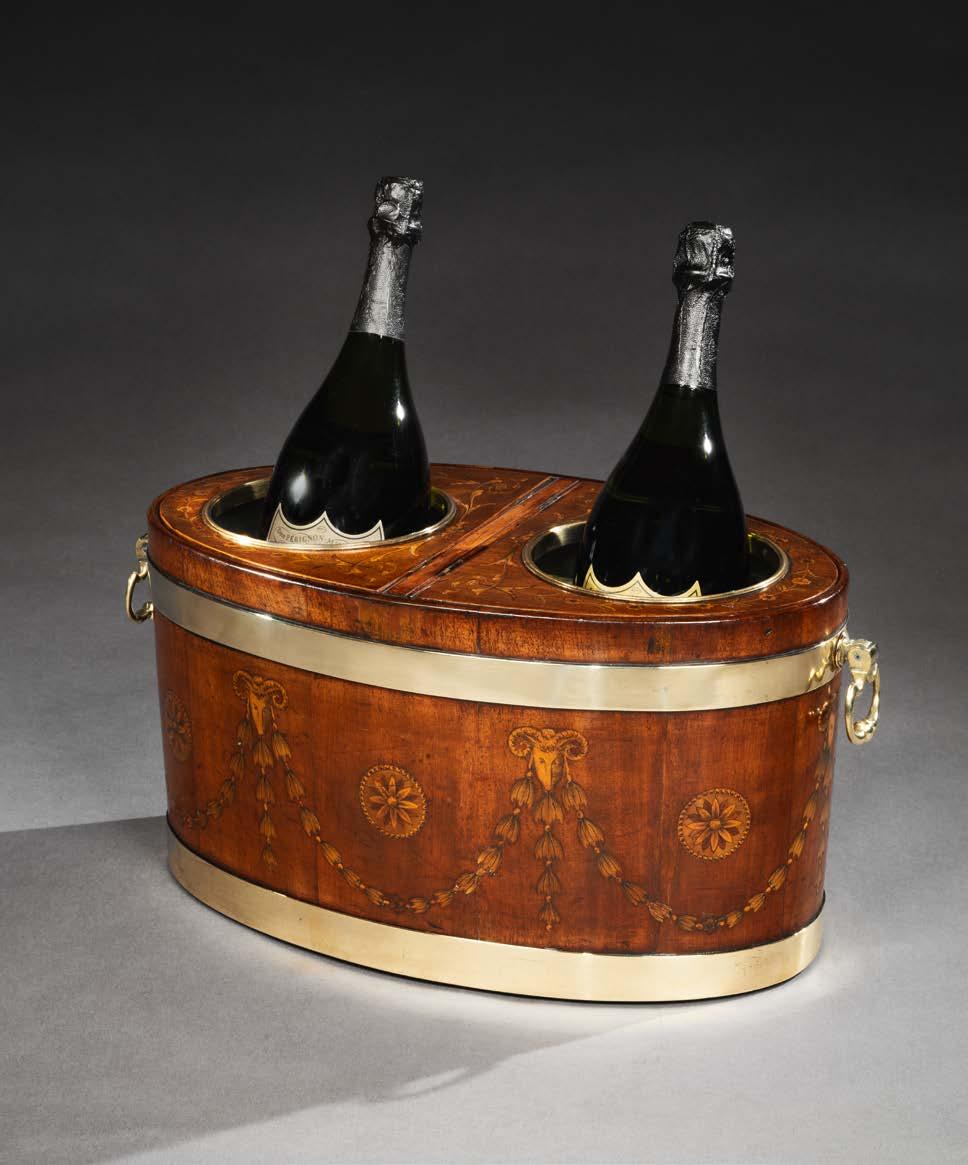
Note: The cabinet retains its original ornate brass handles. Each side is fitted with four adjustable shelves behind the door. English, circa 1765
Height: 33½ in; 85 cm
Width: 40 in; 101.5 cm
Depth: 14½ in; 37 cm
Literature: Thomas Chippendale, The Gentleman and Cabinet-Maker’s Director, 3rd edition, 1762, pl. LXIX.
The design of this cabinet fits within the Chippendale oeuvre, using the correct type of mouldings and fine mahogany and ornate brass handles of the type often used by the master. The outline with its gentle serpentine curved centre is a simplified version of plate LXIX of The Gentleman and Cabinet-Maker’s Director for a ‘French Commode Table’.
The word table was often used for cabinets or chests of drawers, generally for pieces of furniture with flat tops at roughly table height. The term ‘French Commode’ refers to the serpentine shape of the piece.

A GEORGE III GILTWOOD TRIPLE PLATE OVERMANTEL MIRROR ATTRIBUTED TO JOHN LINNELL
Note: The mirror has been re-gilded at some stage in the past. The mirror plates are later replacements.
English, circa 1765
Height: 44 in; 112 cm
Width: 52 in; 132 cm
Depth: 6 in; 15 cm
Provenance: Phillips & Rixson Ltd., London, England; Private collection, England.
Exhibited:
The Antique Dealers Fair and Exhibition, Grosvenor House, London, 1959; with Phillips & Rixson Ltd.



A GEORGE III MAHOGANY THREE PEDESTAL DINING TABLE
Note: The table has not been reduced in width and retains the original brass box castors. The extending leaves are 18th century replacements. English, circa 1790
Height: 2 ft 4¼ in; 72 cm
Width: 5 ft 3 in; 160 cm
Length: 9 ft 6¼ in; 290 cm
Length (extended): 16 ft 10½ in; 514.5 cm
Provenance: Ronald Phillips Ltd., London, England; Private collection, USA.
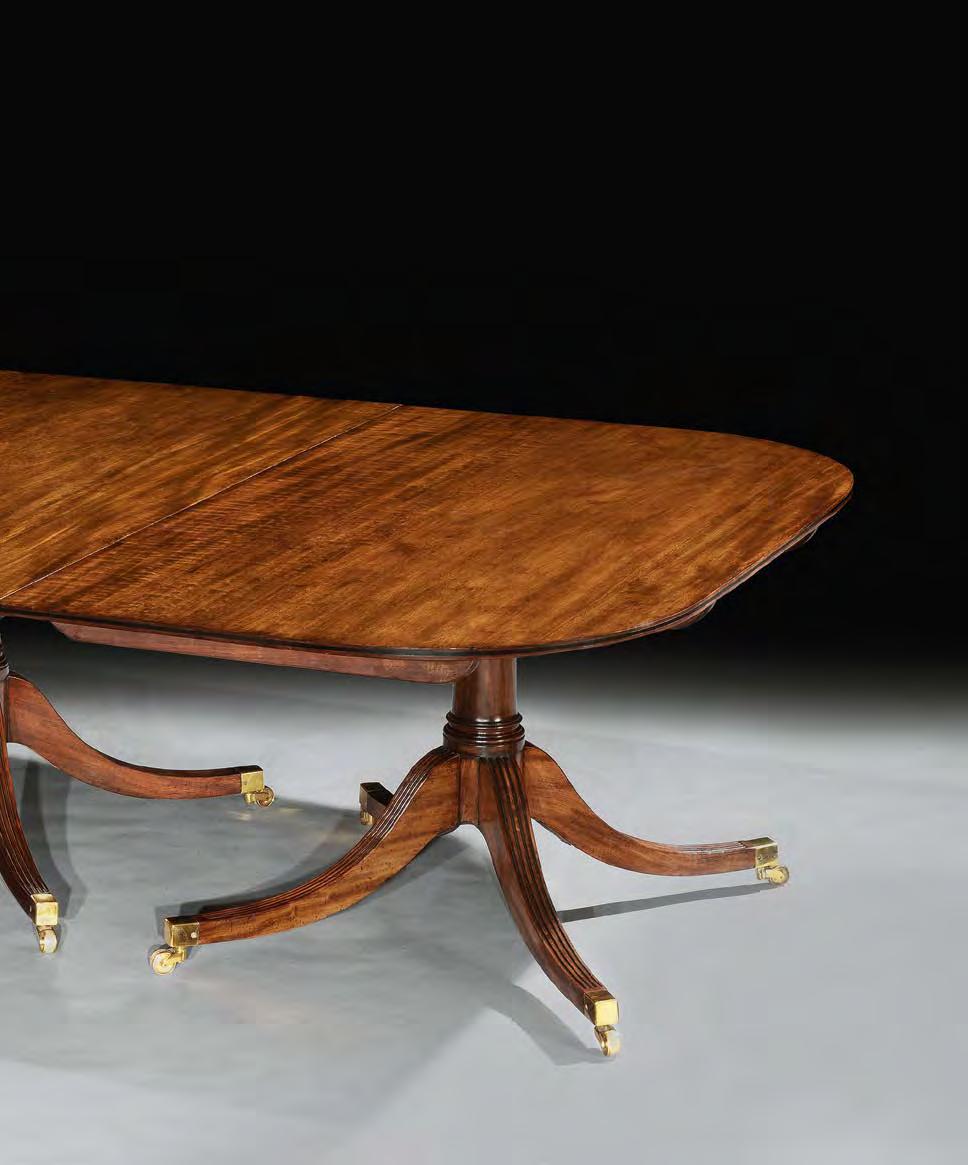
 The top with leaves inserted
The top with leaves inserted
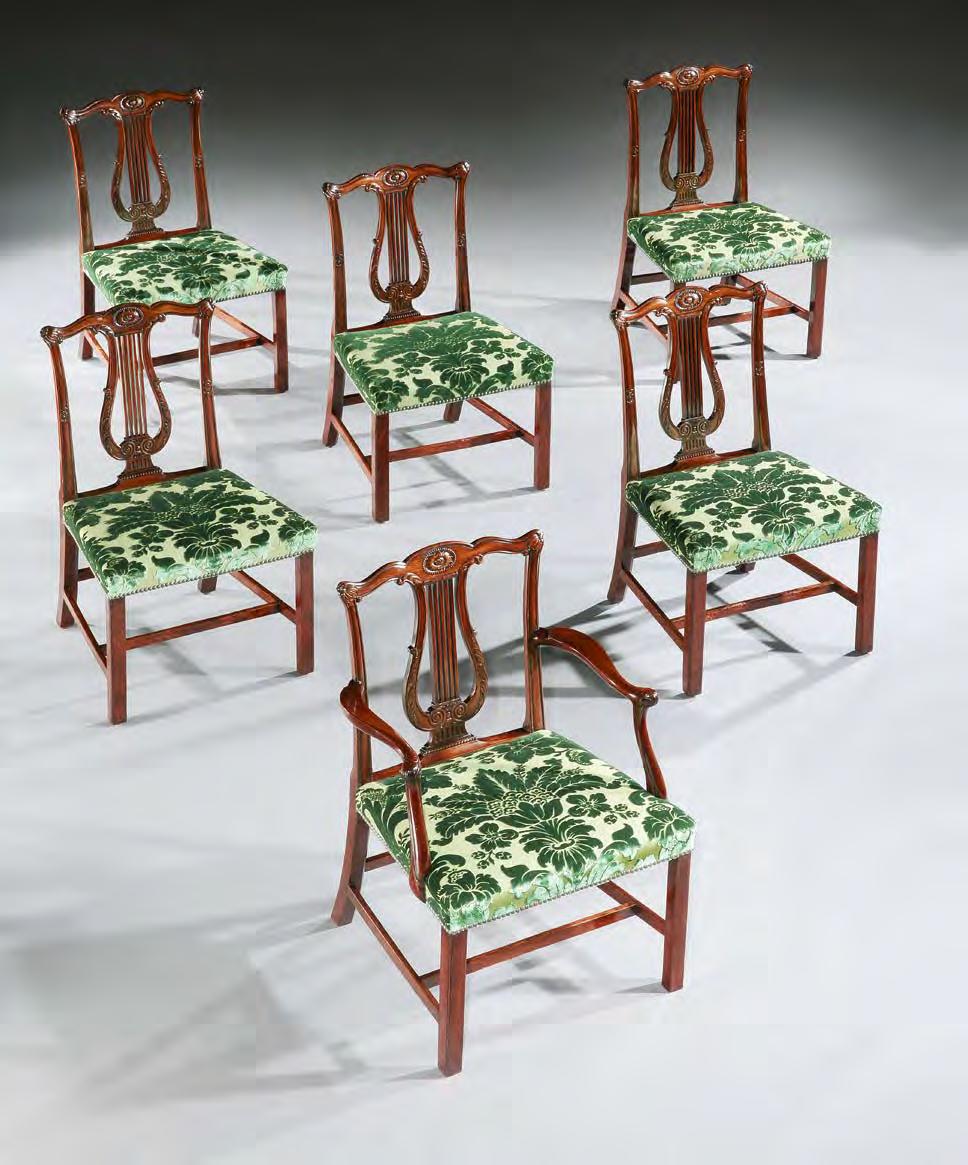


75
A SET OF TWELVE GEORGE III MAHOGANY DINING CHAIRS TO A DESIGN BY ROBERT ADAM AND ATTRIBUTED TO THOMAS CHIPPENDALE
English, circa 1770
The armchairs:
Height: 37½ in; 95 cm
Height of seat: 18½ in; 47 cm
Width: 24½ in; 62 cm
Depth: 23¾ in; 60.5 cm
The side chairs:
Height: 37½ in; 95 cm
Height of seat: 18½ in; 47 cm
Width: 22¾ in; 58 cm
Depth: 22¼ in; 56.5 cm
Provenance: Corporate collection, New York, USA.
Literature: Frederick S. Robinson, English Furniture, 1905, pl. CXXI.
Christopher Gilbert, The Life and Work of Thomas Chippendale, 1978, vol. II, pp. 92–3. Helena Hayward and Pat Kirkham, William and John Linnell, Eighteenth Century London Furniture Makers, 1980, vol. II, p. 36, fig. 68.
Partridge Fine Arts Ltd., ‘Summer Exhibition 1983’, catalogue, pp. 50–51.
Sotheby’s, ‘Important English Furniture, Decoration, Clocks and Carpets’, sale catalogue, New York, 29 October 1983, lot 112.
The set comprises ten side chairs and two armchairs. The distinctive lyre-back design was first introduced by Robert Adam for the dining chairs at Osterley Park, Middlesex, and was used shortly afterwards by Chippendale for the dining chairs at Nostell Priory, Yorkshire, and the library chairs at Brocket Hall, Hertfordshire. A further undocumented set is at Scampston Hall, Yorkshire. Chippendale never completely repeated a specific design, and each set of chairs differs slightly.

A
Note: The buckets retain their original handles. The brass liners are of later date.
English, circa 1770
Height: 12½ in; 31.5 cm
Height with handle up: 20 in; 51 cm Diameter: 12¼ in; 31 cm
Provenance: Tom Devenish, New York, USA; By descent to Clive Devenish, USA.
Literature: Percy Macquoid and Ralph Edwards, The Dictionary of English Furniture (revised edition), 1954, vol. 3, p. 35, fig. 1. Christian Jussel and William DeGregorio, English Furniture, 1680–1760: The Percival D. Griffiths Collection, 2023, vol. 1, p. 258, fig. 322.
A virtually identical pair of plate buckets were formerly in the celebrated Percival D. Griffiths Collection at Sandridgebury, Kent, and are illustrated in The Dictionary of English Furniture
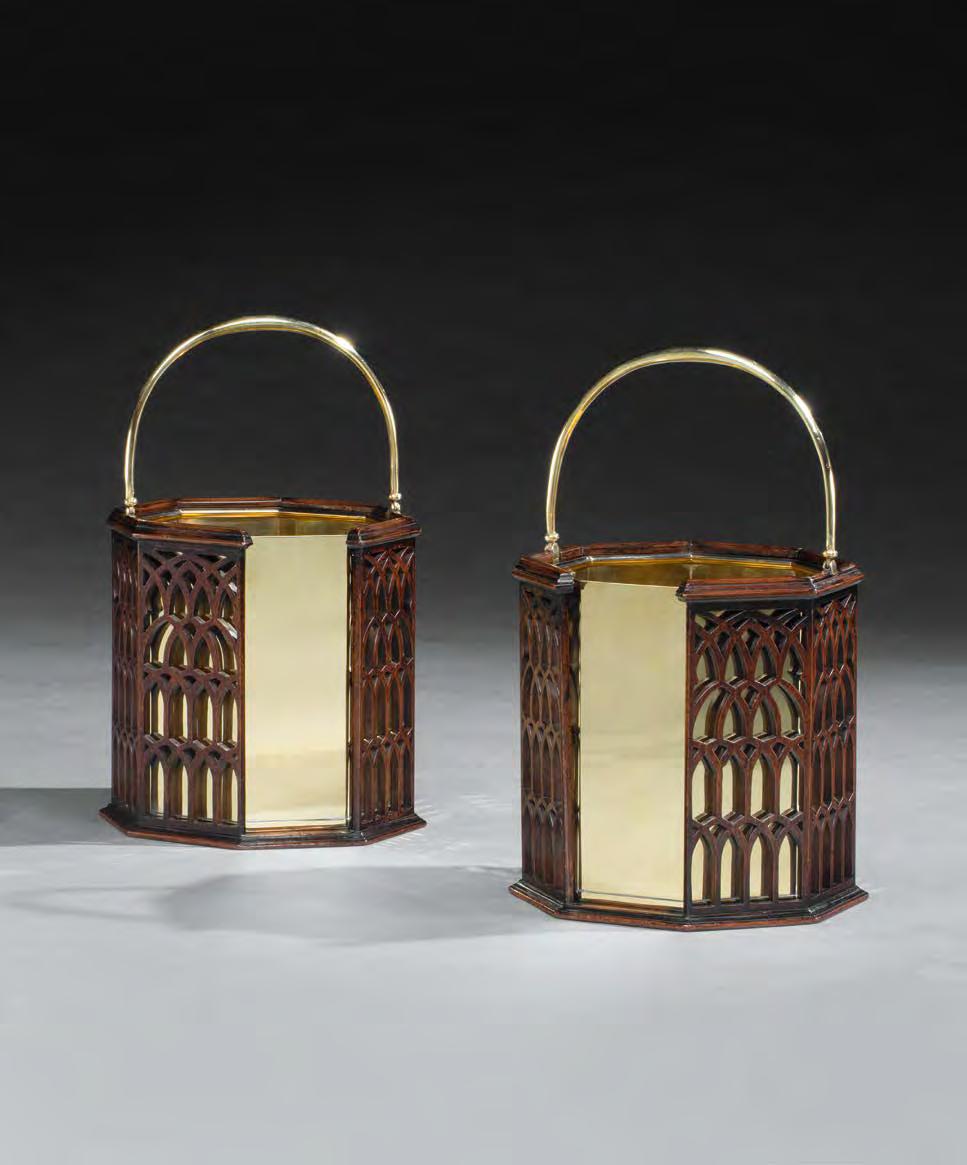
English, circa 1750
Height: 43½ in; 110.5 cm Diameter: 24 in; 61 cm
Provenance: Private collection, France.



Design for a lantern from Thomas Chippendale’s The Gentleman and Cabinet-maker’s Director, 3rd edition, 1762, pl. CLIII
78
A VICTORIAN ORMOLU LANTERN TO A DESIGN BY THOMAS CHIPPENDALE
Note: The lantern is now fitted for electricity.
English, circa 1860
Height: 31½ in; 80 cm
Diameter: 21 in; 53 cm
Literature:
Thomas Chippendale, The Gentleman and Cabinet-maker’s Director, 3rd edition, 1762, pl. CLIII.
The metalwork is finished to a very high standard, with elements of the design finely chased to create either a matt or shiny effect. This technique is usually a preparatory stage for gilding to create ormolu.


A GEORGE II PERIOD CHINESE EXPORT MIRROR PAINTING
Note: The glass retains the original bevelled edge on three sides; it has been marginally reduced on the right-hand side at some point.
The painting: Chinese export, circa 1760
The frame: English, circa 1950
Height: 36 in; 91.5 cm
Width: 36½ in; 93 cm
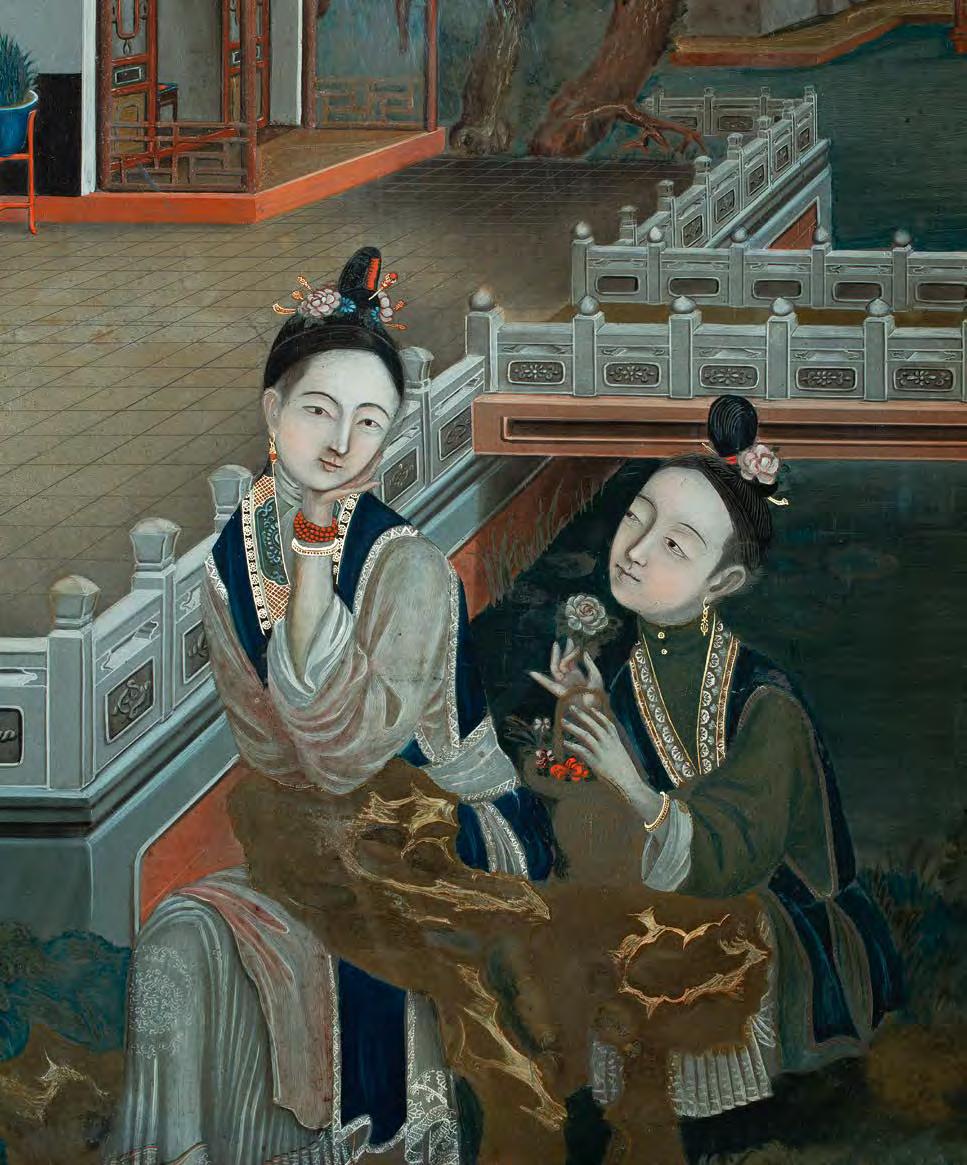
Note: The brass lifting handle to the lid is of later date. The inside of the lid is stamped Holland & Sons.
English, circa 1815
Height: 26 in; 66 cm
Width: 37 in; 94 cm
Depth: 21 in; 53.5 cm


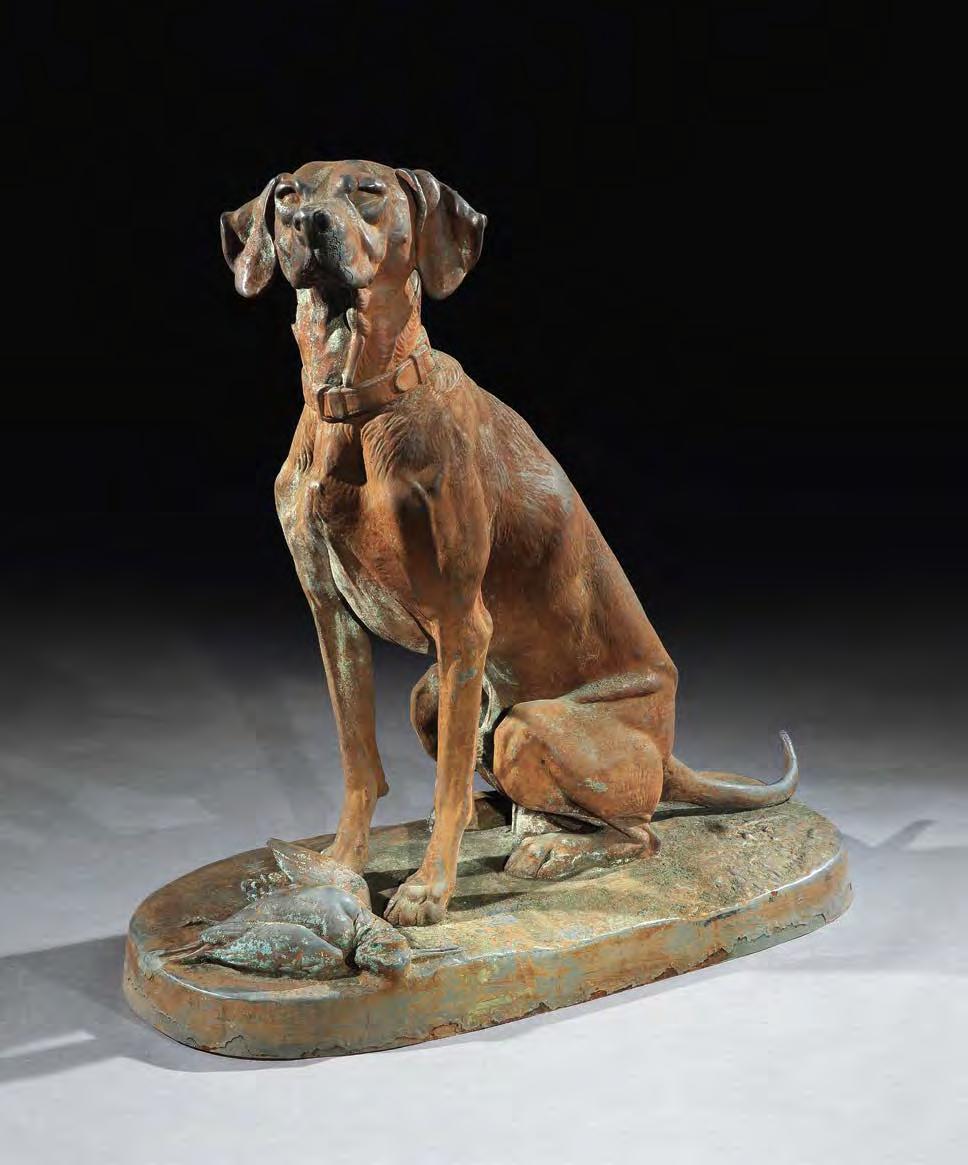
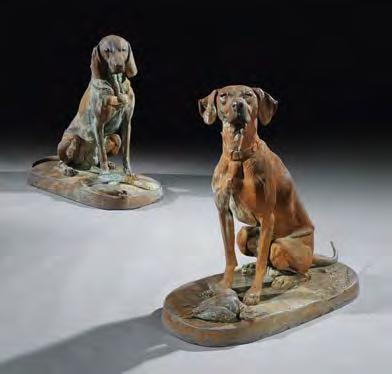

81
Note: The castings retain their original patination, which is exceptionally rare.
French, circa 1870
Height: 37¼ in; 94.5 cm
Length: 36½ in; 93 cm
Depth: 18 in; 46 cm
Literature:
Société anonyme des fonderies d’art du Val d’Osne, 1900, pl. 631, designs 65 & 66.
The lifesize models are each marked with the sculptor’s monogram ‘AJ’ and numbered to the underside 0106 and 0209 respectively.
Henri Alfred Jacquemart was one of the best-known 19th century sculptors of French monumental art. He became internationally renowned for his fine lifesize animal sculptures, and examples of his work in Paris included giant eagles for the fountain in Place SaintMichel, sphinxes for the fountain in Place du Châtelet and a full size rhinoceros for the Trocadero.
Today, his sculptures adorn private and public collections around the world and can be seen at Woburn Abbey, Bedfordshire, England, a bridge in Cairo, Egypt, and the Botanical Gardens in Sydney, Australia. Many of his sculptures were cast by the Barbezat Foundry at Val d’Osne, a short distance from Paris.

The designs for the hounds in Société anonyme des fonderies d’Art du Val d’Osne, circa 1900, pl. 631, nos 65 & 66
A GEORGE III MAHOGANY URN STAND
English, circa 1770
Height: 27½ in; 69.5 cm
Width: 12¾ in; 32.5 cm
Depth: 13¼ in; 34 cm
Provenance: Private collection, England. The drawer in the frieze is a rare feature. Most urn stands are fitted with pull-out slides.
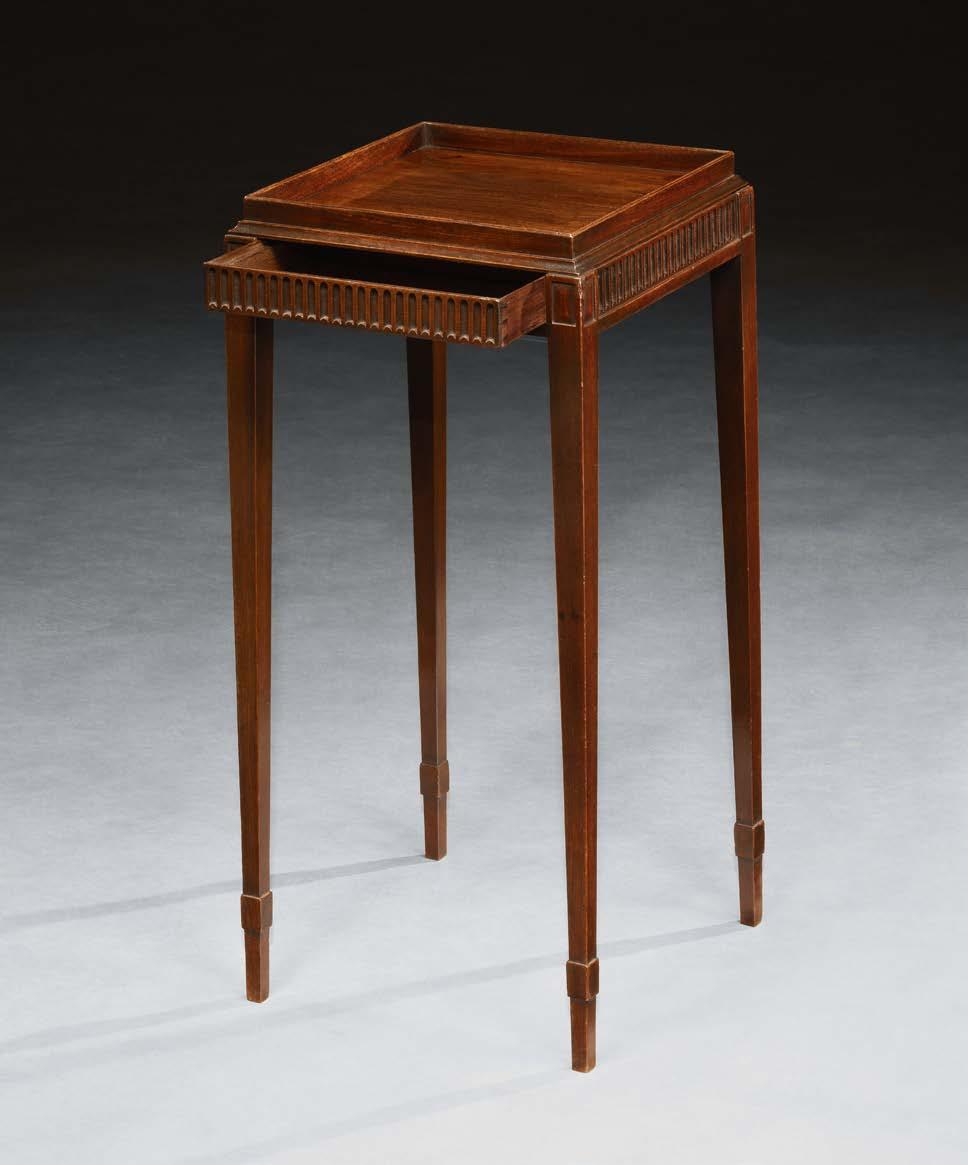

A PAIR OF GEORGE III ORMOLU MOUNTED CUT GLASS THREE LIGHT CANDELABRA BY PARKER & PERRY
English, circa 1785
Height: 22 in; 56 cm
Width: 16 in; 40.5 cm
Depth: 5 in; 12.5 cm
Provenance: Jeremy Ltd., London, England; Private collection, Virginia, USA.


Note: The central drawer is stamped ‘Holland & Sons’. The faded brown tooled leather insert is probably original. The brass knob handles are of later date.
English, circa 1860
Height: 29¾ in; 75.5 cm
Height of kneehole: 23½ in; 60 cm
Width: 51½ in; 131 cm
Depth: 27 in; 68.5 cm
Provenance: Michael Lipitch Ltd., London, England; Private collection, England.
Illustrated: Ronald Phillips Ltd., ‘Antique English Furniture’, catalogue, 2010, pp. 92–3.
Ronald Phillips Ltd., ‘Antique English Furniture’, catalogue, 2011, pp. 76–7.
Literature:
Geoffrey Beard and Christopher Gilbert, The Dictionary of English Furniture Makers 1660–1840, 1986, p. 442.

English, circa 1815
Height: 36½ in; 92.5 cm
Height of seat: 20 in; 51 cm
Width: 23½ in; 60 cm
Depth: 27¾ in; 70.5 cm
Provenance: Apter Fredericks Ltd., London, England; Private collection, USA.

Note: The desk retains most of the original handles and locks. The gold tooled leather insert is of later date.
English, circa 1850
Height: 30 in; 76 cm
Height of kneehole: 23½ in; 59.5 cm
Depth: 43½ in; 110.5 cm
Width: 60½ in; 153.5 cm
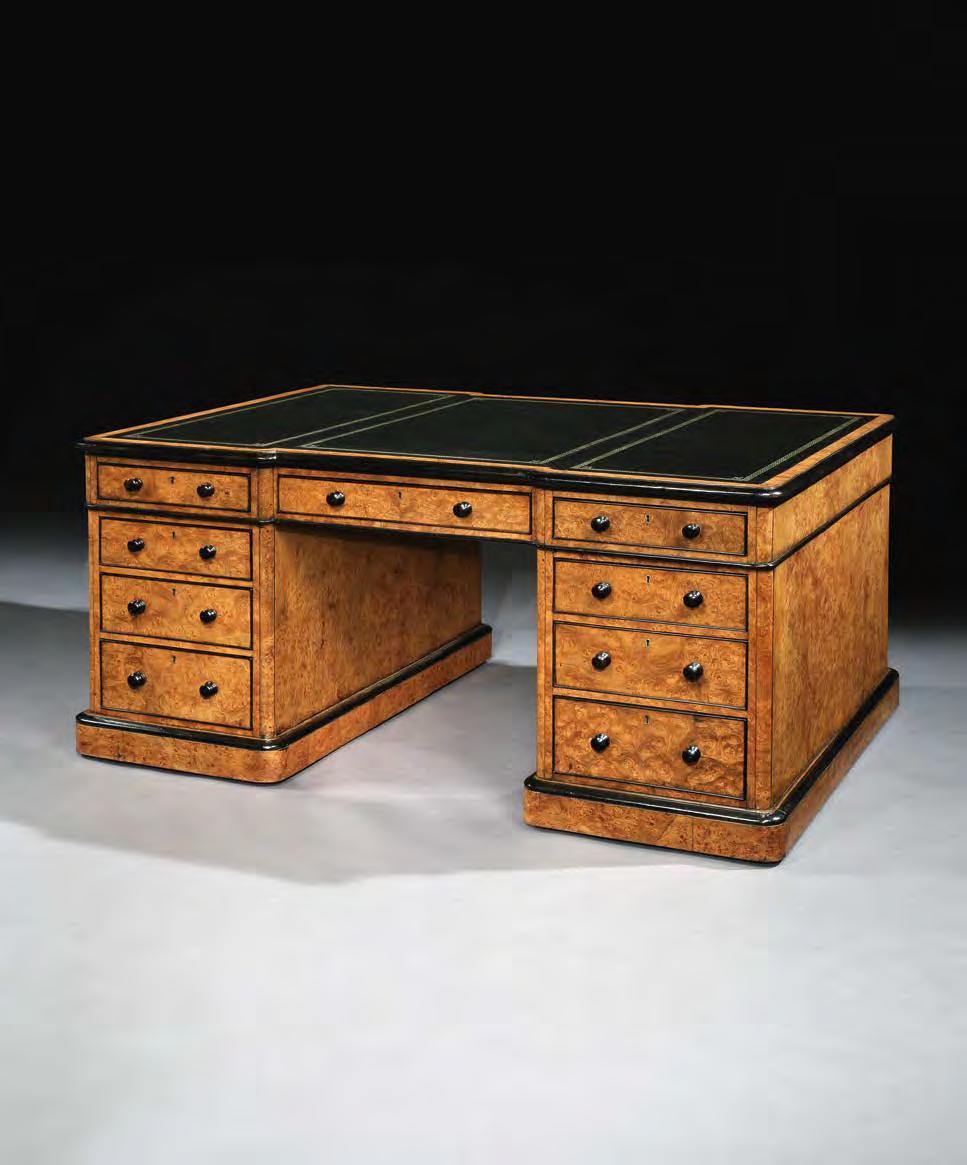

87
A REGENCY TWELVE INCH TERRESTRIAL GLOBE BY J. & W. CARY AND RETAILED BY JOSEPH SMITH OF THE ROYAL EXCHANGE, LONDON
English, dated 1818
Height: 36½ in; 93 cm
Diameter (across horizon ring): 17¼ in; 44 cm
Diameter of globe: 12 in; 30.5 cm
Literature:
Post Office London Directory (1807) lists James Long, but not Joseph Smith: pp. 170 & 248.
Post Office London Directory (1812): ‘Smith Joseph, Optician, Royal Exchange, North Gate’, p. 286.
Post Office London Directory (1815) ‘Smith Joseph, Optician, Royal Exchange, North Gate’, p. 306.
Post Office London Directory (1820) ‘Smith Joseph, Optician, Royal Exchange, North Gate’, p. 327.
Post Office London Directory (1825) ‘Smith Joseph, Optician, Royal Exchange, North Gate’, p. 373.
Ann Saunders, The Royal Exchange, 1997, p. 236.
Joseph Smith is listed in the Post Office London Directory of 1812 as an optician. He was apprenticed to his father, Richard, an eye spectacle maker, in 1780. In 1811 he took over an established business and traded as a ‘microscopist’ from a large premises at the north gate of the Royal Exchange in London until his death in 1825. As a maker of optical instruments, Smith also sold bought-in globes like this model by J. & W. Cary, with his name printed and inserted alongside the maker’s name.

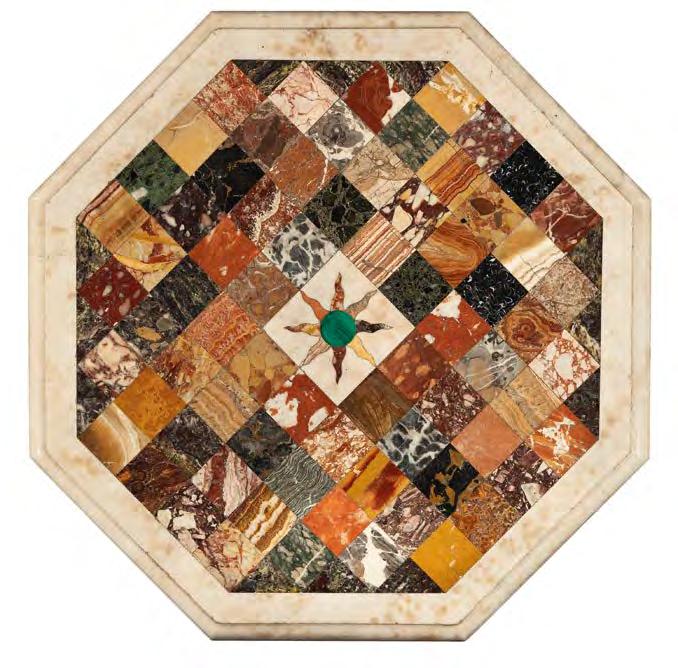
A GEORGE II MAHOGANY AND SPECIMEN MARBLE OCTAGONAL CENTRE TABLE
English, circa 1740
Height: 27¾ in; 70.5 cm
Diameter: 29 in; 74 cm
Provenance: Private collection, England.



cabinet from the group, Temple Newsam, Leeds, illustrated in Christopher
89
The cabinet: European, circa 1620
The stand: American, 20th century
Height on stand: 53¾ in; 136.5 cm
Width: 20 in; 51 cm
Depth: 11¼ in; 28.5 cm
Provenance: Private collection, USA.
Literature:
Percy Macquoid and Ralph Edwards, The Dictionary of English Furniture, revised edition, 1954, vol. I, p. 160, fig. 1.
Christopher Gilbert, Furniture at Temple Newsam House and Lotherton Hall, vol. I, 1998, pp. 46–7.
Adam Bowett, Woods in British Furniture-Making 1400–1900, 2012, p. 86.
This cabinet belongs to a small group of near-identical cabinets in museums and important collections around the world, including the Victoria and Albert Museum, London, England; Temple Newsam, Leeds, England; Melbourne Museum, Australia; and the Museum für Lackkunst, Münster, Germany.
All these cabinets are constructed from a mixture of hardwoods such as Baltic oak, elm and eucalyptus. This combination is very unusual, with eucalyptus not being used on any English furniture of the period. The decoration is very much in keeping with the early 17th century when Venice was at the forefront of fashion. Japanned pieces of furniture made in Venice around the first quarter of the century became very desirable among Europe’s elite.

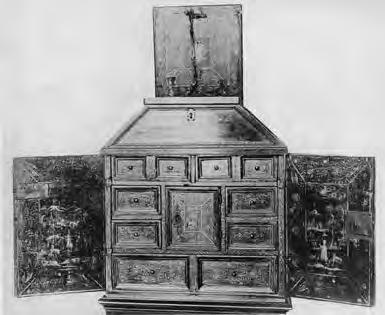
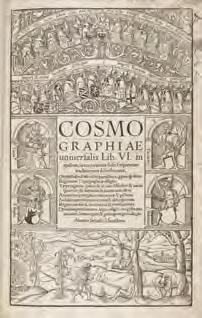
The images on the japanned cabinet depict landscapes with rolling hills, lakes and buildings common in northern Europe. The gibbet in one is a reminder of the Thirty Years War which raged in Europe from 1618 until the Peace of Westphalia in 1648. The scenes depicted on each panel derive from the influential German publication Cosmographia Universalis by Sebastian Münster, first published in 1544, and translated into Latin, French, Italian, English and Czech between 1544 and 1628.
Scholars of English furniture have previously linked the decoration of this cabinet with a supposedly English ballot box commissioned by the East India Company and dated 1619, and with a set of similarly decorated roundels on a wooden box in the collection of the Victoria and Albert Museum, London. The roundels are datable by their use of poems that were published around the same time the ballot box was commissioned.
There is not enough concrete evidence to support English manufacture, however. The East India Company’s business was importing foreign luxury items to England, and their own ballot box would not have been an exception. The construction of the cabinets is generic, and it would be hard to pinpoint a country of manufacture. The choice of timbers is not characteristic of England, but nor does it suggest any other specific European country.
Given that several nearly identical versions of the cabinet exist, it is safe to say this cabinet is not a unique creation like the famous Augsburger Kunstschrank, a cabinet of curiosities presented to the King of Sweden in 1632 by the city of Augsburg. Similarly it is unlikely that the cabinet was intended for storing jewels or for writing purposes. Writing cabinets always have a writing surface in the form of either a fall-down front or a pull-out slide, while jewel cabinets tend to have mirrors fitted.
The design of this group of cabinets is generic, and the only difference between them is the centre, which is fitted with either a large drawer or a door. Adam Bowett suggests that they were intended as spice cabinets, which might explain the use of exotic eucalyptus wood, and also why several examples exist. The remnants of Latin inscriptions on the mouldings around the drawer fronts might refer to the original contents, possibly medicinal herbs.


90
A GEORGE I BURR WALNUT BUREAU
ATTRIBUTED TO PETER MILLER
Note: The bureau retains all the original brass handles and escutcheons. The backboards of both the bureau section and the base section are inscribed in ink: ‘To His Grace the Duke of Chandos att Shaw Hall Near Newbury Barks’.
English, circa 1715
Height: 3 ft 11½ in; 121 cm
Height of pull-out: 2 ft 8 in; 81.5 cm
Width (with handles): 4 ft 2 in; 127 cm
Width (one flap open): 6 ft 1½ in; 187 cm
Width (both flaps open): 8 ft 1 in; 246.5 cm
Depth: 2 ft 5½ in; 75 cm
Depth (with pull-out): 3 ft 3 in; 99 cm
Provenance: James Brydges, 1st Duke of Chandos (1673–1744), Cannons, Middlesex, England; Transferred to Shaw House, Berkshire, England, 1730; And to Scotland Yard, London, England, 1743; Thomas Alexander Brown, Scotland Yard, London, England, until 1809; Revd. William Shepard, Liverpool, England, until 1847; Hannah Mary Fletcher, Liverpool, England, until 1857; Colonel Samuel Archer, Liverpool, England, until 1899; Francis William Archer, Liverpool, England, until 2010; Private collection, London, England.



James Brydges’ father was the 8th Baron Chandos, an influential member of the Levant Company who was appointed Ambassador to Constantinople from 1681 to 1687, a position that considerably increased his wealth.
James Brydges was created Earl of Carnarvon on his father’s death in 1714, and became 1st Duke of Chandos in 1719. Like his father before him, he too was a member of the Levant Company, becoming its Governor from 1718 to 1735. He entered the Privy Council in 1721. Between 1713 and 1724 he built Cannons, a mansion in Middlesex on an estate acquired from the uncle of his first wife, Mary Lake. Its vast cost (equivalent to over £33 million today), together with heavy losses when the South Sea Company and the York Buildings Company both crashed, greatly depleted the family fortune. The 1st Duke died at Cannons in 1744. His son, Henry Brydges, 2nd Duke of Chandos, was unable to afford the house’s upkeep and in 1747 he held a twelve-day sale of both the contents and parts of the structure, culminating in its demolition.
The 1st Duke had purchased Shaw House in Berkshire with his second wife, Cassandra Willoughby, in 1728. He stayed there for a few months in 1730 after arranging for furniture, including the walnut bureau, to be sent there from London, but after Cassandra died in 1735 he never returned. Shaw House stood empty, with the furniture dispersed among his tenanted properties at Scotland Yard in London.
The bureau was later passed on to one of his tenants, Thomas Alexander Brown, who subsequently gave it in lieu of school fees to the Reverend William Shepard, the minister at Gateacre, a private boarding school in Liverpool. It was then purchased by Shepard’s niece, Hannah Mary Fletcher, in the sale of her late uncle’s effects. Hannah in turn bequeathed the bureau to her nephew, Colonel Samuel Archer, who gave it to his son.
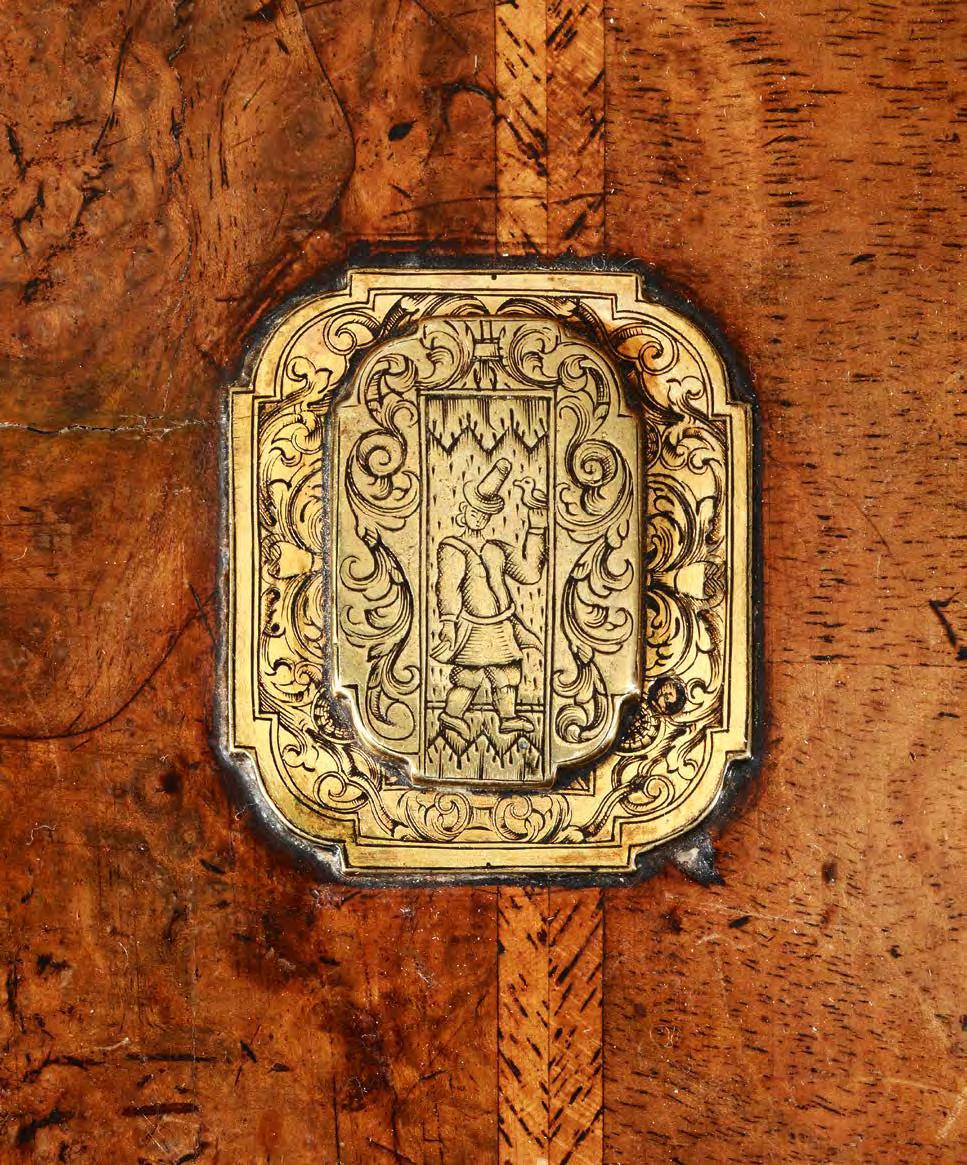

The rosewood and parcel gilt bookcase at Dumfries House, Ayrshire
91
English, circa 1765
Height: 53½ in; 136 cm
Diameter of tops: 13½ in; 34.5 cm
Provenance: Kinnaird House, Dunkelt, Scotland.
Literature:
Thomas Chippendale, The Gentleman and Cabinet-maker’s Director, 1st edition, 1754, pls CXX–CXXIII.
Thomas Chippendale, The Gentleman and Cabinet-maker’s Director, 3rd edition, 1762, pls LII & CXLIV–CXLVIII.
The only two commissions for documented torchères from the Chippendale workshop were for Blair Castle, Perthshire, and Brocket Hall, Hertfordshire. With twelve different designs for candle stands in the first edition of Chippendale’s Director, and twenty-one in the third edition, torchères or candle stands are clearly under-represented in the
known canon of documented Chippendale pieces. We know that these stands were used in considerable numbers, and it is probably because of their fragility that so few have survived. When electric lighting was introduced, torchères eventually became redundant except for displaying decorative objects.
The distinctive scroll feet show similarities with pole screens supplied to Dumfries House, Ayrshire. The famous bookcase at Dumfries is also made of rosewood and parcel gilt. The Dumfries auction catalogue produced by Christie’s in 2007 interestingly lists several pole screens but not a single torchère.
A lady’s dressing table made of rosewood and with parcel gilt elements remains at Arniston House, Midlothian. It partly follows Chippendale’s design in the Director, but has some interesting variations which link it with the torchères. The dressing table is finished with a Chinese pagoda-like structure and a much-simplified apron carving to the kneehole, which in fact corresponds to the carving connecting the legs.
Future research may be able to establish whether these torchères were ordered for either Arniston or Dumfries.

Note: It was evident that our mirror had lost its ribbon tied roundel, and we were fortunate enough to be able to use photographic evidence and the experience of Carvers & Gilders Ltd. of London to reinstate it. The mercury silvered mirror plate is a replacement.
English, 1786
Height: 6 ft 7¼ in; 201.5 cm
Width: 4 ft ½ in; 123.5 cm
Provenance: Edwin Lascelles, 1st Baron Harewood, Harewood House, Yorkshire, England; Transferred to Portman Street, London, England, between 1790 and 1795; Collection of Chalmers Benedict Wood, US Foreign Service Officer and Ambassador, Wellington, New Zealand (1972–1974); USA.
Illustrated: Ronald Phillips Ltd., catalogue, 2017, pp. 6–9.
Ronald Phillips Ltd., ‘The Legacy of Thomas Chippendale’, catalogue, 2018, pp. 20–23.
Literature: Christopher Gilbert, ‘Chippendale’s Harewood Commission’, Furniture History Journal, 1973, vol. 9, pp. 27–31.
This mirror, a remarkable discovery, is identical in many carved elements and in construction to a pair of mirrors sold from Harewood House, Yorkshire, in 1987. That pair, now in a private collection, differ in not having sphinx platforms.
Harewood House underwent extensive refurbishment in the 19th century under Charles Barry, and many Chippendale features and fittings including the sphinx mirrors were removed, dismantled and stored in the attic of the house. Entire walls were removed, and the layout of rooms was changed drastically. The furniture was moved around the house over the years, making it almost impossible to ascertain which piece originally belonged where.
Circular mirrors are exceptionally rare, and no other Chippendale commission for the supply of circular mirrors is known.


A platform of identical size and design has been found in the storerooms at Harewood House. Identical sphinx carvings can be found surmounting later pier mirrors in the Cinnamon Drawing Room (formerly the White and then the Green Drawing Room), where the mirror had originally been installed. This evidence links the mirror unequivocally to the other pair of circular mirrors sold in 1987 and to Chippendale’s work at Harewood House.
Research within the Harewood archives has revealed that this circular mirror was in fact originally one of a set of four. Two from the set were removed following Barry’s refurbishment of the house in the 19th century, but the other two, including our mirror, had been removed from the room around 1790, when wall space was needed to hang two large portraits. They were then transferred to Edwin Lascelles’ London property in Portman Street, where they are mentioned in an inventory of 1795 in his bedchamber: ‘2 Circular Glass Girandoles in very Rich Carv’d and Gilt frames’. It is uncertain what happened to them subsequently, but one can assume they stayed at Portman Street until Lascelles’ widow died in 1813 and the house was sold. The contents including the mirrors were then either sold or transferred to one of his children. The current whereabouts of the fourth circular mirror is not known.
With thanks to Dr. Adam Bowett for kindly providing information relating to the Portman Street provenance.


A GEORGE II MAHOGANY TWELVE DRAWER SERPENTINE CHEST OF DRAWERS ATTRIBUTED TO THOMAS CHIPPENDALE
Note: The commode has acquired a beautiful patina and retains the original rococo brass handles. It is fitted with concealed and fixed castors enabling movement backwards or forwards only.
English, circa 1755
Height: 35¾ in; 91 cm
Width: 60 in; 152.5 cm
Depth: 24¾ in; 63 cm
Provenance: Phillips of Hitchin, Hertfordshire, England; Hotspur Ltd., London, England; Private collection, England.





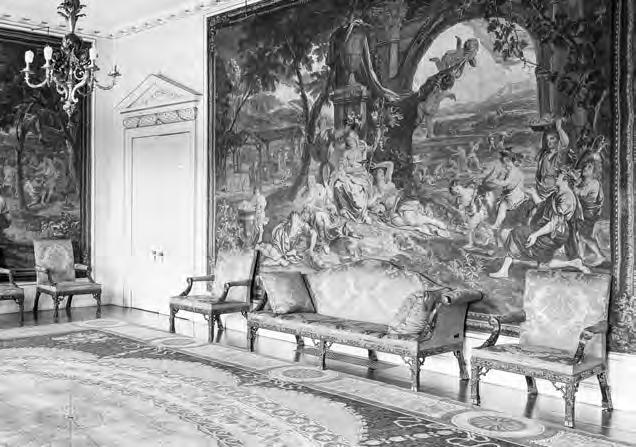
A PAIR OF GEORGE III MAHOGANY SETTEES AND A PAIR OF GEORGE III MAHOGANY LIBRARY ARMCHAIRS ATTRIBUTED TO WILLIAM VILE
English, circa 1765
The settees:
Height: 3 ft 3¼ in; 100 cm
Height of seat: 1 ft 5½ in; 44.5 cm
Width: 7 ft 1 in; 216 cm
Depth: 2 ft 9¼ in; 84.5 cm
The armchairs:
Height: 39¾ in; 101 cm
Height of seat: 17½ in; 44.5 cm
Width: 28¾ in; 73 cm
Depth: 31½ in; 80 cm
Provenance:
One settee and the armchairs
Supplied to Anthony Ashley-Cooper, 4th Earl of Shaftesbury (1711–1771), for St. Giles’s House, Dorset, England;
By descent to Anthony Ashley-Cooper, 10th Earl of Shaftesbury, St. Giles’s House, Dorset, England; Christie’s, ‘Highly Important English Furniture and Sculpture from St. Giles’s House, Dorset’, 26 June 1980, lot 92 (the armchairs) and lot 96 (the settee); Lily and Edmond Safra, New York, USA; Partridge Fine Arts Ltd., London, England; Private collection, London, England.
The companion settee
Supplied to Anthony Ashley-Cooper, 4th Earl of Shaftesbury, for St. Giles’s House, Dorset, England; By descent to Anthony Ashley-Cooper, 9th Earl of Shaftesbury, St. Giles’s House, Dorset, England, until 1953; Christie’s, ‘Important English and French Furniture’, 22 October 1953; Emily Hesslein, New York, USA, until 1962; Sotheby’s, 30 March 1962, lot 162; Walter Waddingham Antiques Ltd., Harrogate, Yorkshire, England, until 1963; Private collection, Illinois, USA, until 2002; Private collection, London, England.



The table illustrated in Francis Lenygon, Furniture in England from 1660 to 1760, 1914, p. 124, fig. 193
95
A GEORGE II GREY PAINTED CONSOLE TABLE ATTRIBUTED TO WILLIAM KENT
Note: The table retains much of the original paint surface and the original marble top.
English, circa 1730
Height: 36½ in; 93 cm
Width: 55½ in; 141 cm
Depth: 30¾ in; 78 cm
Provenance:
Lenygon & Co., London, England; Bradley Martin, Westbury, Long Island, New York, USA; Esmond Bradley Martin, Westbury, Long Island, New York, USA; Private collection, New York, USA.
Illustrated: Margaret Jourdain, ‘Furniture of the XVII and XVIII centuries: a side table by William Kent’, Country Life, 13 May 1911, pp. 684–7.
Francis Lenygon, Furniture in England from 1660 to 1760, 1914, p. 124, fig. 193.
Susan Moore, ‘Faith and faithless choice: furniture in the early years of Country Life’, Country Life, 8 January 1986, p. 73, fig. 3.
Literature: Sotheby’s, ‘Important English Furniture, Silver, Ceramics and Decorations’, sale catalogue, New York, 21–22 October 2004, lot 384.


In its early years, Country Life magazine focused on the furnishings of country houses in England. This eagle table was featured in an article researched and written by Margaret Jourdain that was published in 1911 in the first issue to use colour photography, a groundbreaking development at the time. The innovation was shortlived, however, and was suspended after the outbreak of the First World War. Colour was not reintroduced until fifty years later.
The table appears in the 1990 Hollywood film Reversal of Fortune, telling the real-life story of Claus von Bulow and starring Jeremy Irons and Glenn Close.


Beard, Geoffrey, and Christopher Gilbert, The Dictionary of English Furniture Makers 1660–1840, Leeds, 1986.
Beard, Geoffrey, and Judith Goodison, English Furniture 1500–1840, Oxford, 1987.
Bowett, Adam, Early Georgian Furniture 1715–1740, London, 2009.
Bowett, Adam, Woods in British Furniture-Making 1400–1900, London, 2012.
Chippendale, Thomas, The Gentleman and Cabinet-maker’s Director, London, 1754.
Chippendale, Thomas, The Gentleman and Cabinet-maker’s Director, 3rd edition, London, 1762.
Claxton Stevens, Christopher, and Stewart Whittington, 18th Century English Furniture: The Norman Adams Collection, London, 1983.
Coleridge, Anthony, Chippendale Furniture, London, 1968.
Fitzgerald, Desmond, Georgian Furniture, London, 1969.
Gilbert, Christopher, Furniture at Temple Newsam House and Lotherton Hall, 3 vols, Leeds, 1978 & 1998.
Gilbert, Christopher, The Life and Work of Thomas Chippendale, 2 vols, London, 1978.
Goodison, Judith, The Life and Work of Thomas Chippendale Junior, London, 2017.
Goodison, Nicholas, Matthew Boulton: Ormolu, London, 2002.
Hackenbroch, Yvonne, English Furniture with Some Furniture of Other Countries in the Irwin Untermyer Collection, London, 1958.
M. Harris & Sons, The English Chair – Its History and Evolution, London, 1937.
Hayward, Helena, and Pat Kirkham, William and John Linnell, Eighteenth Century London Furniture Makers, 2 vols, London, 1980.
Hinckley, F. Lewis, A Directory of Queen Anne, Early Georgian and Chippendale Furniture, New York, 1971.
Hussey, Christopher, English Country Houses, Late Georgian 1800–1840, London, 1958.
Ince, William, and John Mayhew, The Universal System for Household Furniture, London, 1762.
Jussel, Christian, and William DeGregorio, English Furniture, 1680–1760: The Percival D. Griffiths Collection, vol. 1, N ew Haven, 2023.
Knight of Glin, The, and James Peill, Irish Furniture, London, 2007. de Lassale, Jacques Dubarry, Identifying Marble, Dourdan, 2000.
Lenygon, Francis, Furniture in England from 1660 to 1760, London, 1914.
Macquoid, Percy, A History of English Furniture, vol. III, ‘The Age of Mahogany’, London, 1906.
Macquoid, Percy, and Ralph Edwards, The Dictionary of English Furniture, 3 vols, new edition revised by Ralph Edwards, London, 1954.
Pain, W illiam, The Builder’s Companion and Workman’s General Assistant, London, 1758.
Robinson, Frederick S., English Furniture, London, 1905. Saunders, Ann, The Royal Exchange, London, 1997.
Schiffer, Herbert F., The Mirror Book: English, American & European, Exton, Pennsylvania, 1983.
Smith, George, A Collection of Designs for Household Furniture and Interior Decoration, London, 1808.
Société anonyme des fonderies d’art du Val d’Osne, Paris, 1900.
Symonds, R. W., Masterpieces of English Furniture and Clocks, London, 1940.
Weber, Susan, William Kent: Designing Georgian Britain, New York, 2014.
Wills, Geoffrey, English Looking-glasses: A Study of the Glass, Frames and Makers (1670–1820), London, 1965.
BOOKCASES/CABINETS/BUREAUX
A James I period black and gold japanned cabinet on stand
A W illiam and Mary scarlet and gilt japanned bureau cabinet
The Chandos bureau: a George I burr walnut bureau attr. to Peter Miller
A George II burr walnut and parcel gilt bureau cabinet attr. to workshop of Grendey
A George II mahogany breakfront cabinet attr. to William Hallett, the design to Kent 7
A George III mahogany breakfront side cabinet in the manner of Chippendale
A shallow George III mahogany and gonçalo alves side cabinet
A pair of Regency side cabinets in the manner of George Smith
A Victorian period
CHESTS/COMMODES
A George I walnut and ash bachelor’s
A
II
A George II mahogany twelve drawer serpentine chest of drawers attr. to Chippendale
A George III ormolu mounted harewood marquetry commode in the manner of Fuhrlohg
A pair of George III mahogany and gonçalo alves crossbanded chests of drawers
A pair of George II sixteen inch table globes by John Senex on mahogany stands
A Regency twelve inch terrestrial globe by J. & W. Cary, retailed by Joseph Smith
LIGHTING
A George III ormolu mounted cut glass six light chandelier by Parker & Perry
A pair of George III giltwood composition two light wall lights
A pair of George III ormolu
MIRRORS/GIRANDOLES
A Queen Anne gesso mirror girandole attr. to Philip or Jacob Arbuthnot
The Sir W illiam Humphreys mirror: a George I border glass mirror attr. to Arbuthnot
The Daisy Fellowes mirror: a George III giltwood and carton pierre pier mirror
The Harewood House mirror: a George III giltwood mirror by Thomas Chippendale
A George III giltwood oval border glass
A George III giltwood oval overmantel
A George III giltwood triple plate overmantel mirror attr. to John Linnell
A George III painted mirror attr. to John Linnell
Benches
A George II giltwood long bench
Chairs (single)
A George I parcel gilt walnut chair with verre églomisé insert by Thomas How
The Leidesdorf chair: a George II mahogany library
II walnut wing
Chairs (pairs)
A pair of George II walnut armchairs
The Frederick Howard Reed armchairs: a pair of George III mahogany armchairs
A pair of George III mahogany library armchairs almost certainly by Chippendale
A pair of Regency mahogany armchairs made for Gillows for C. Hodgson of Liverpool
Chairs (sets)
A set of eight George III mahogany armchairs
A set of twelve George III mahogany dining chairs to a design by Adam and attr. to Chippendale
Settees
A pair of George III giltwood settees almost certainly by Chippendale
A pair of George II mahogany stools
The St Giles’s House suite: a pair of George III mahogany settees and a pair of George III mahogany library armchairs attr. to William Vile
Regency mahogany circular extending
George II mahogany torchère attr. to Thomas Chippendale
George II mahogany tripod kettle stand
A George II mahogany tripod
A George II mahogany tripod table with pie-crust top
The Leidesdorf table: a George II mahogany tilt-top pie-crust table
The Samuel Messer kettle stand:
GREAT ENGLISH FURNITURE
FINE ANTIQUE ENGLISH FURNITURE
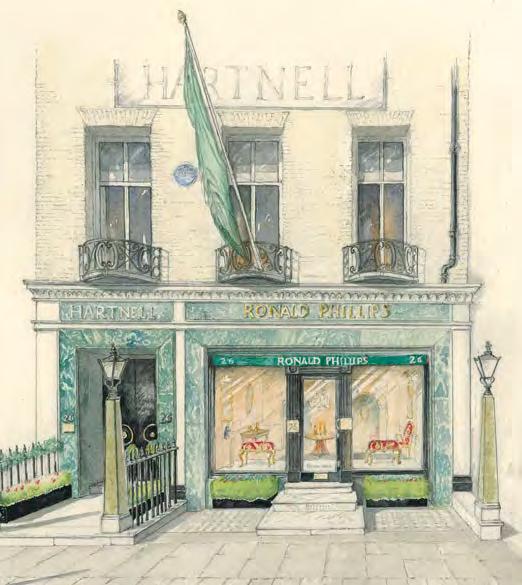
RONALD PHILLIPS LTD.
26 BRUTON STREET, LONDON W1J 6QL
Tel: + 44 (0)20 7493 2341 www.ronaldphillipsantiques.com advice@ronaldphillips.co.uk
RONALD PHILLIPS LTD.
26 BRUTON STREET, LONDON W1J 6QL
Tel: + 44 (0)20 7493 2341 www.ronaldphillipsantiques.co.uk advice@ronaldphillips.co.uk
